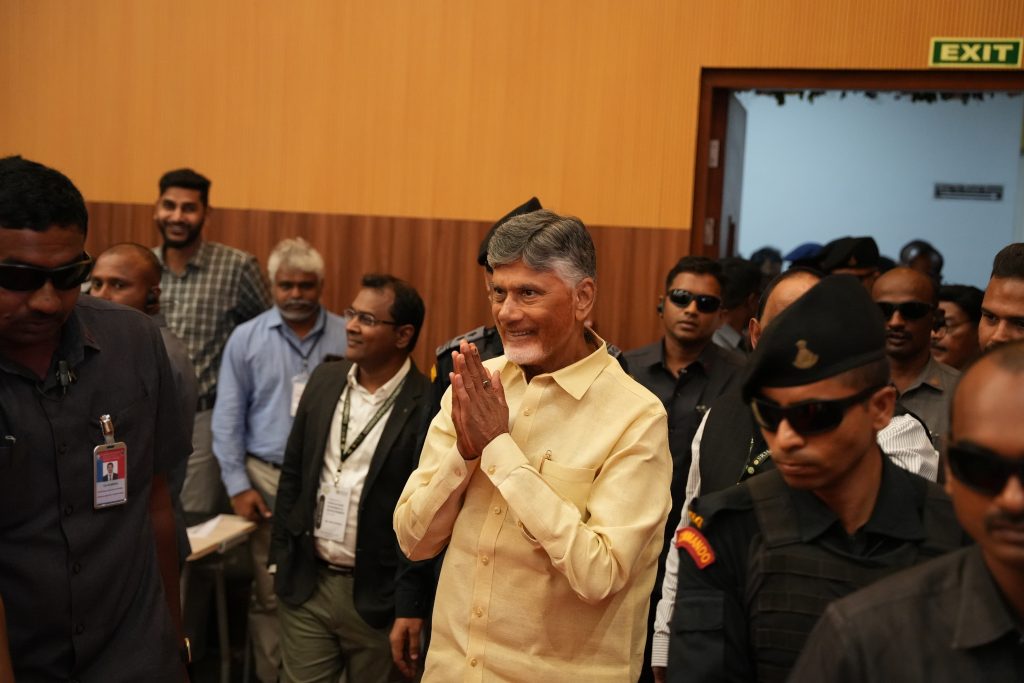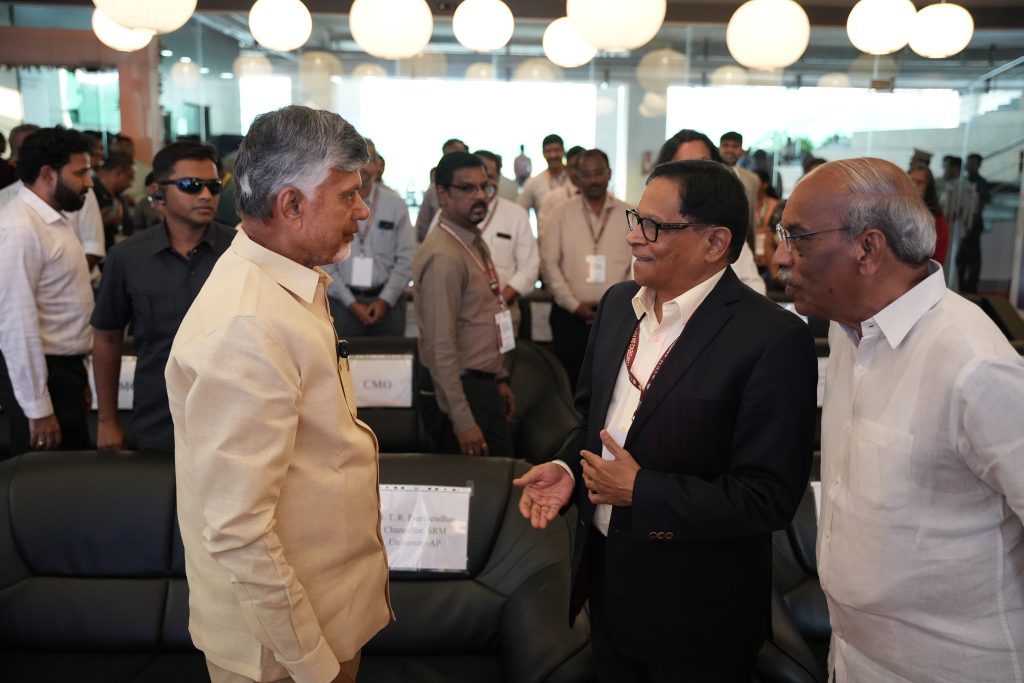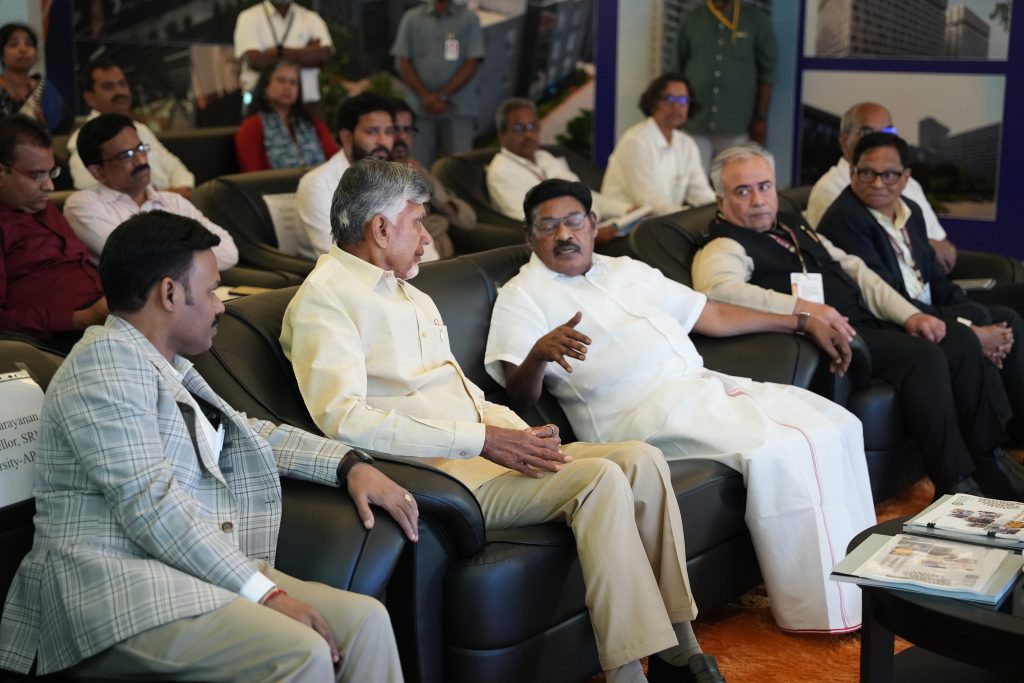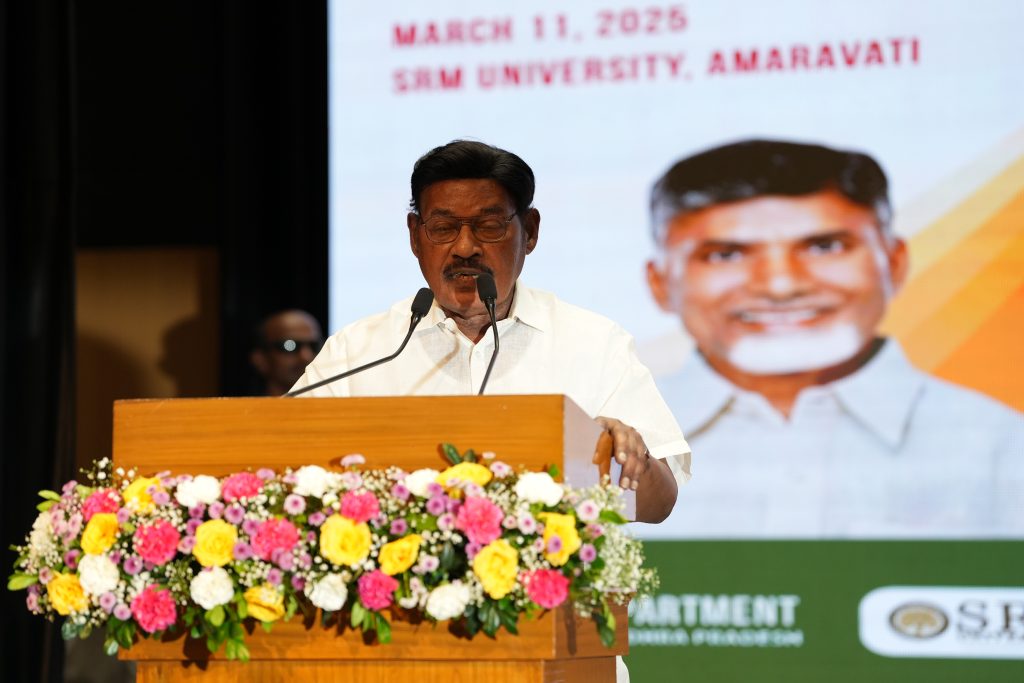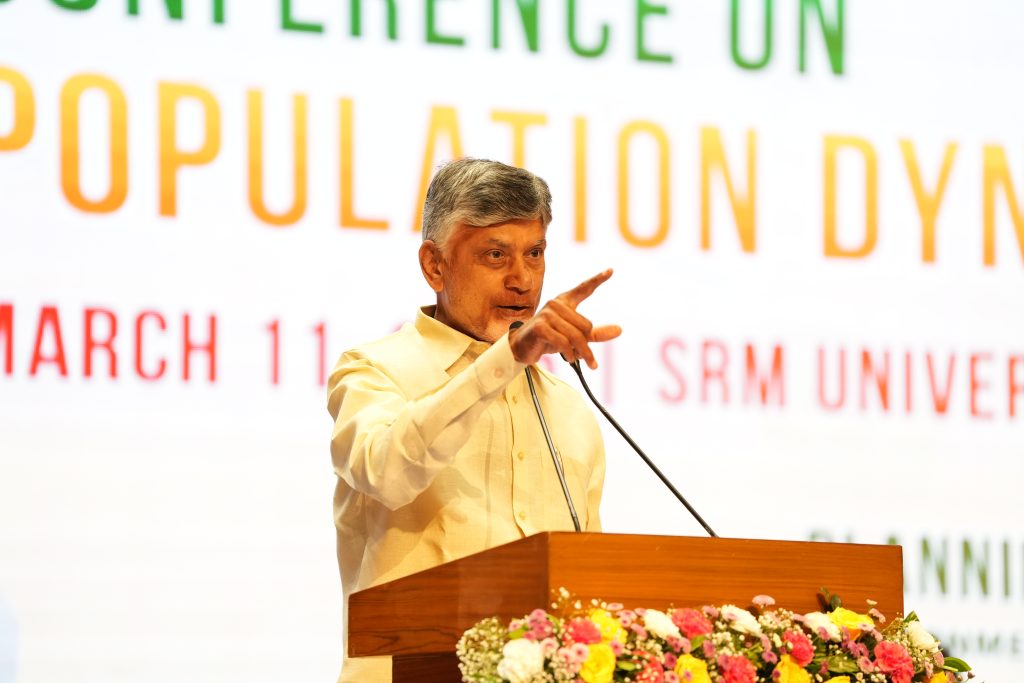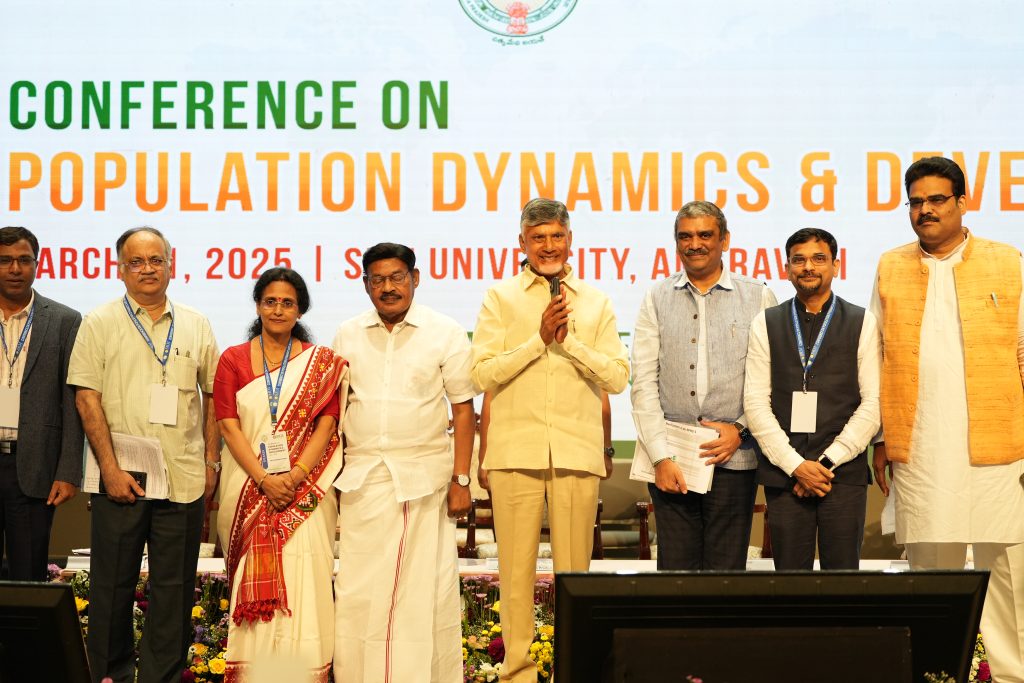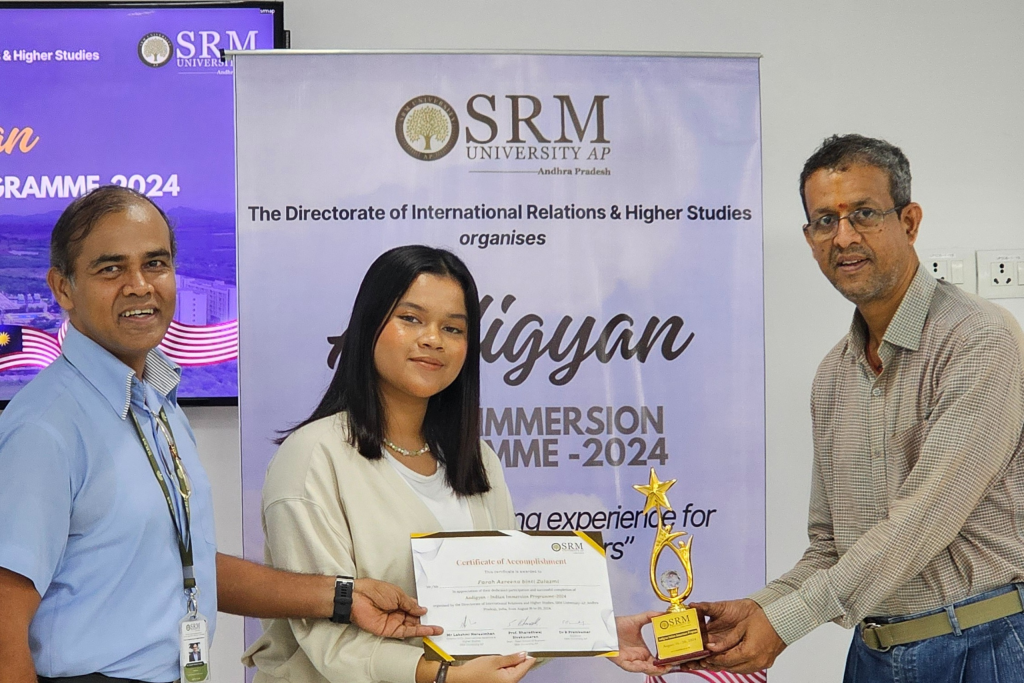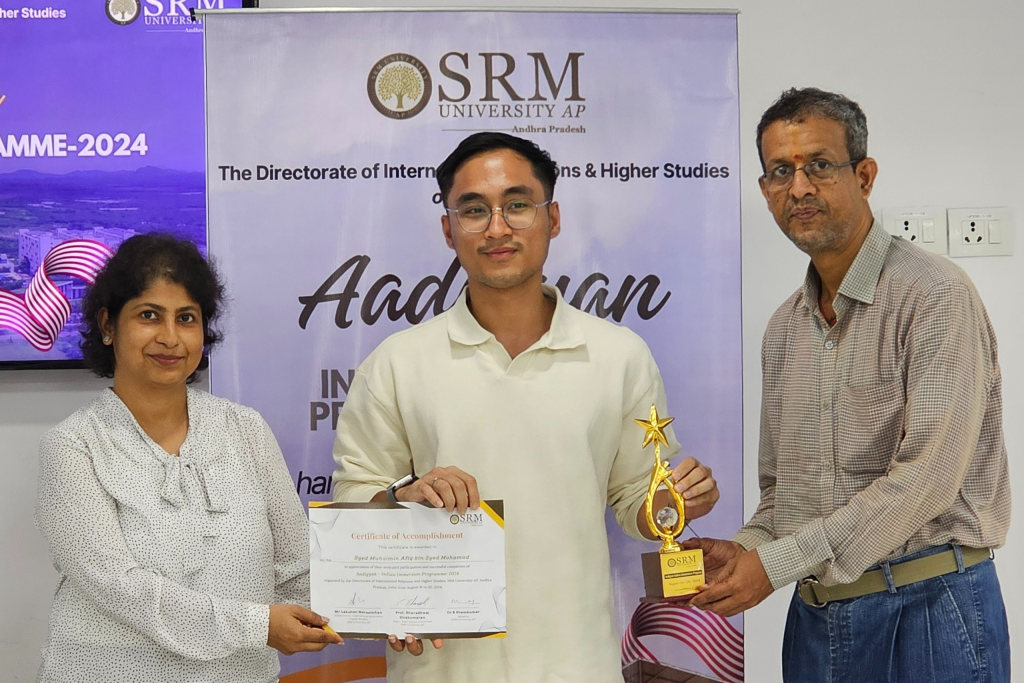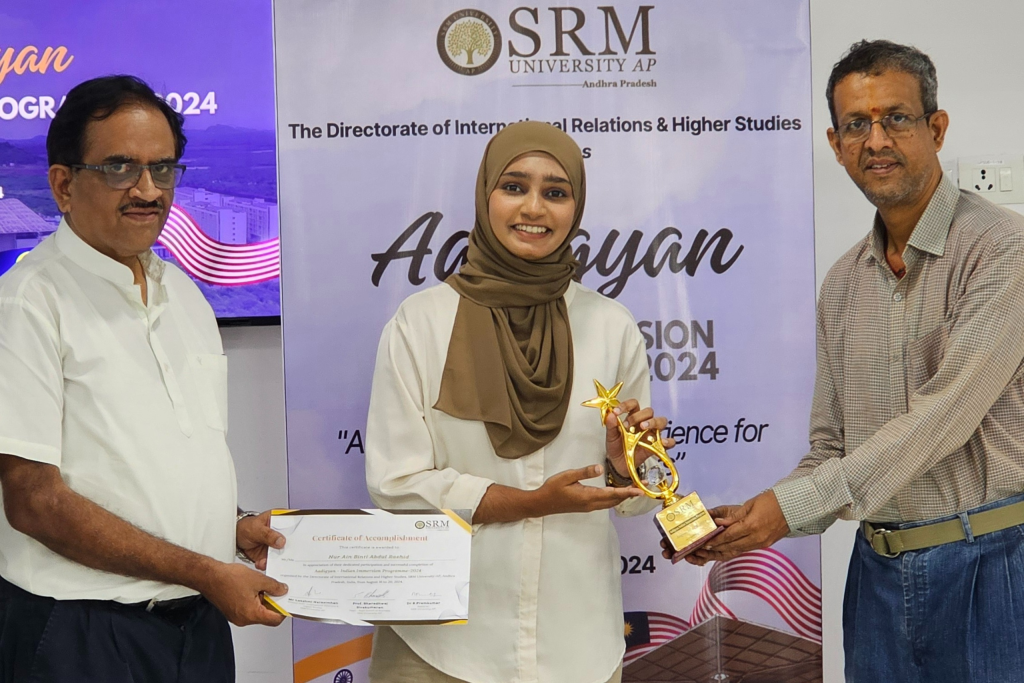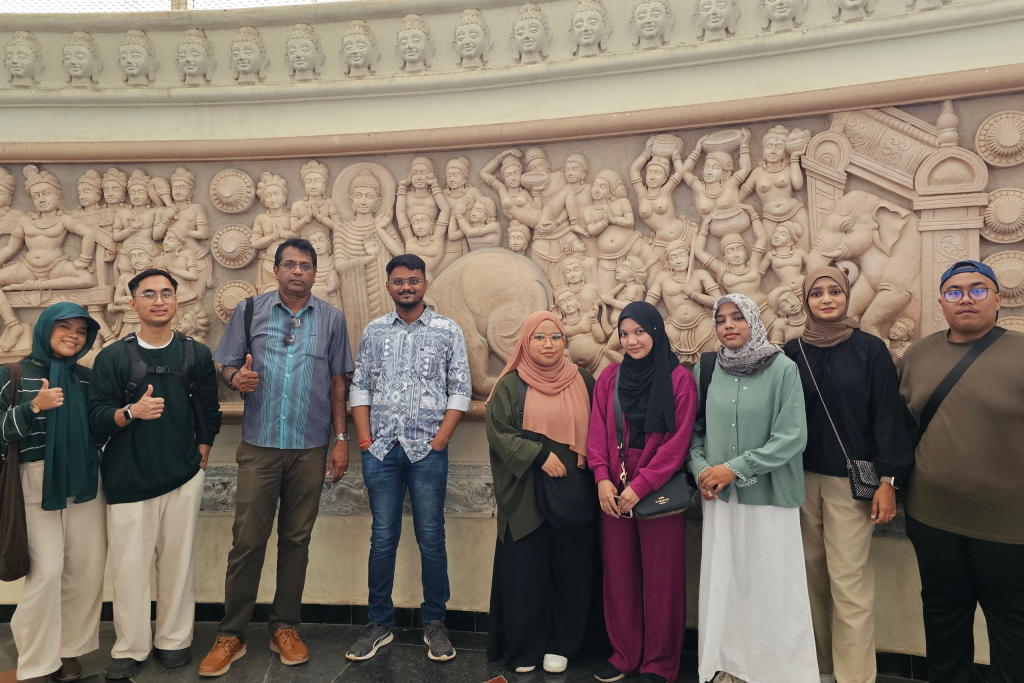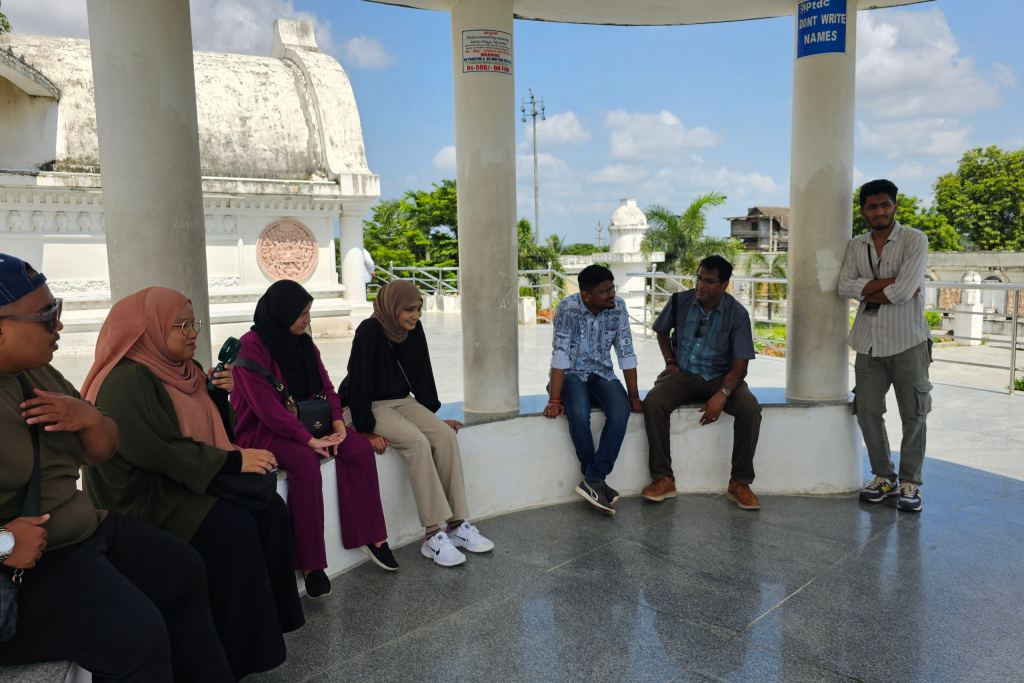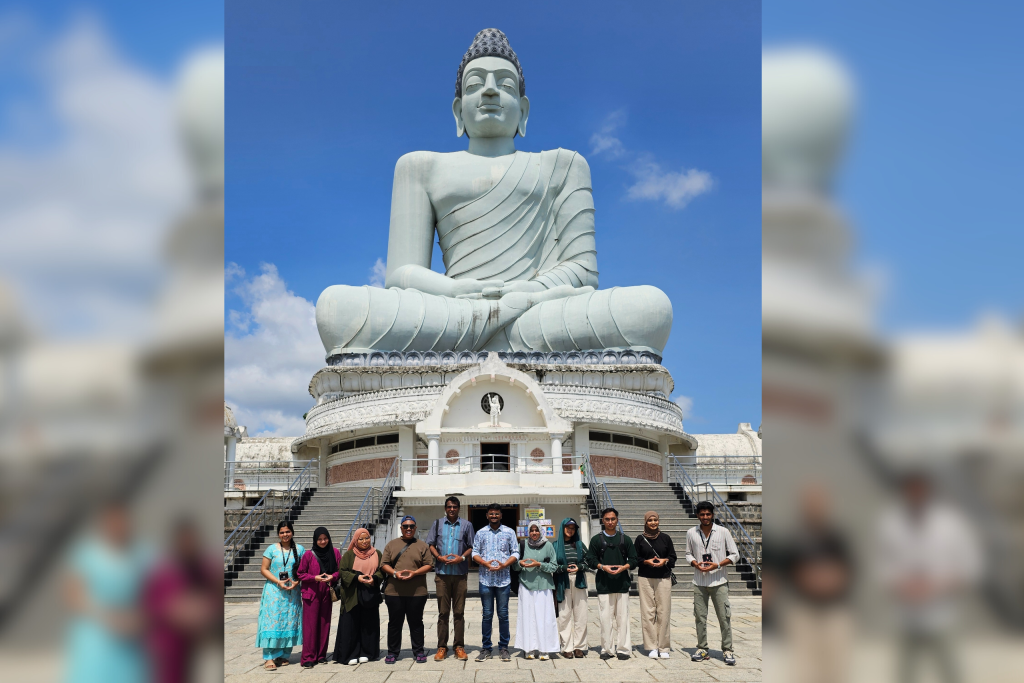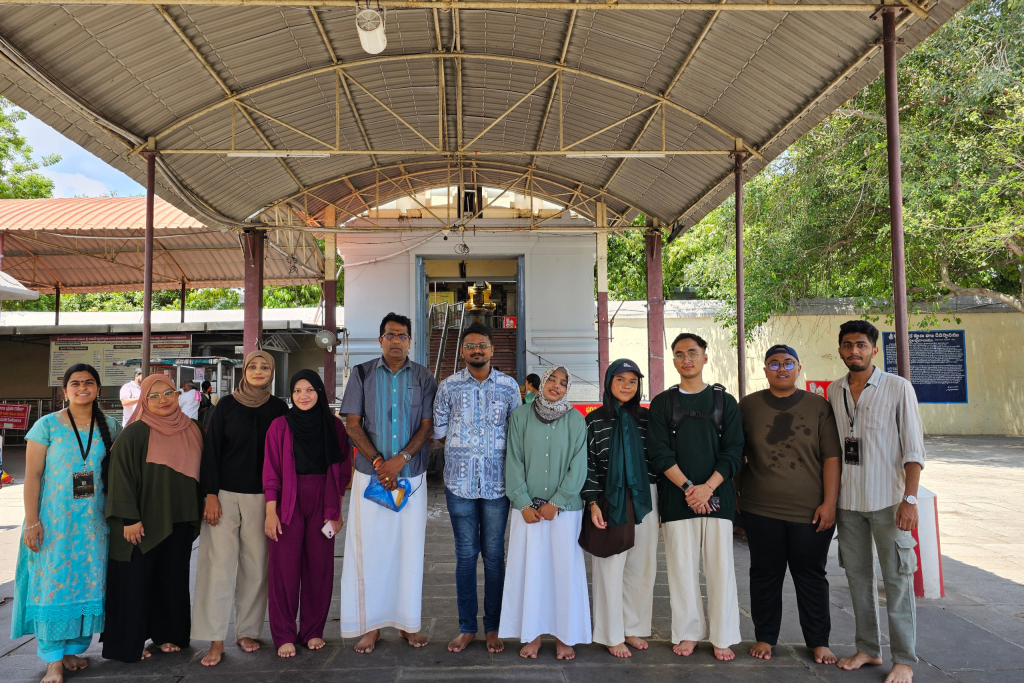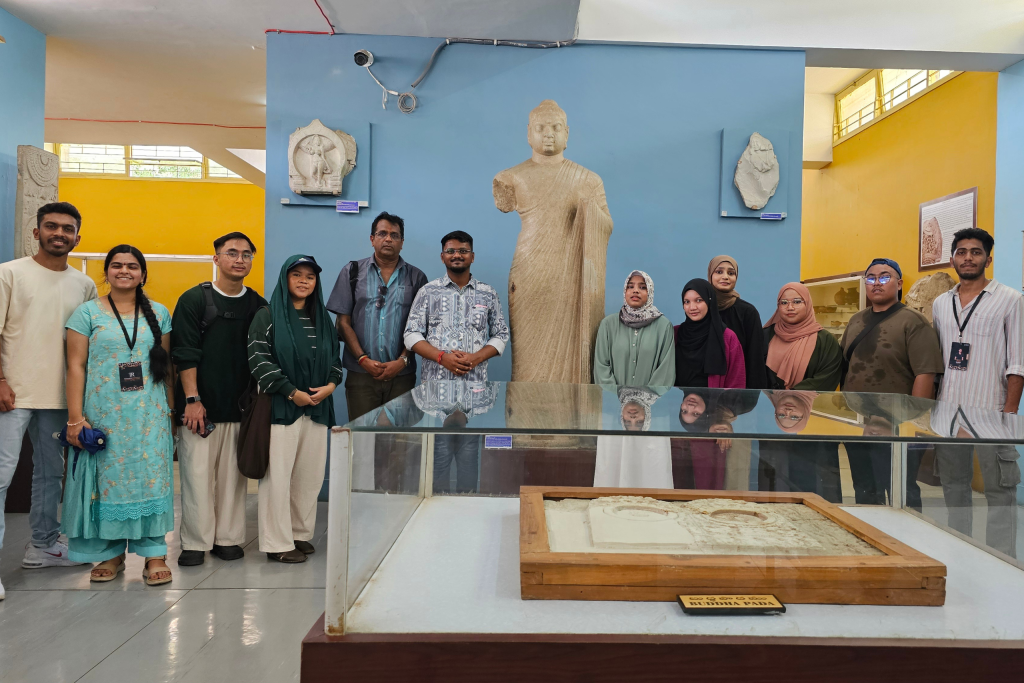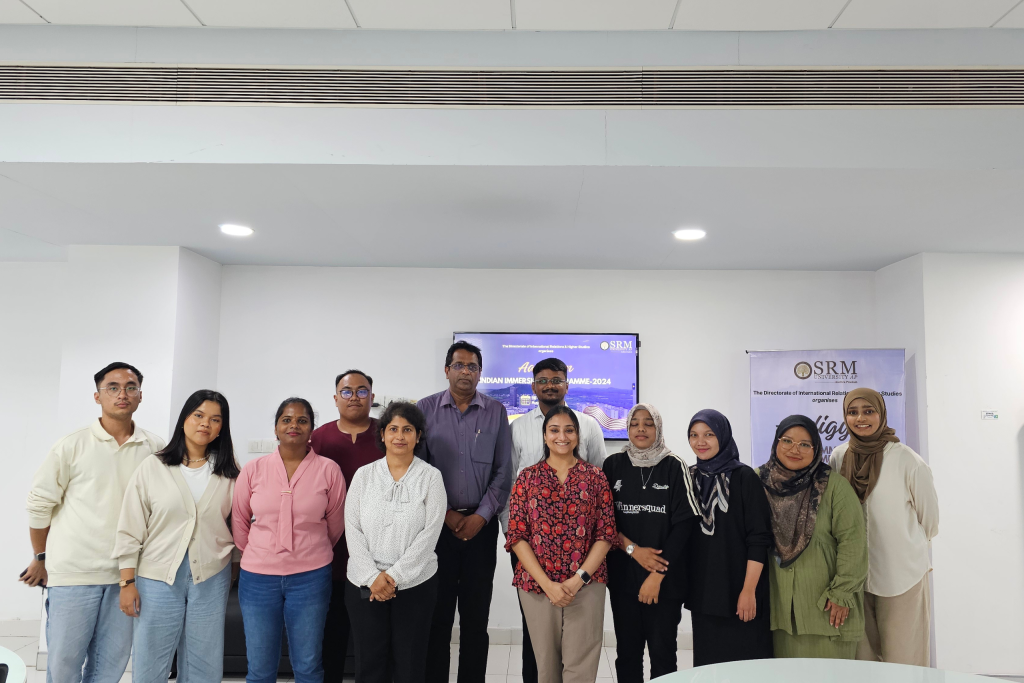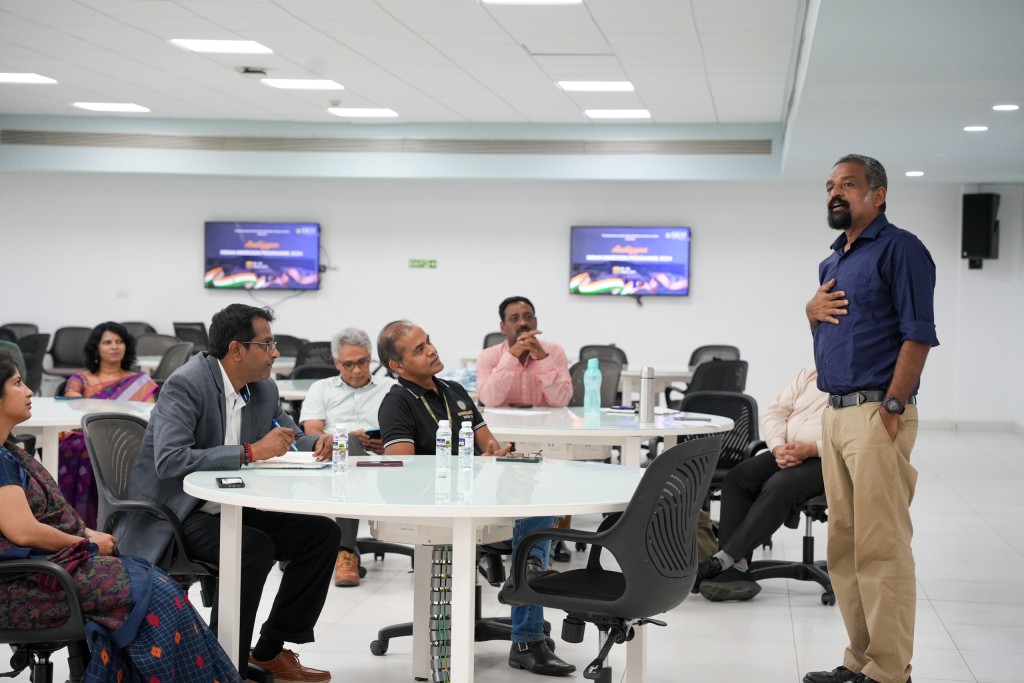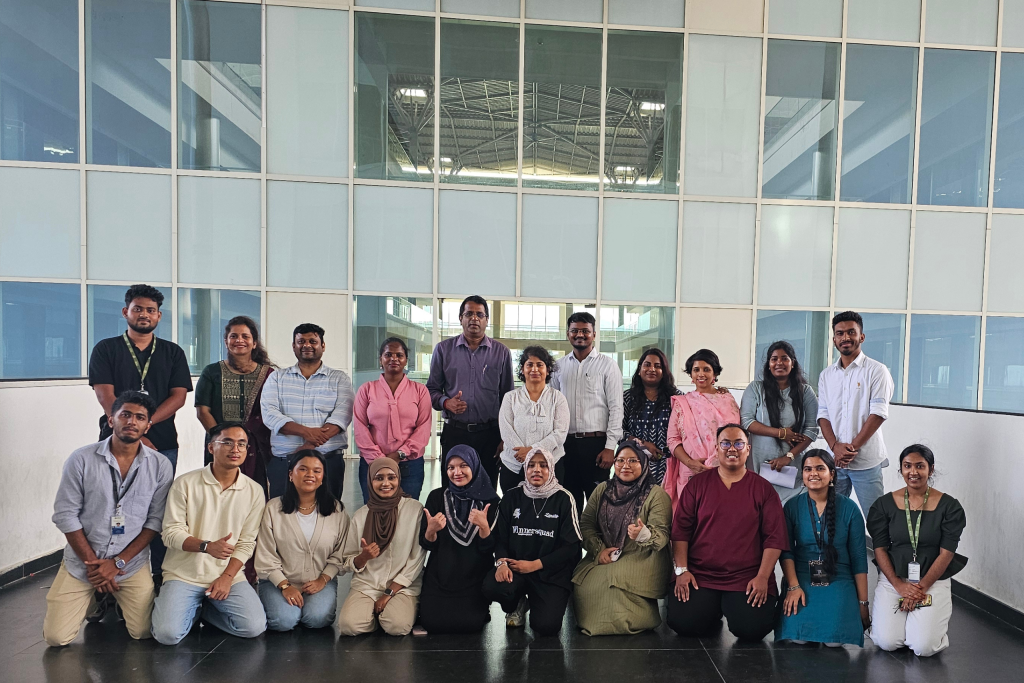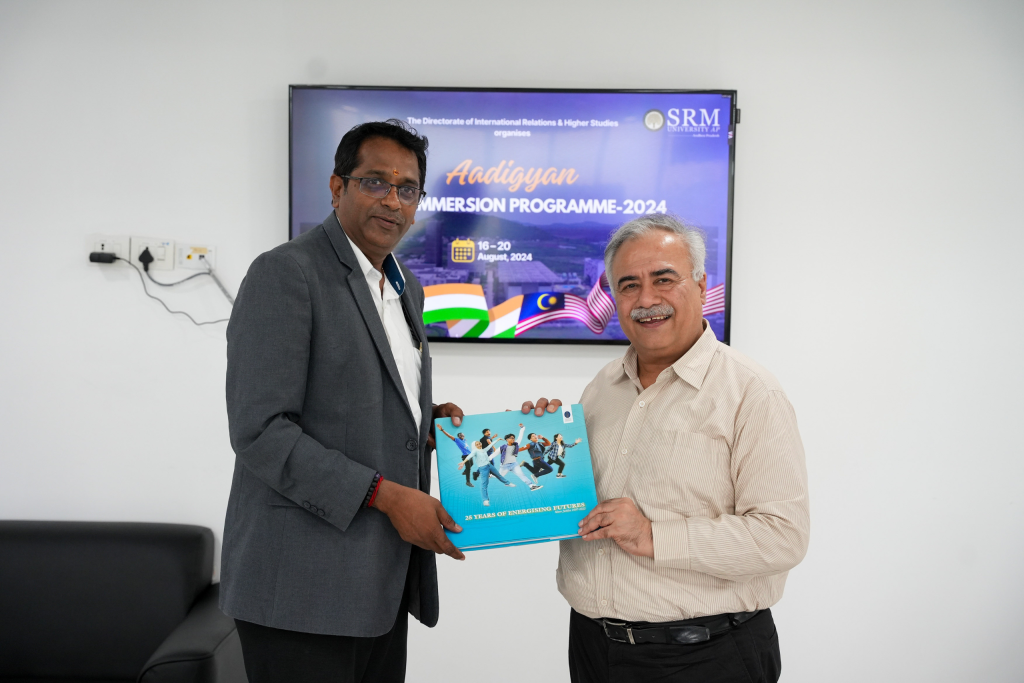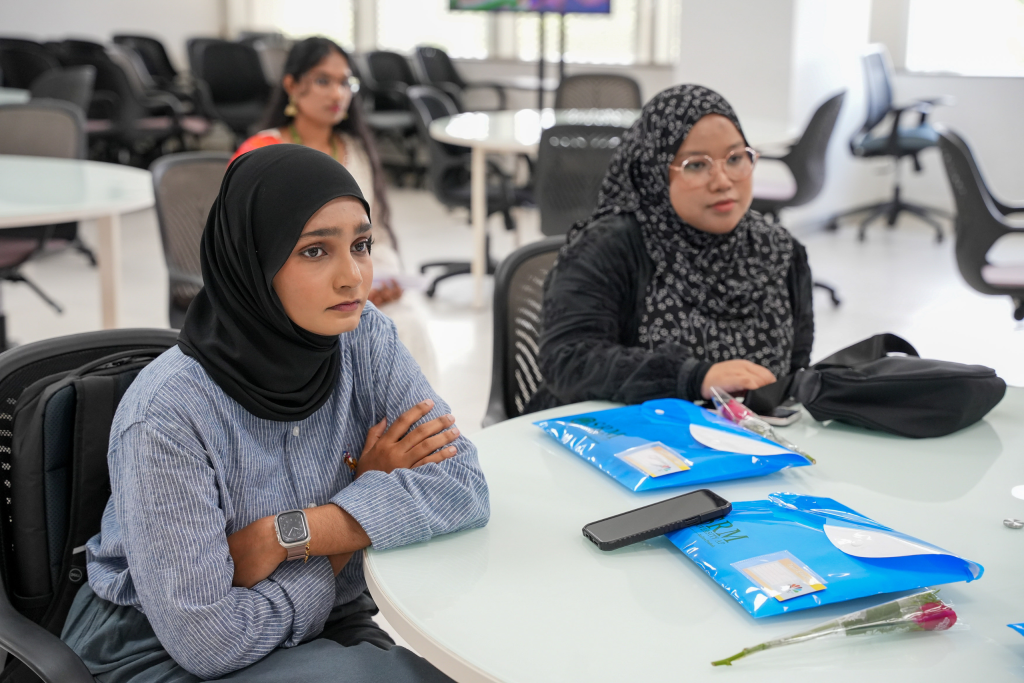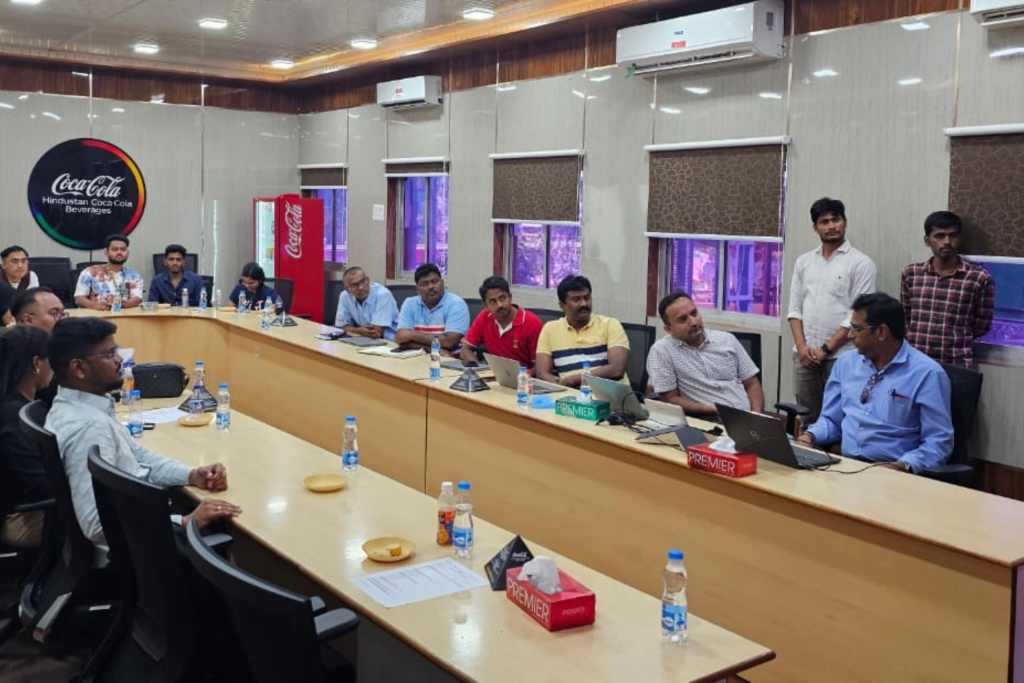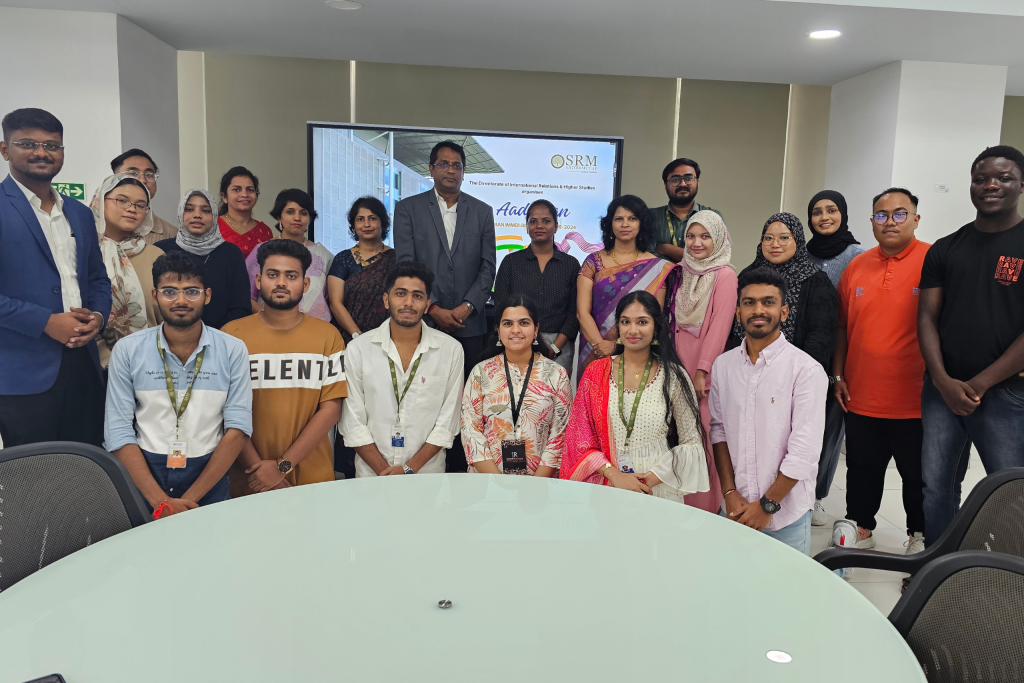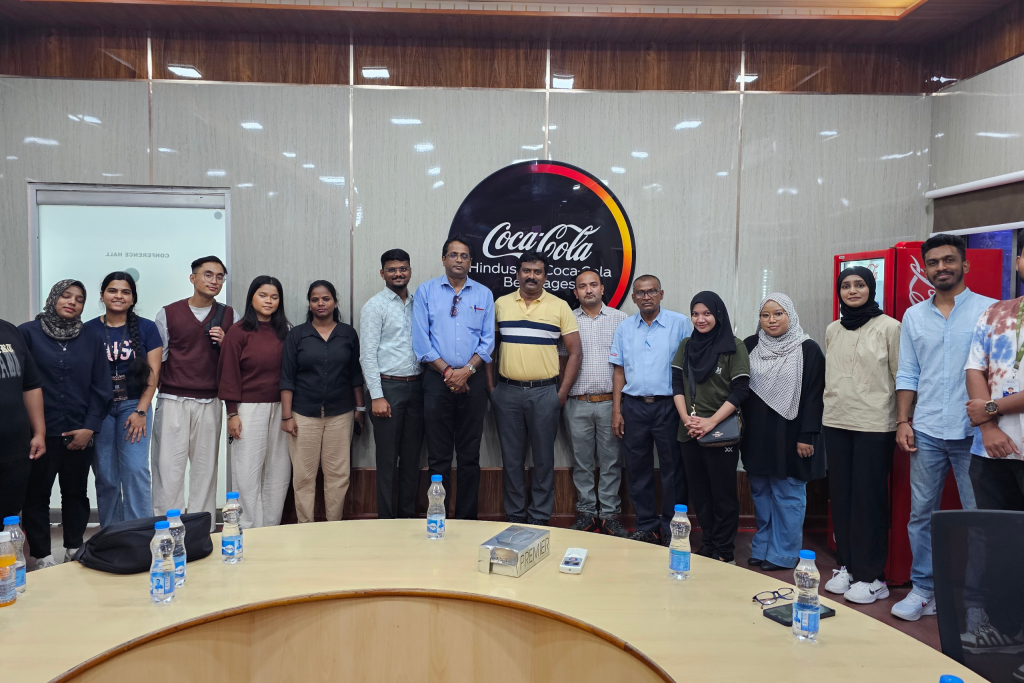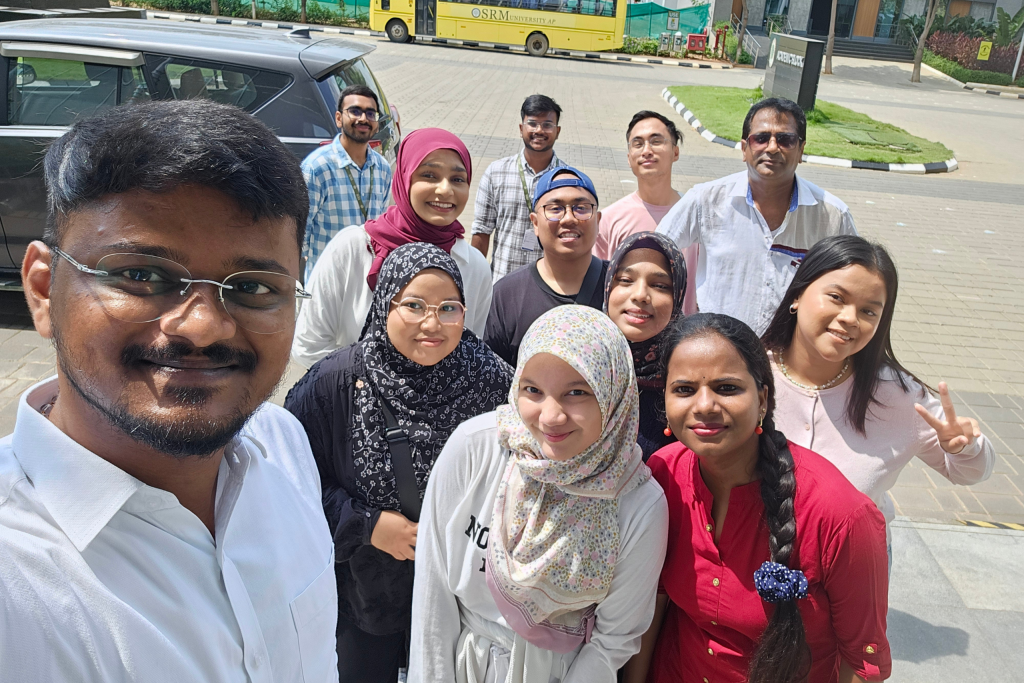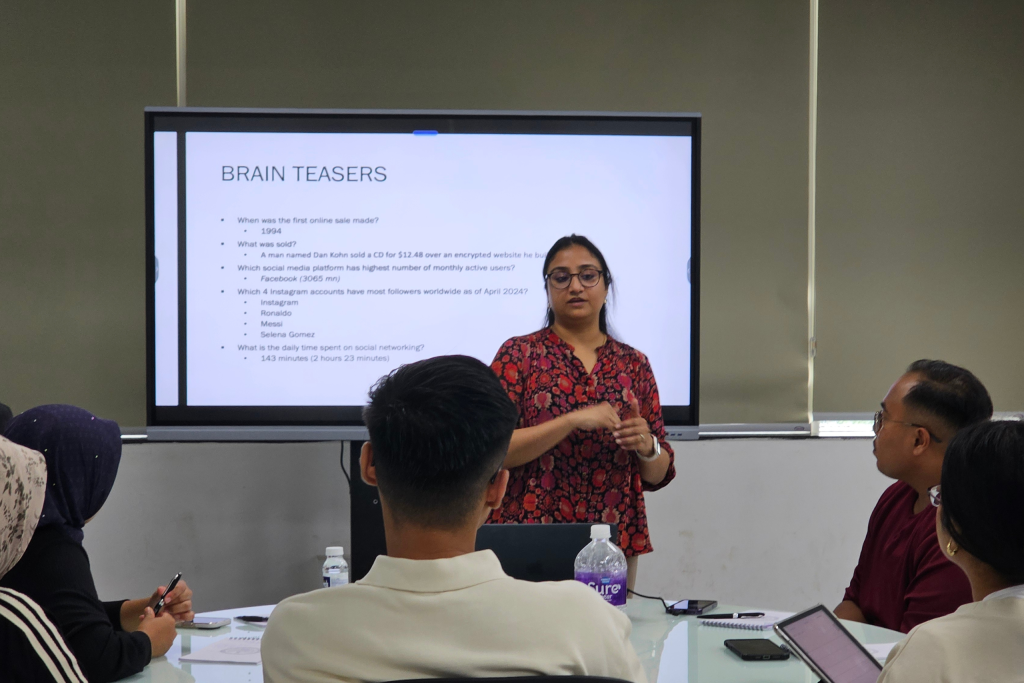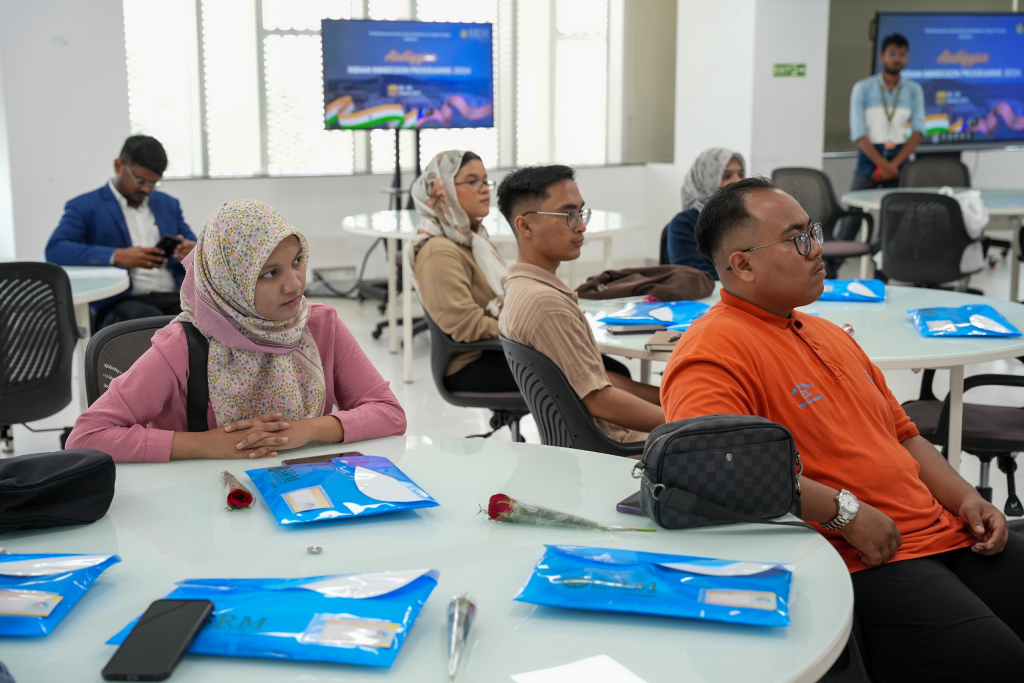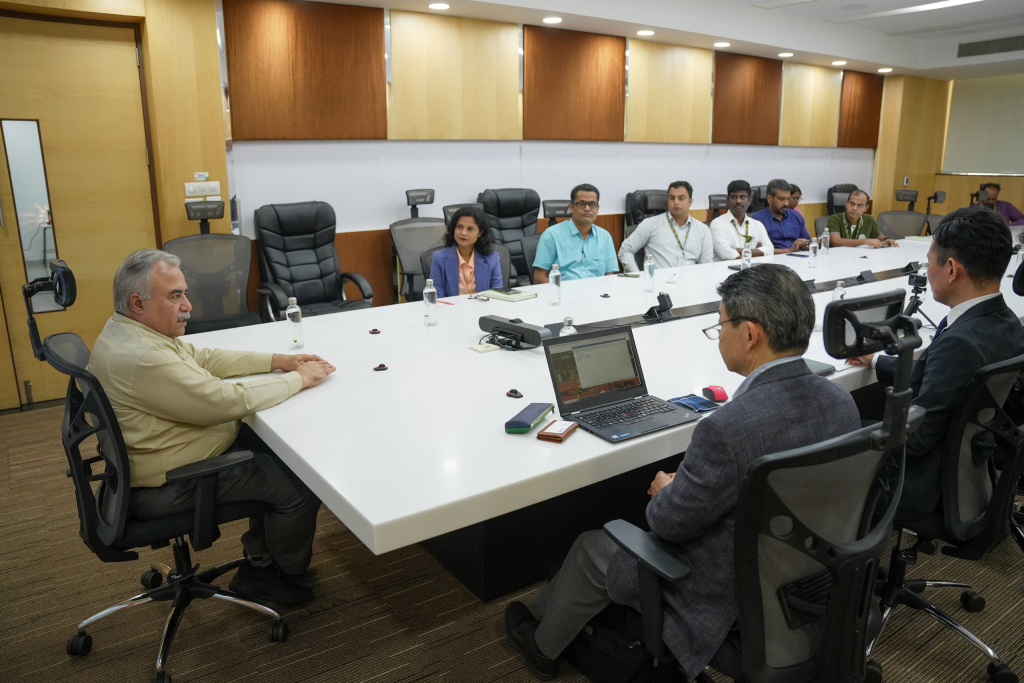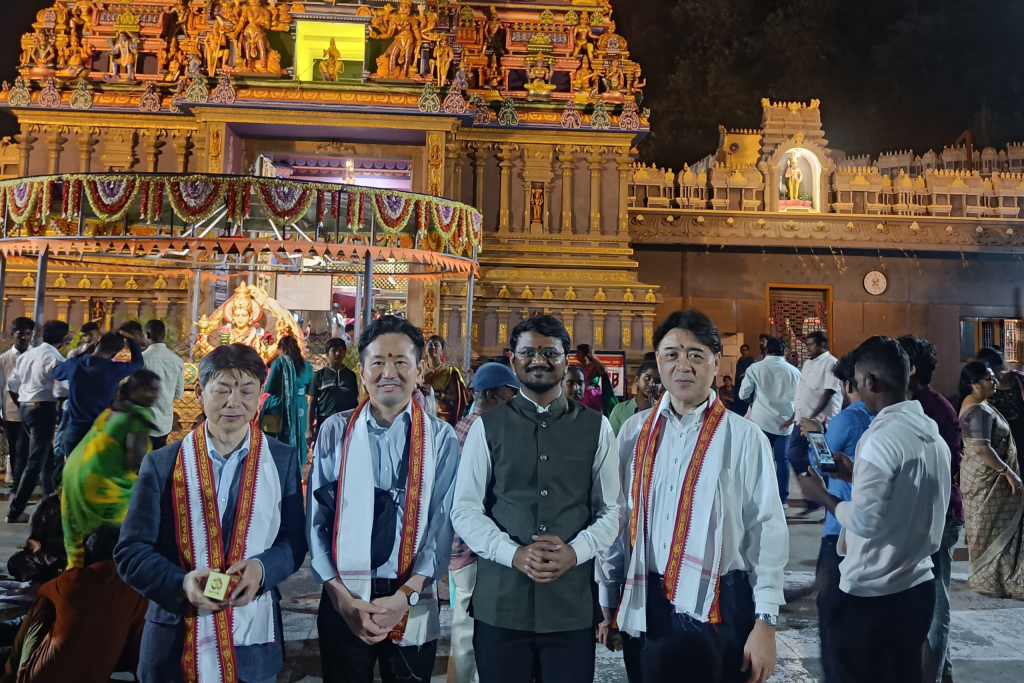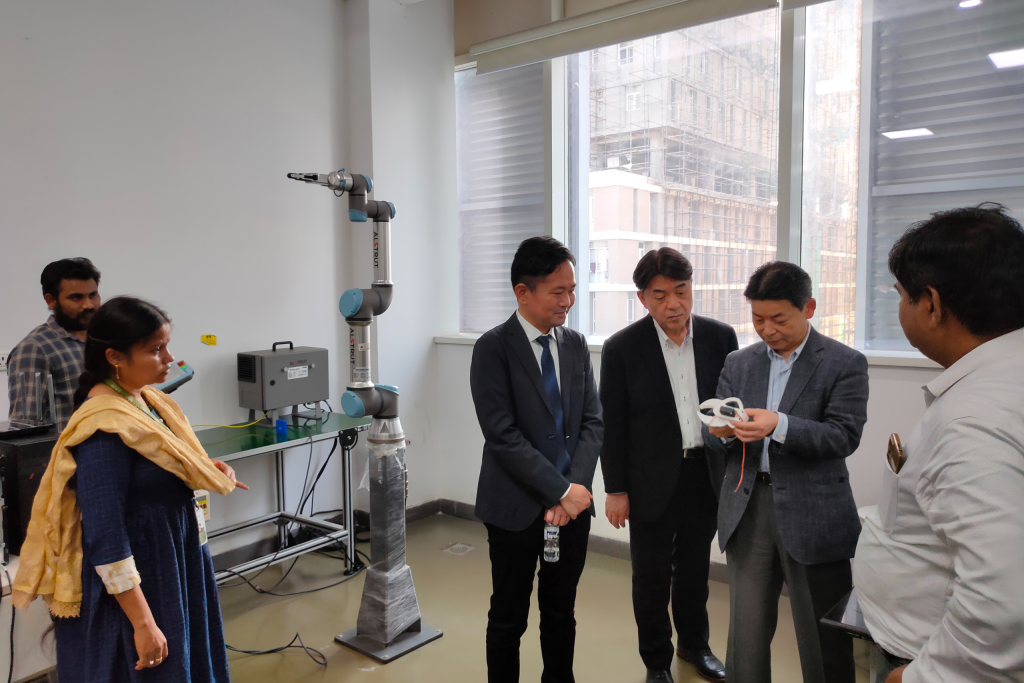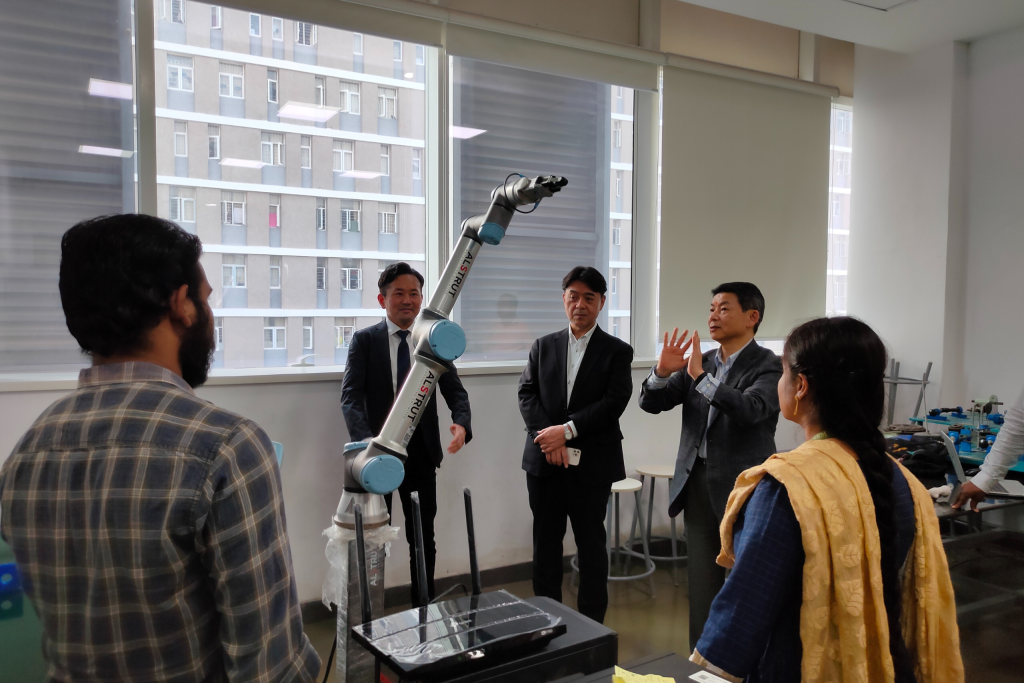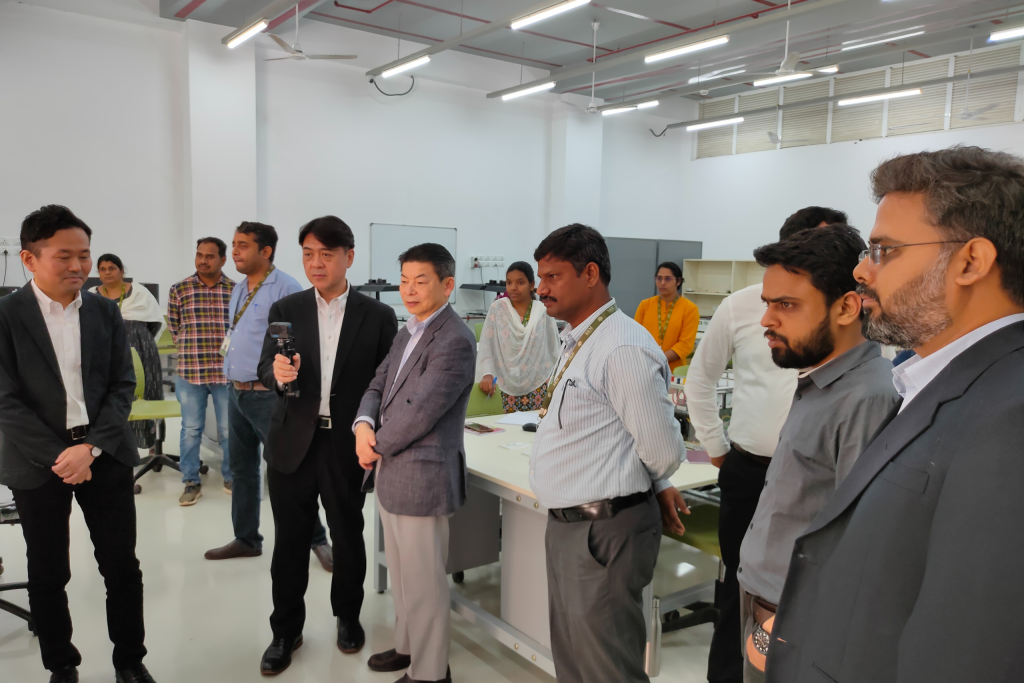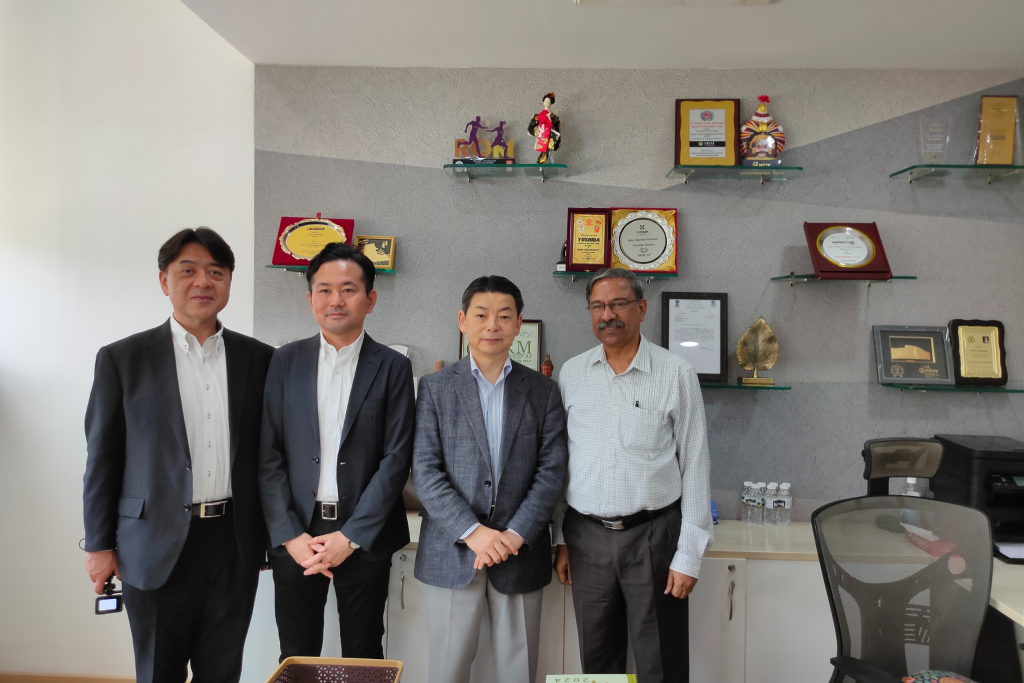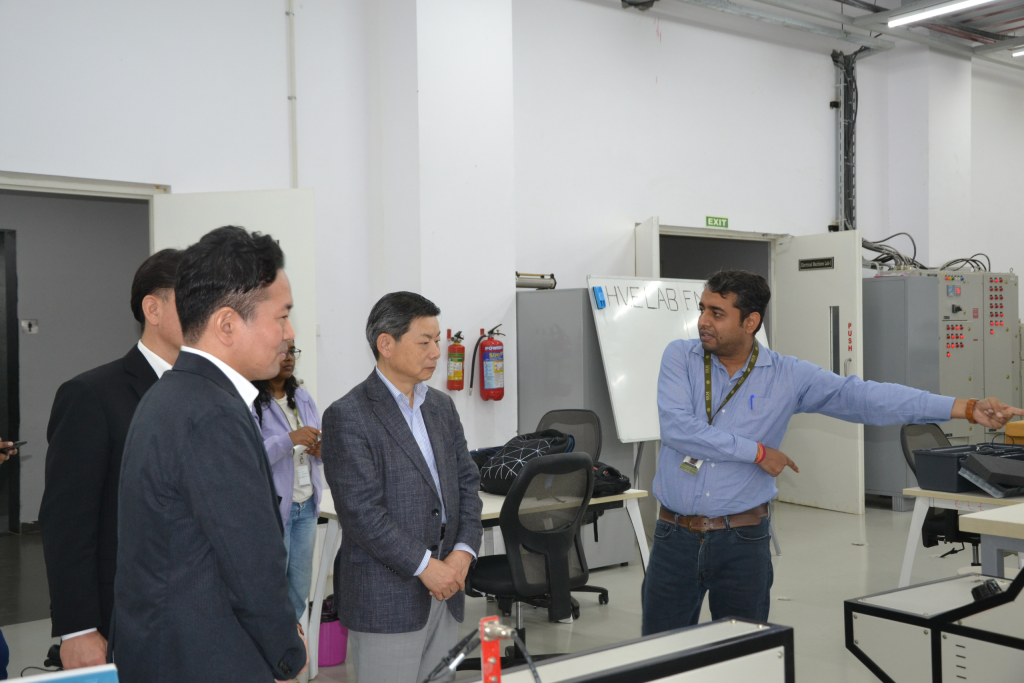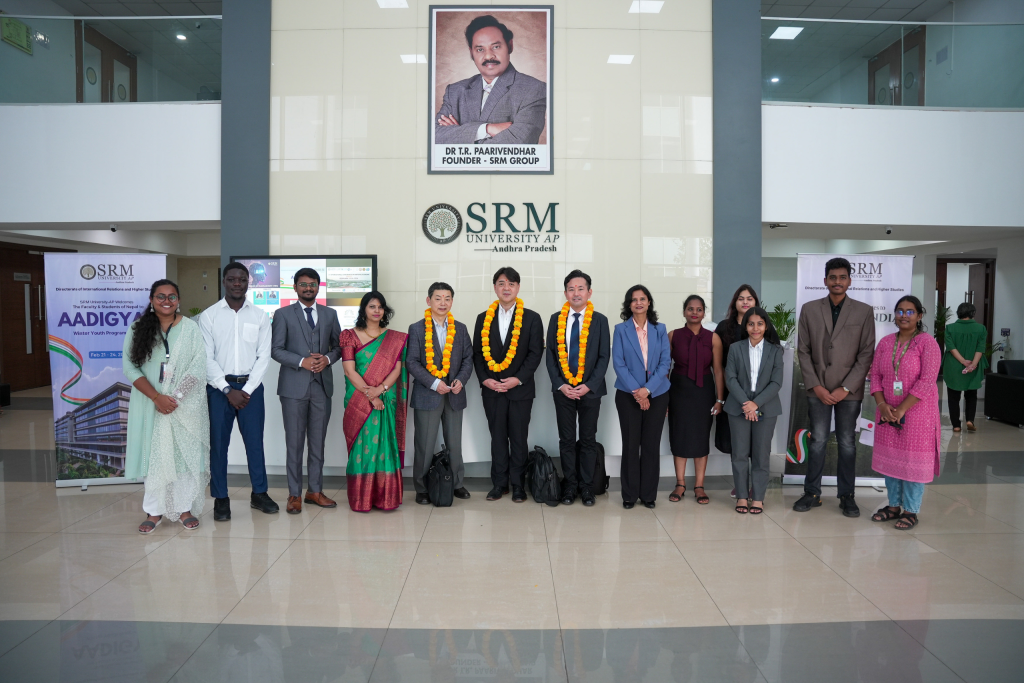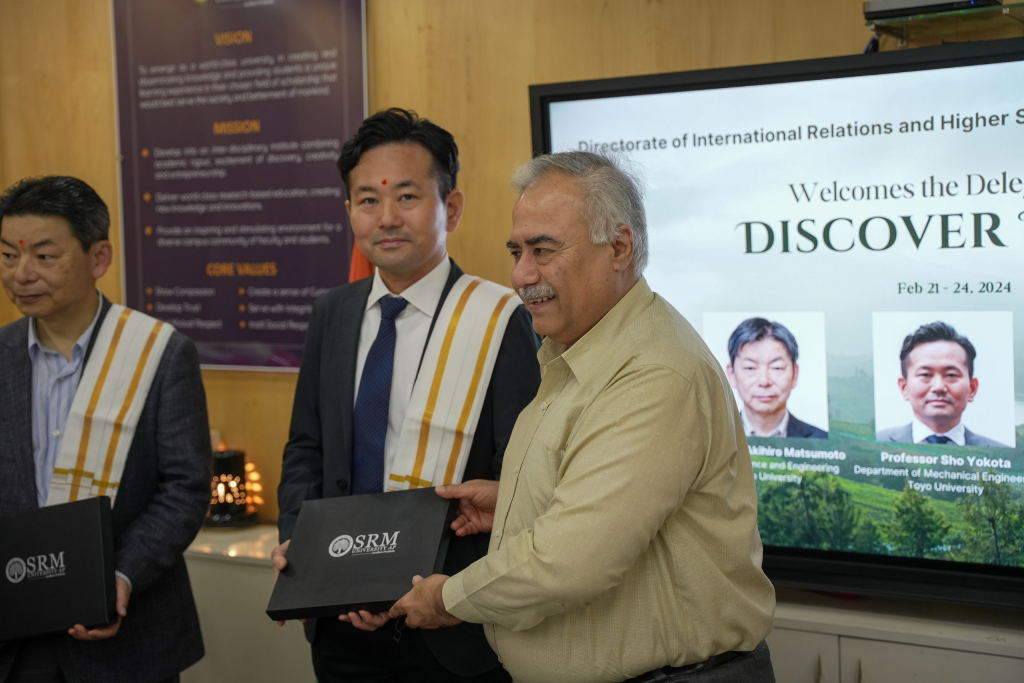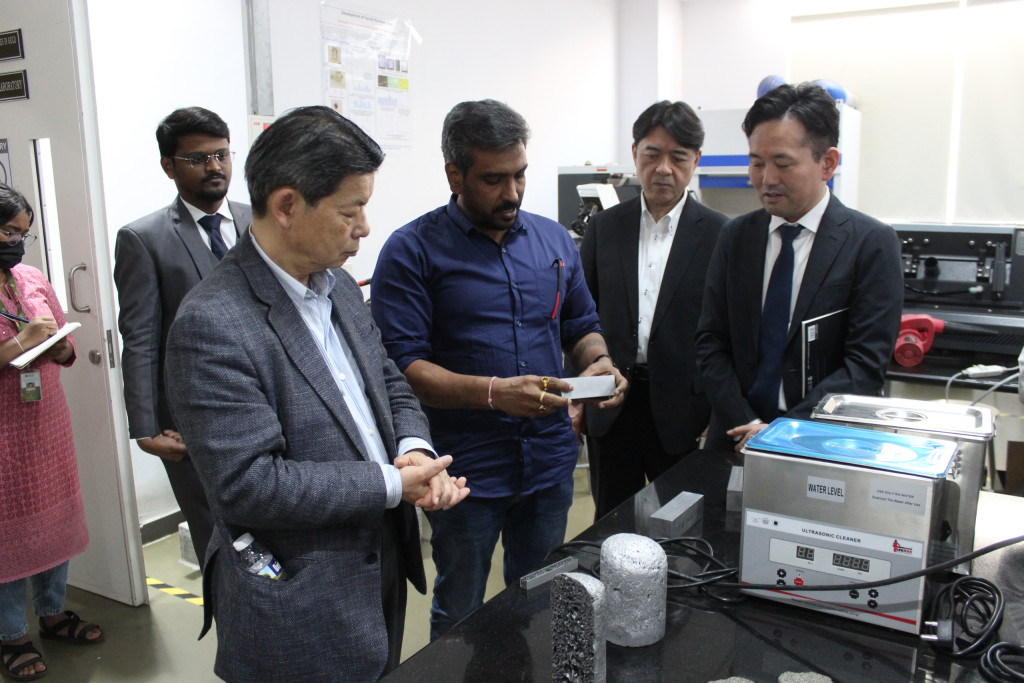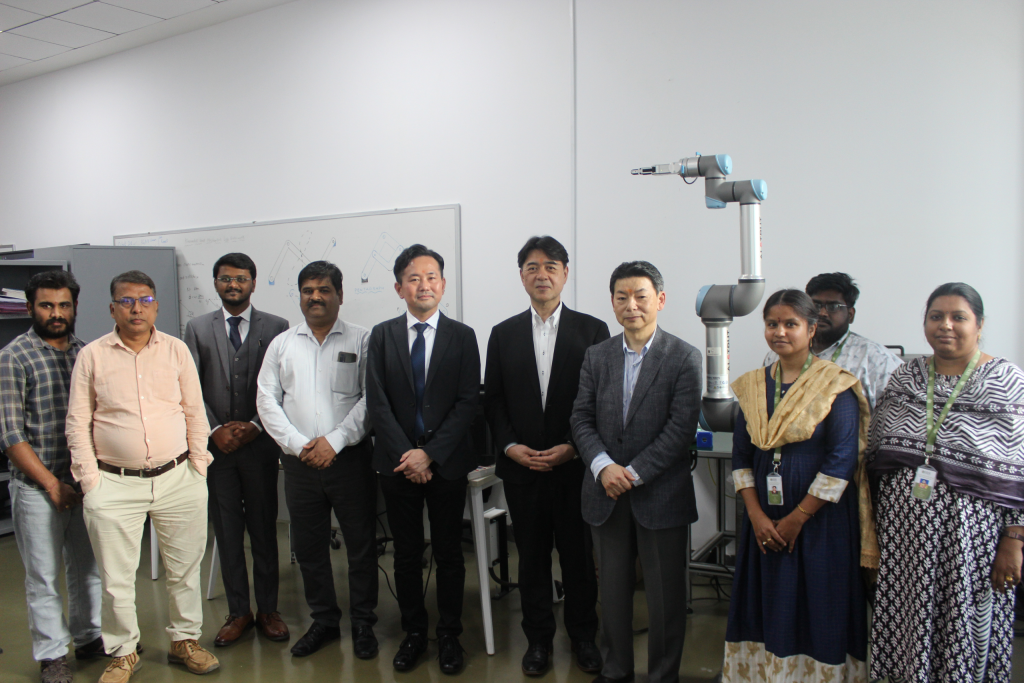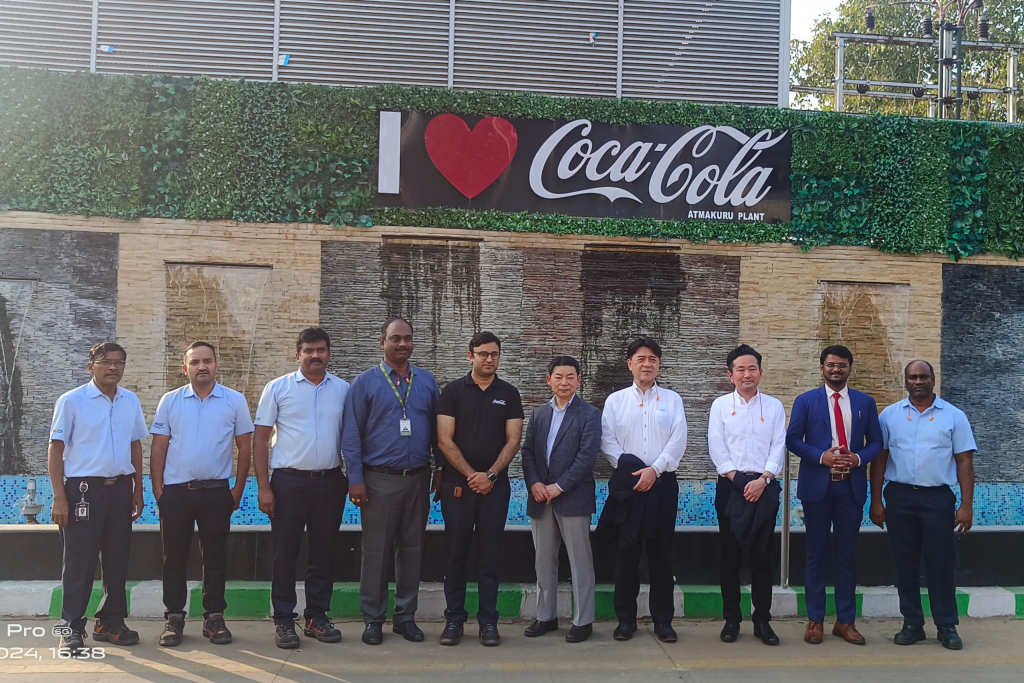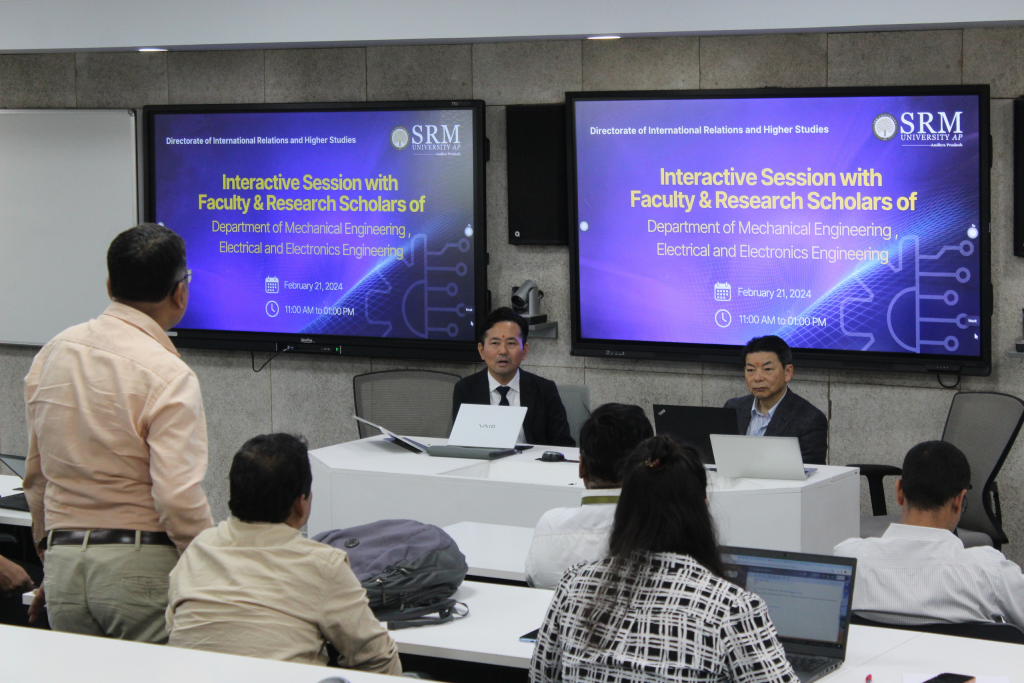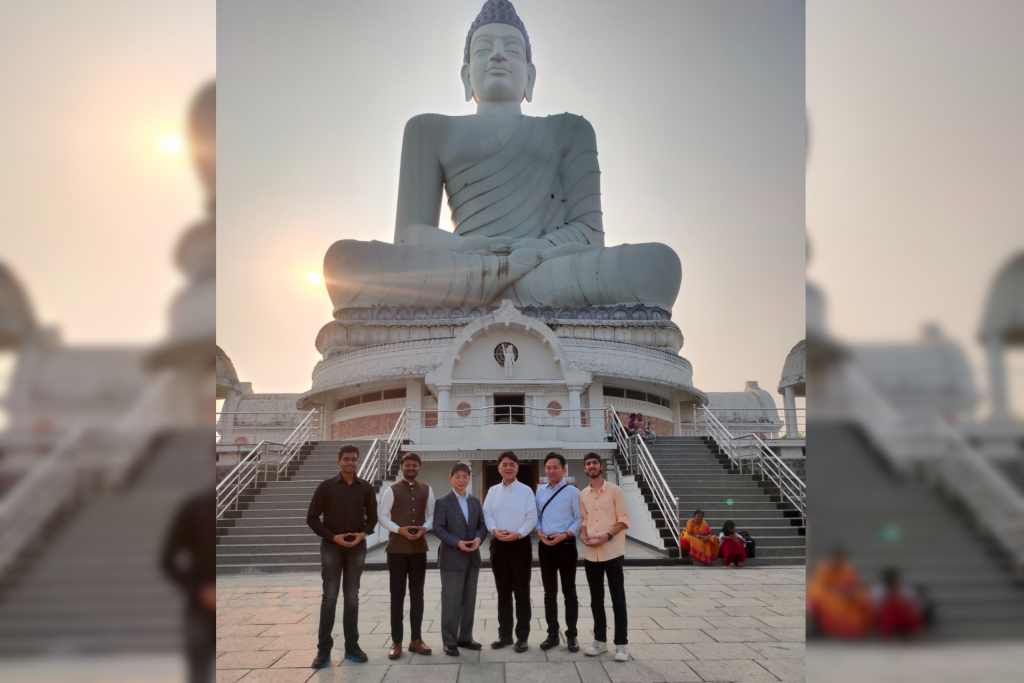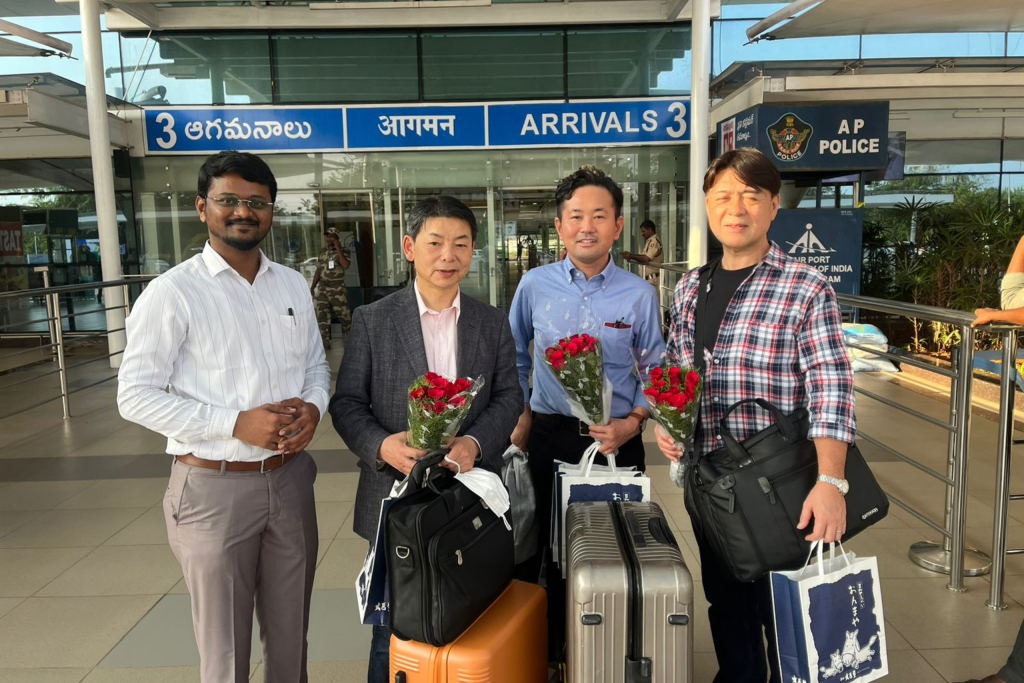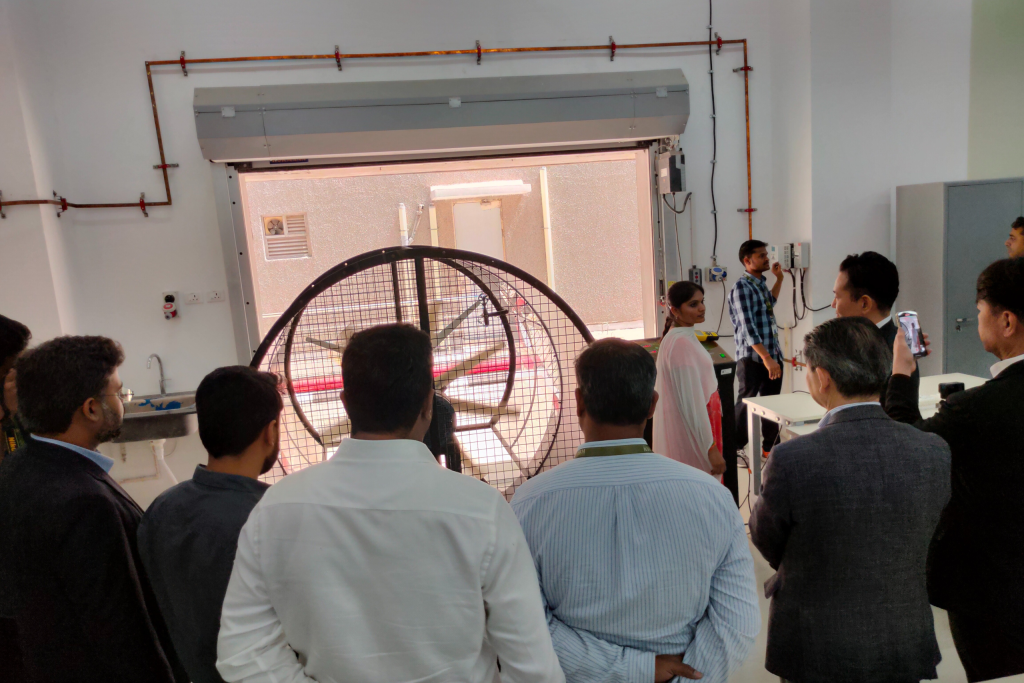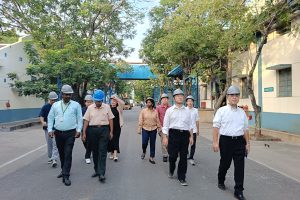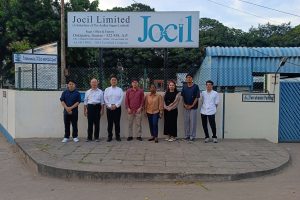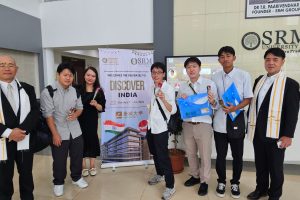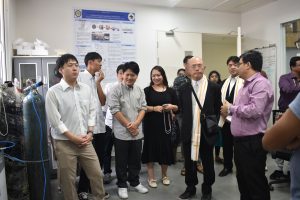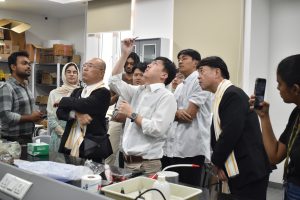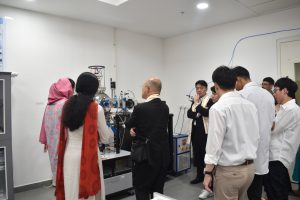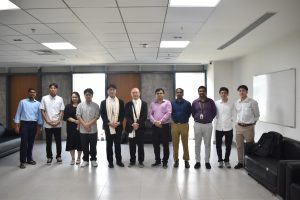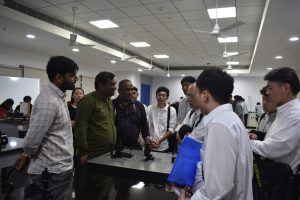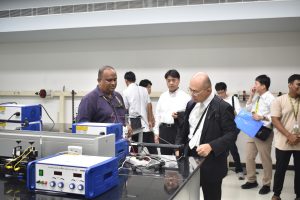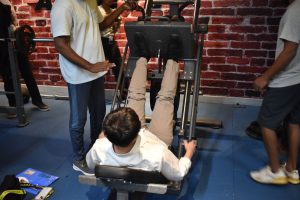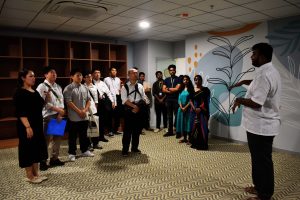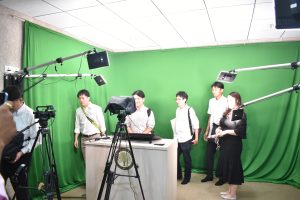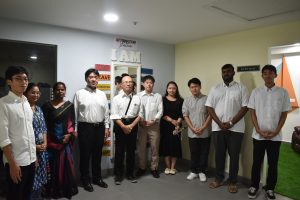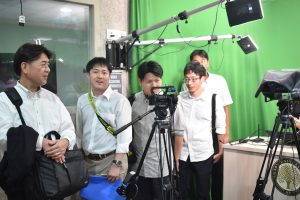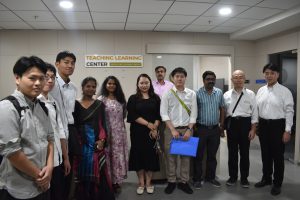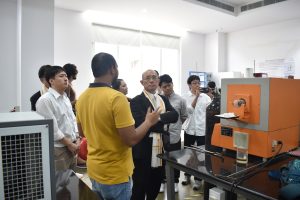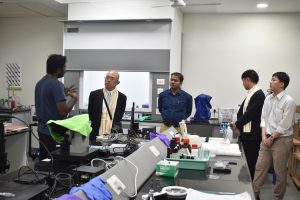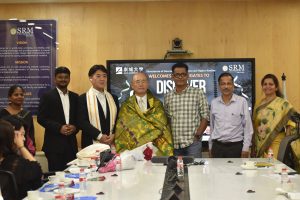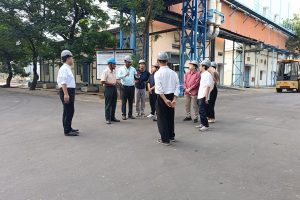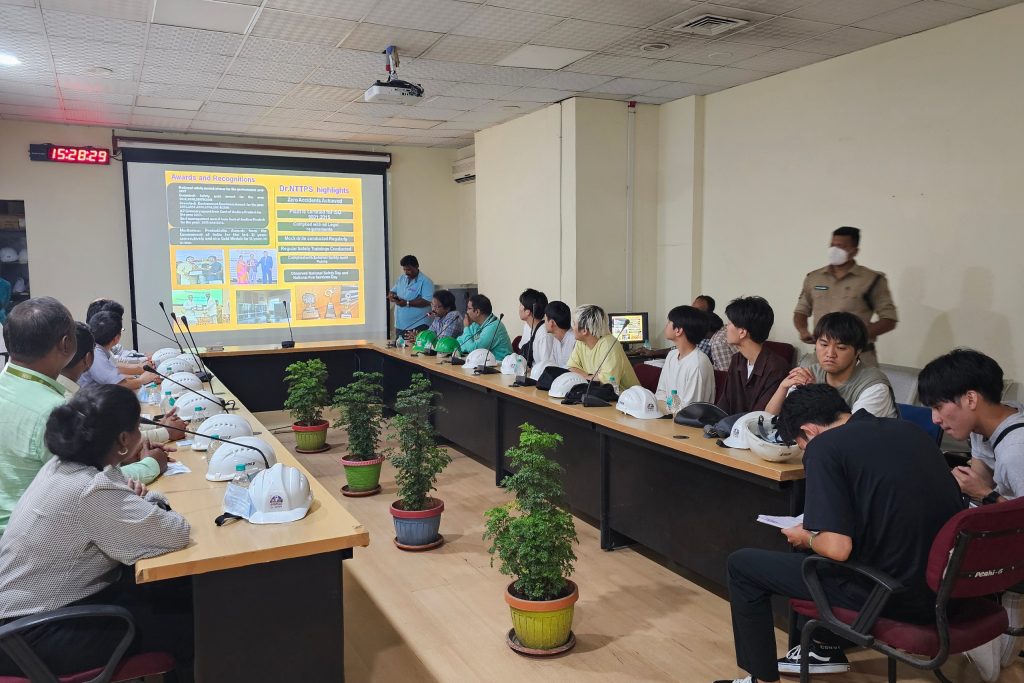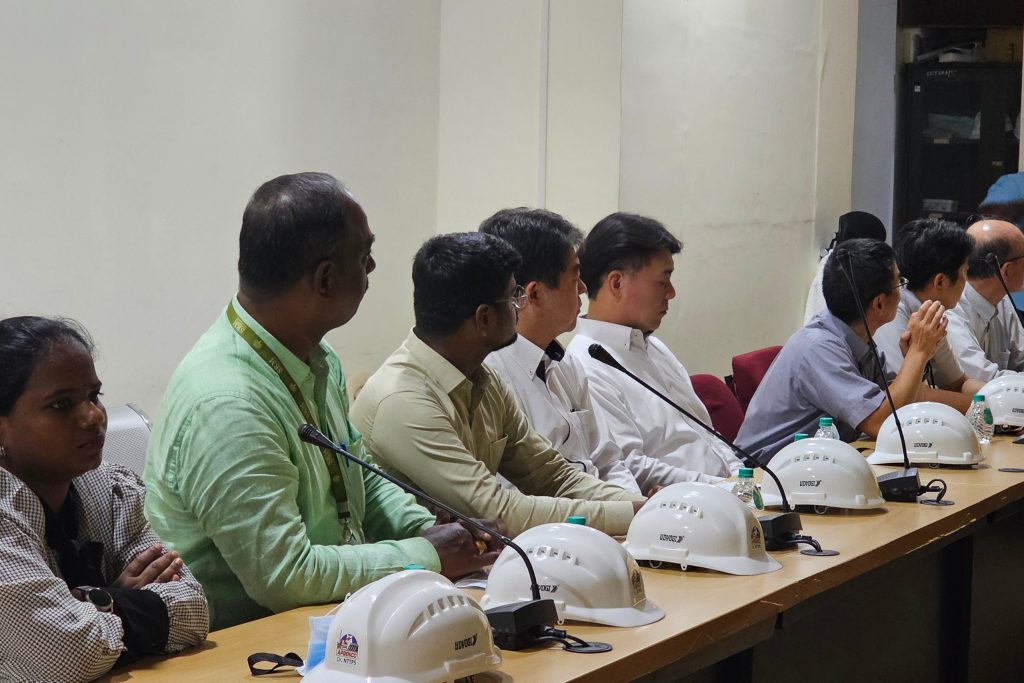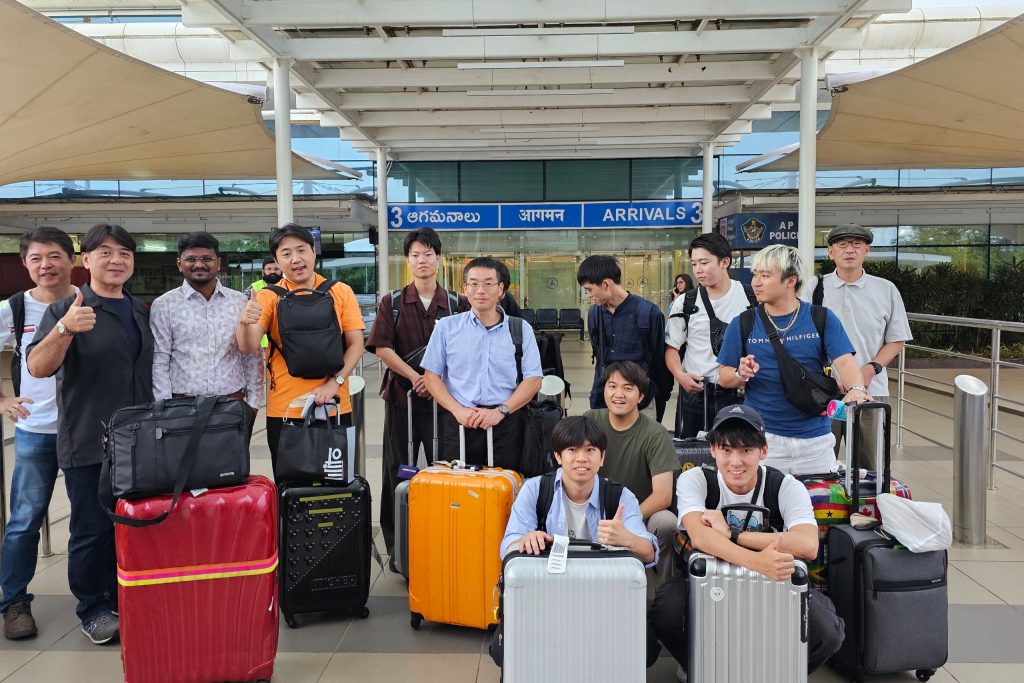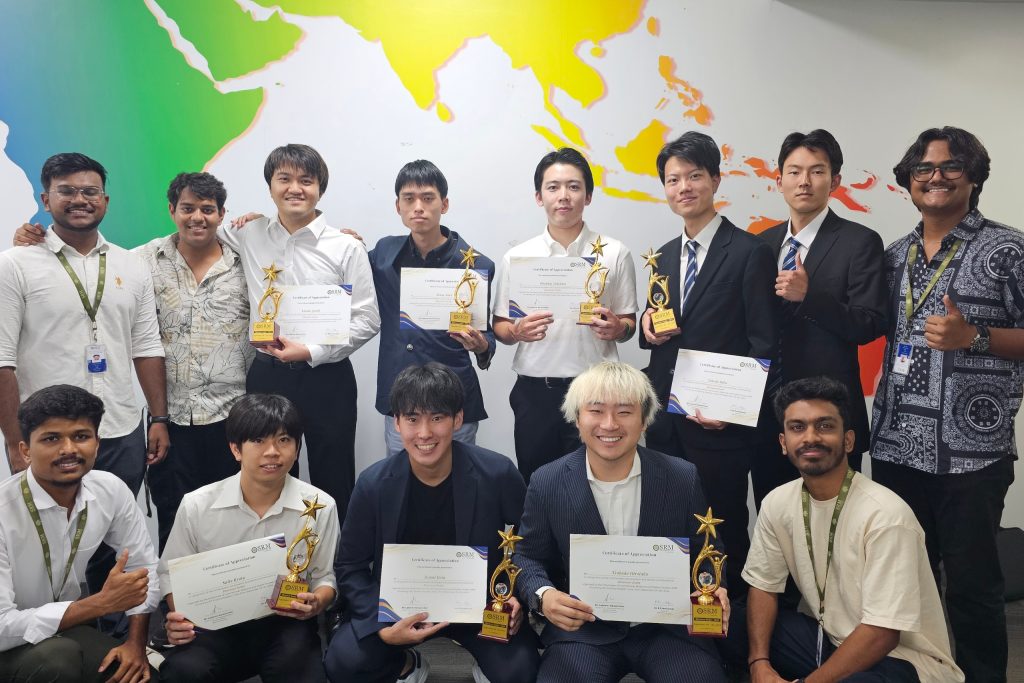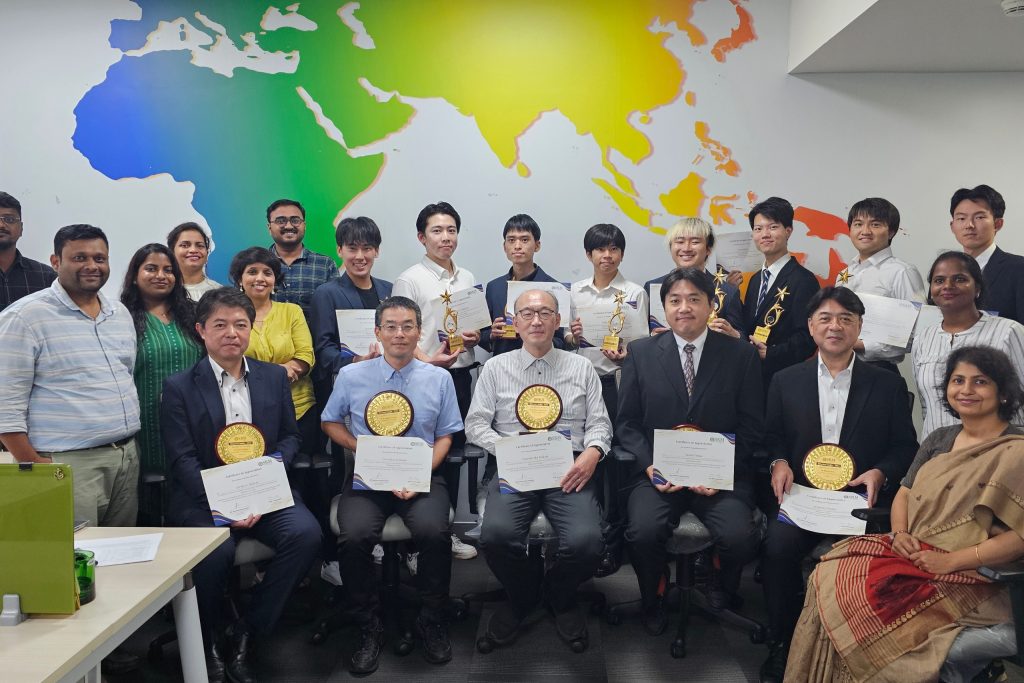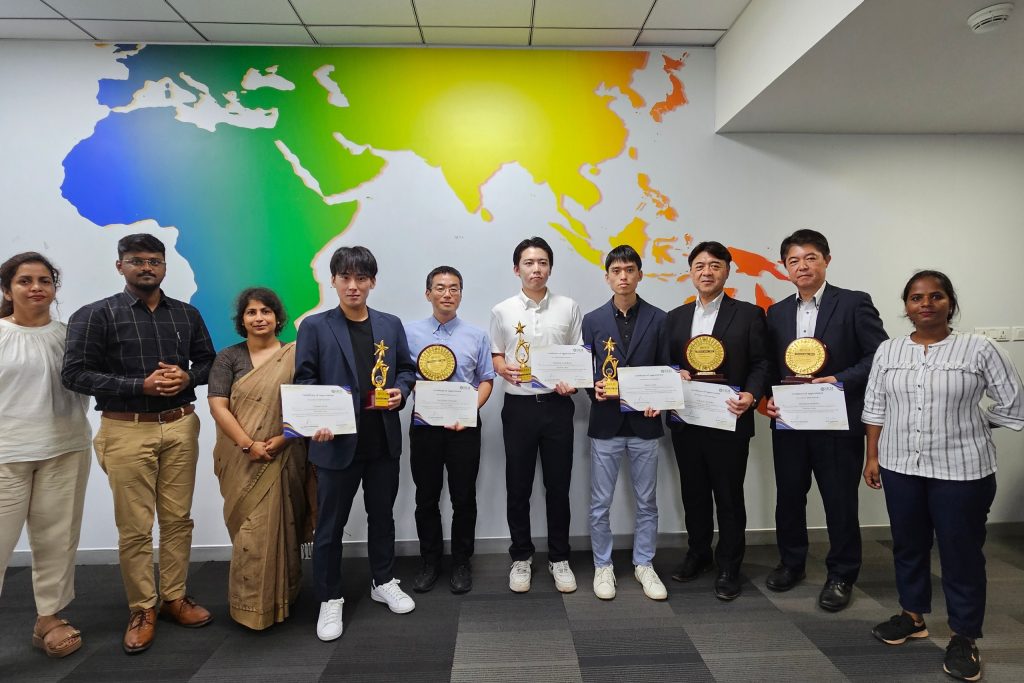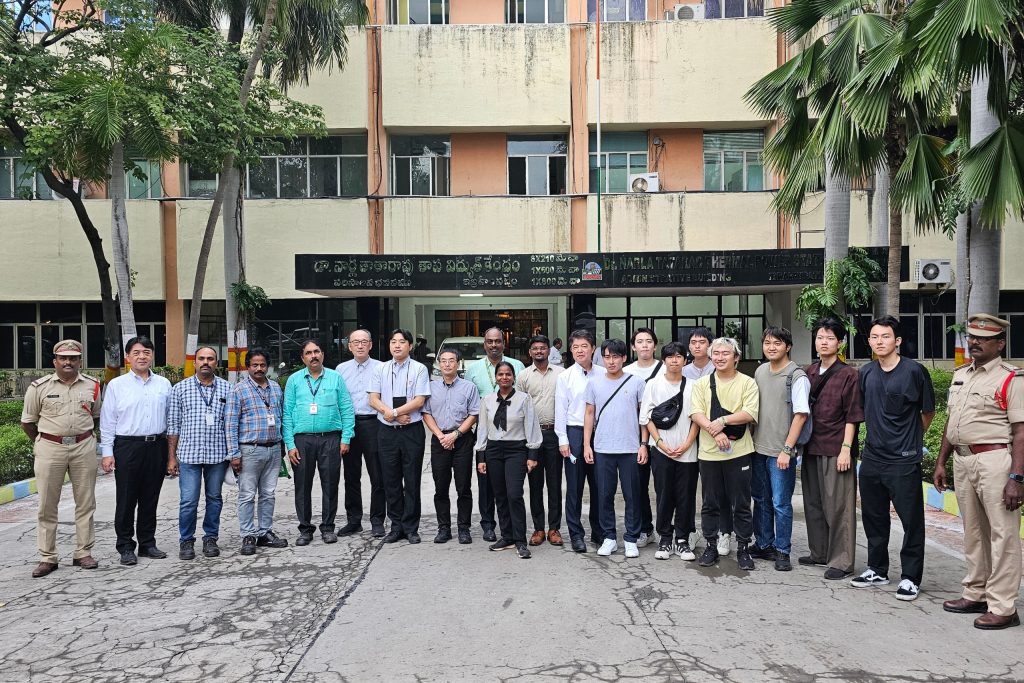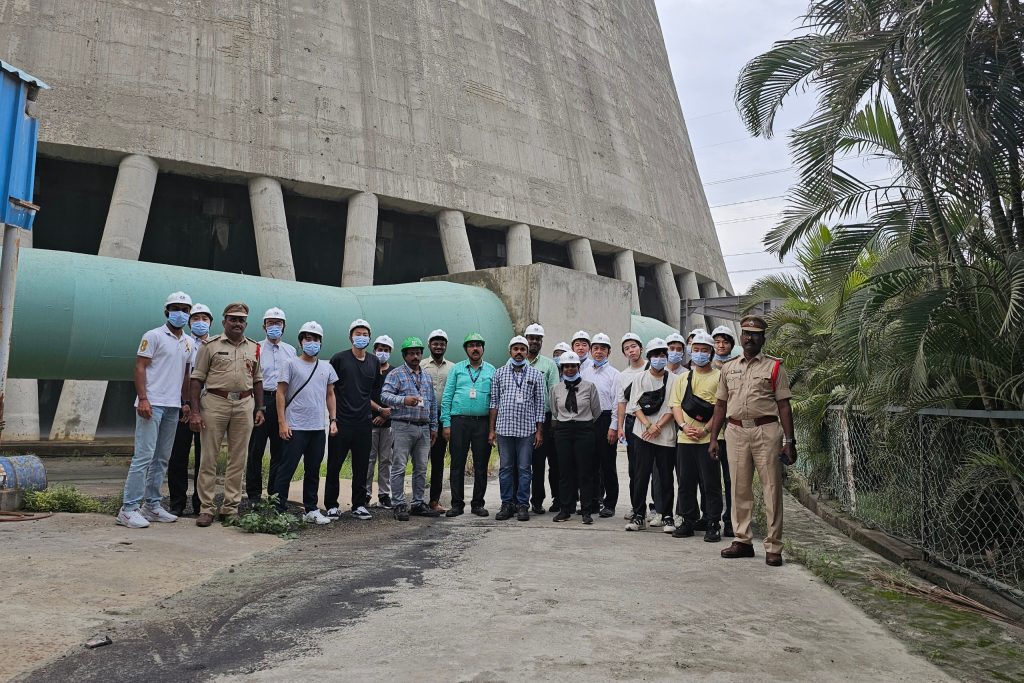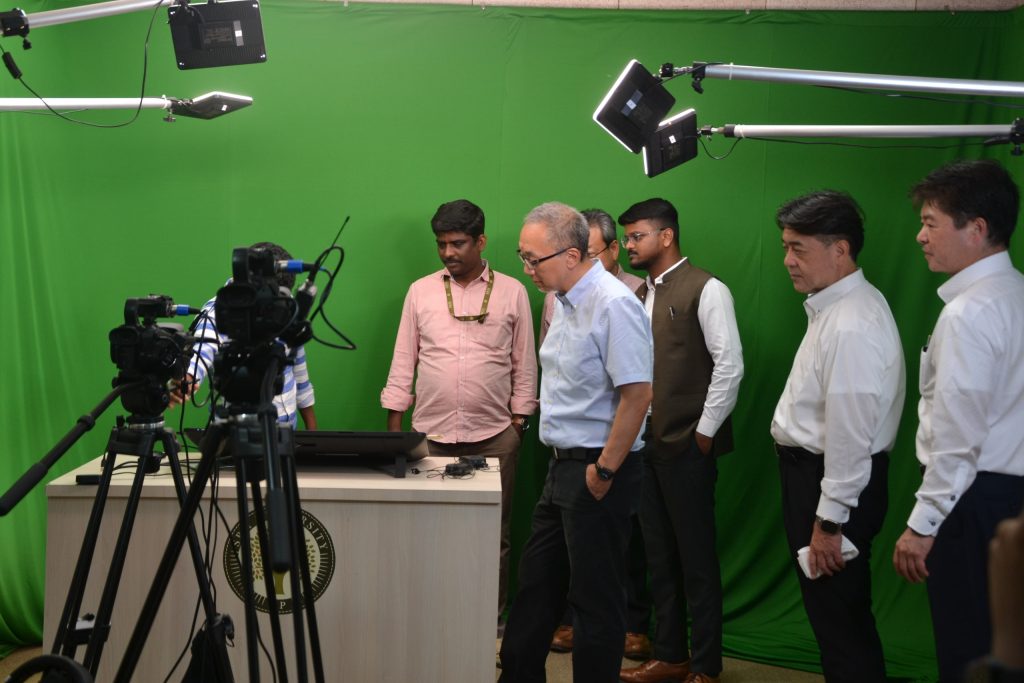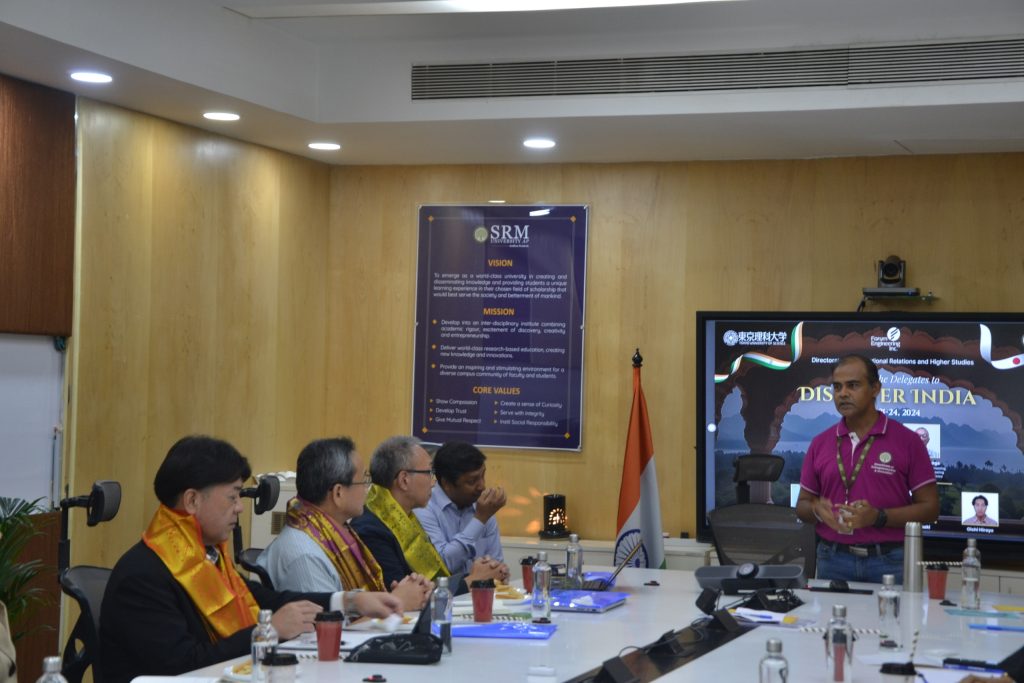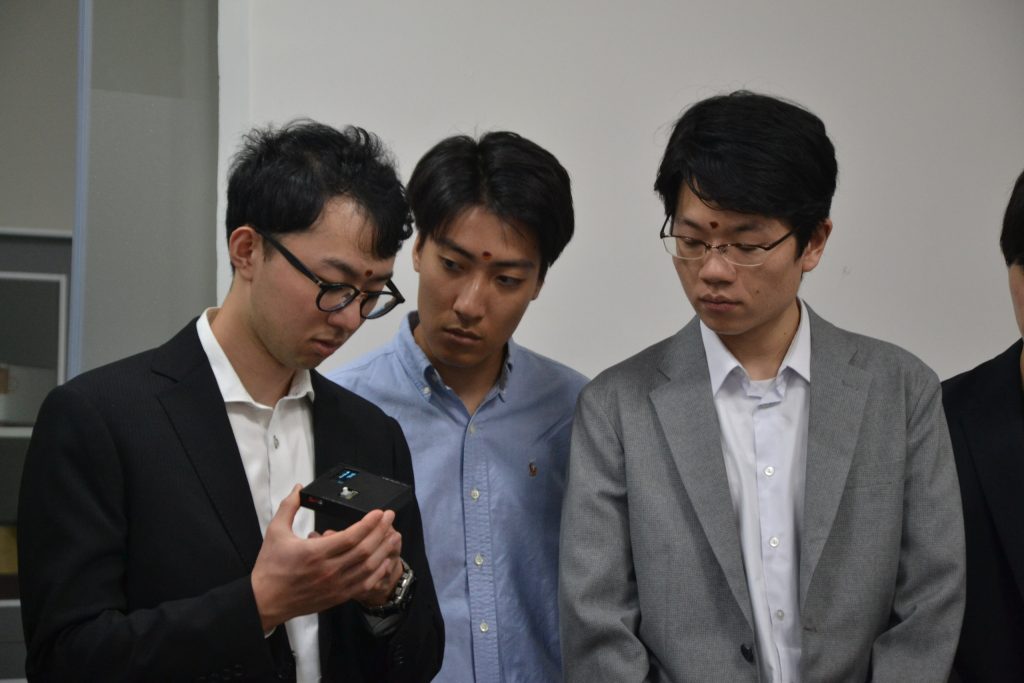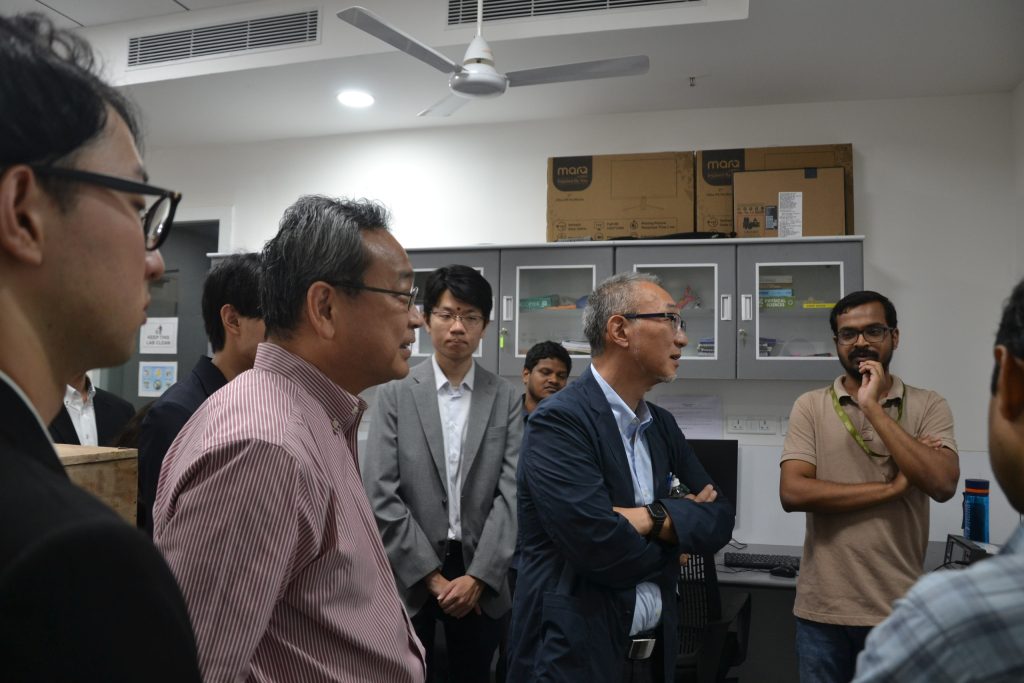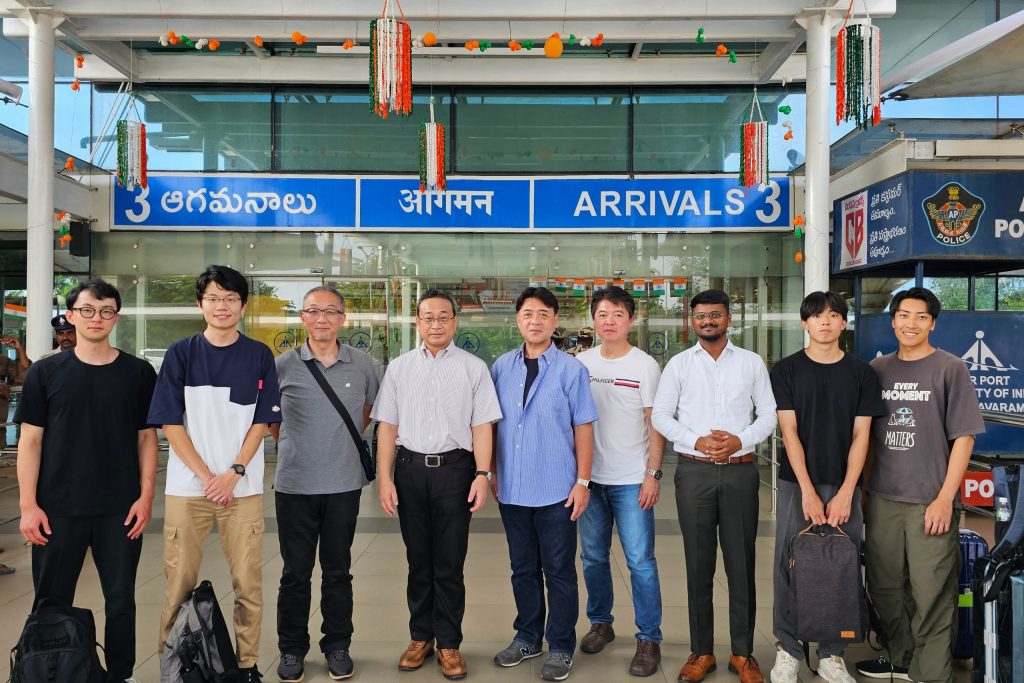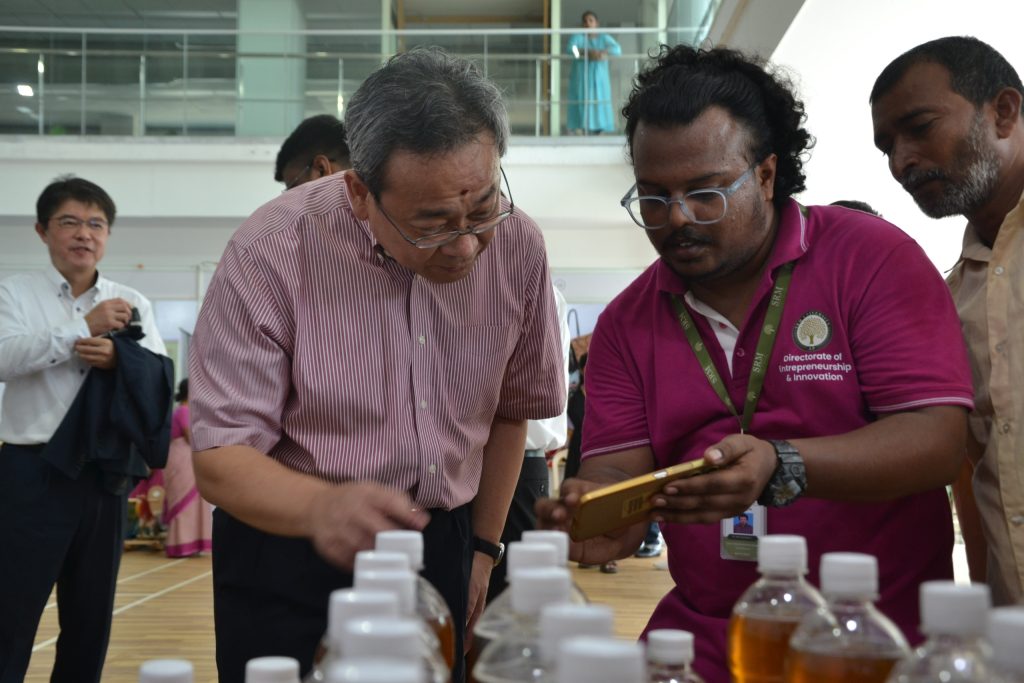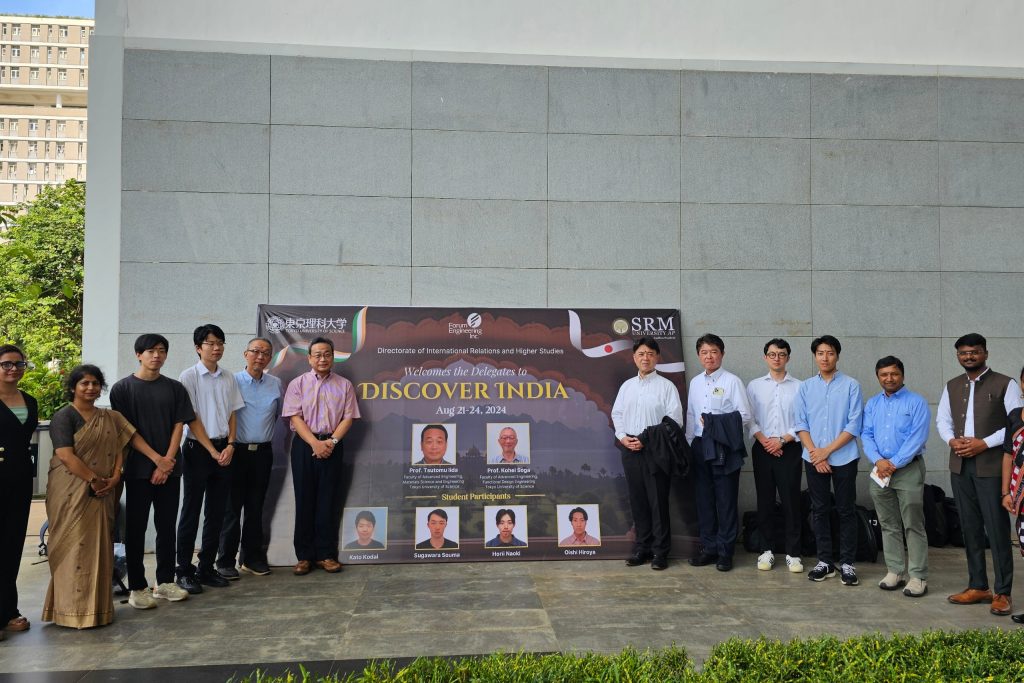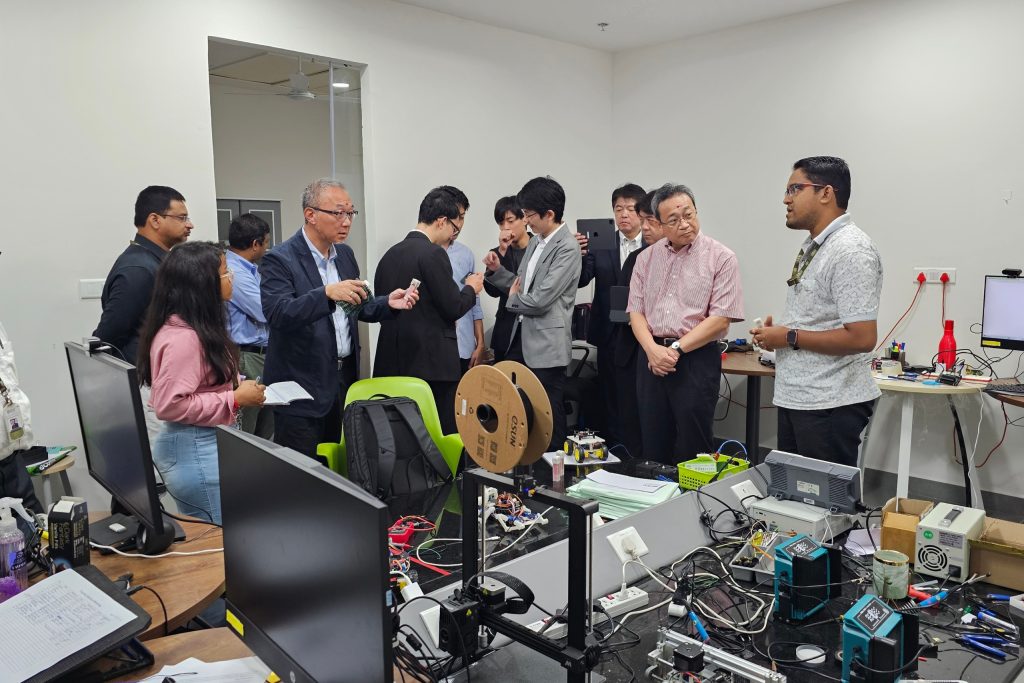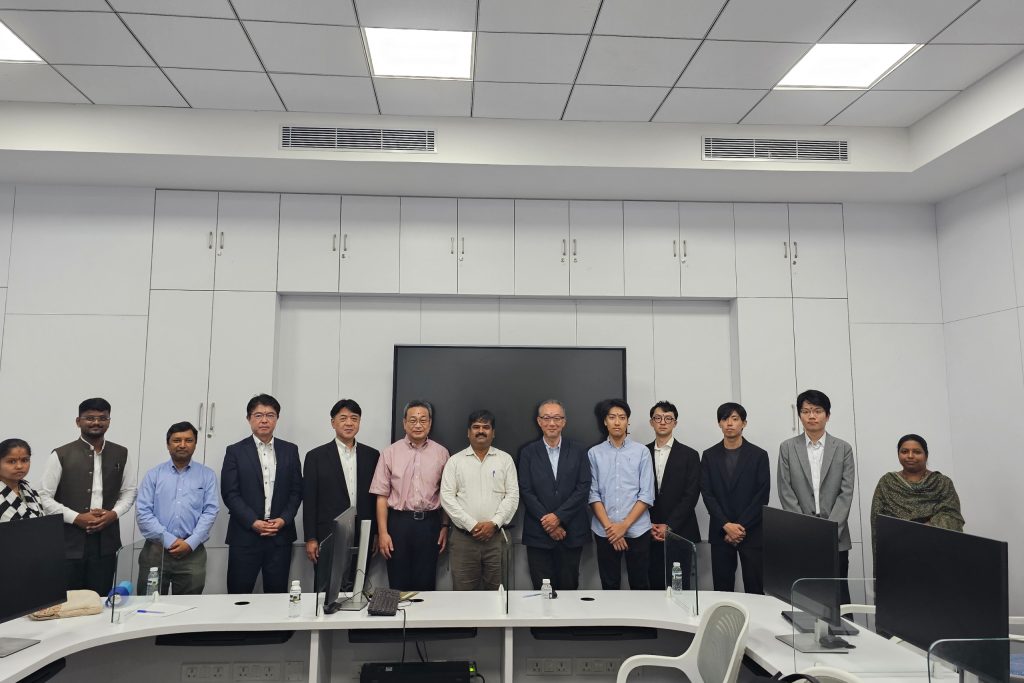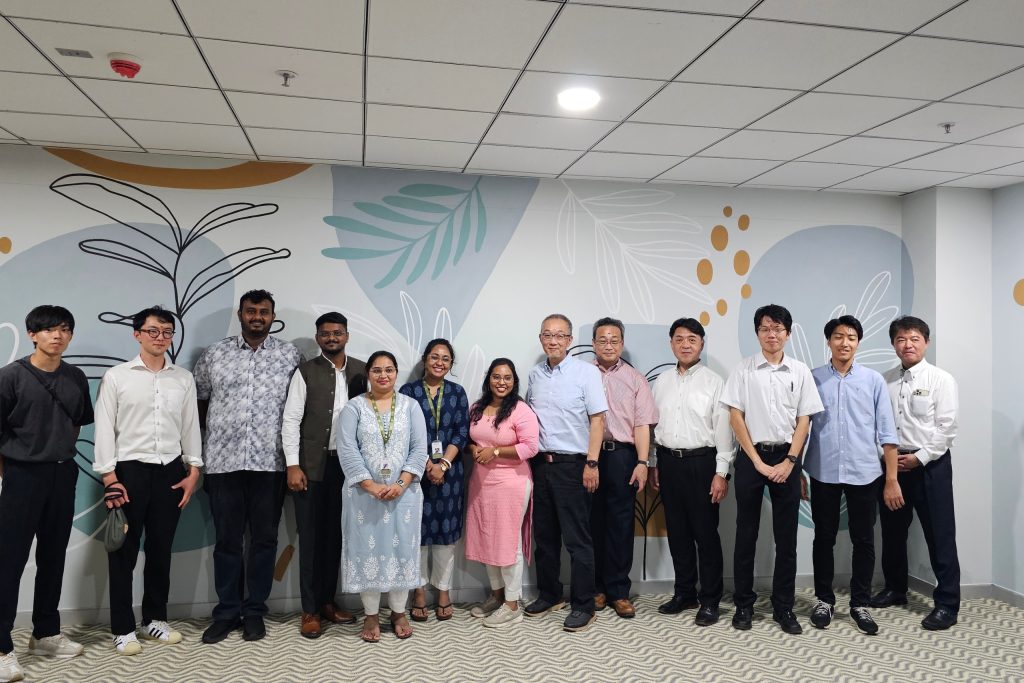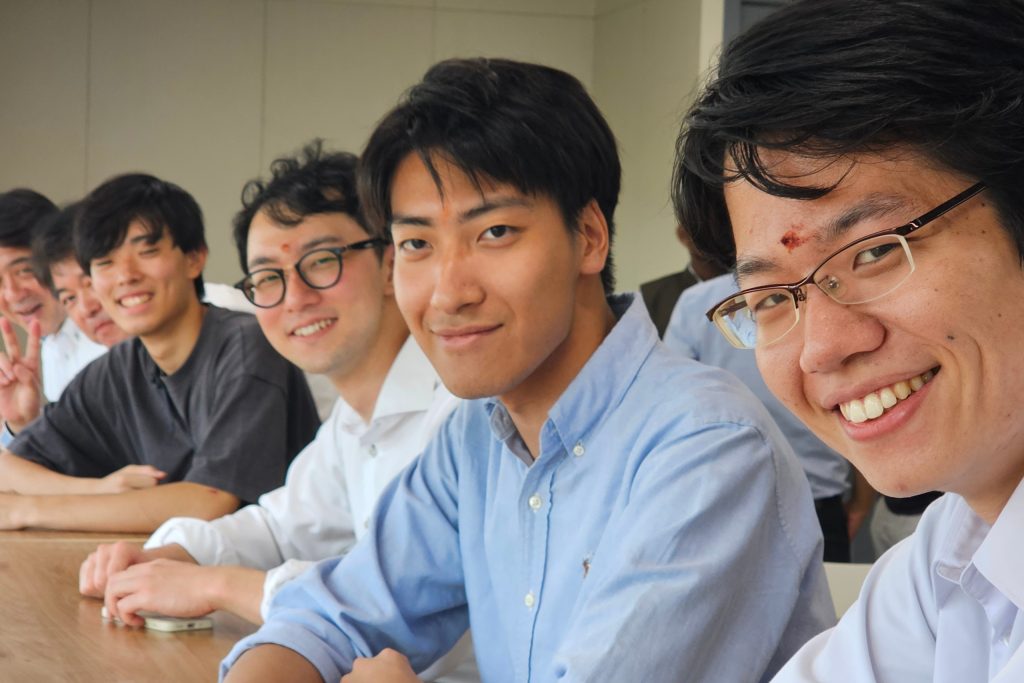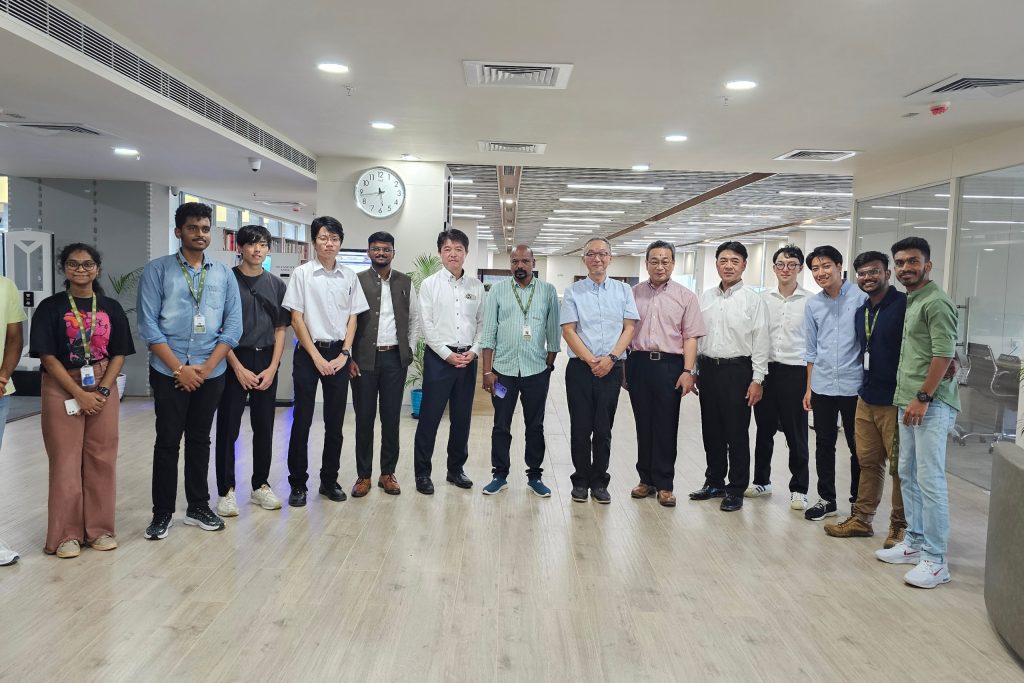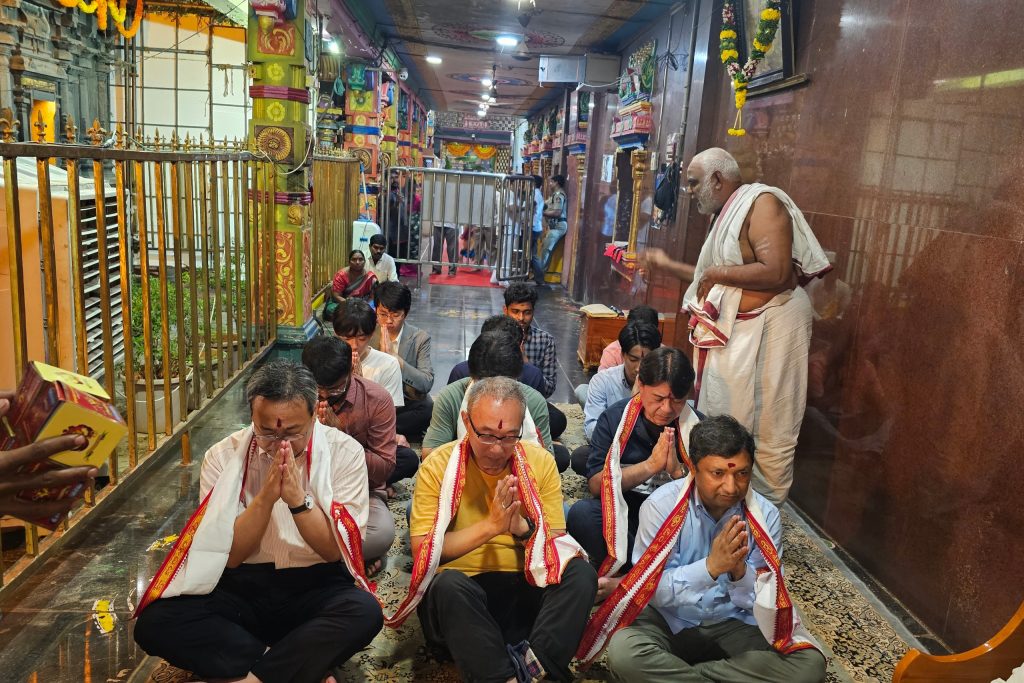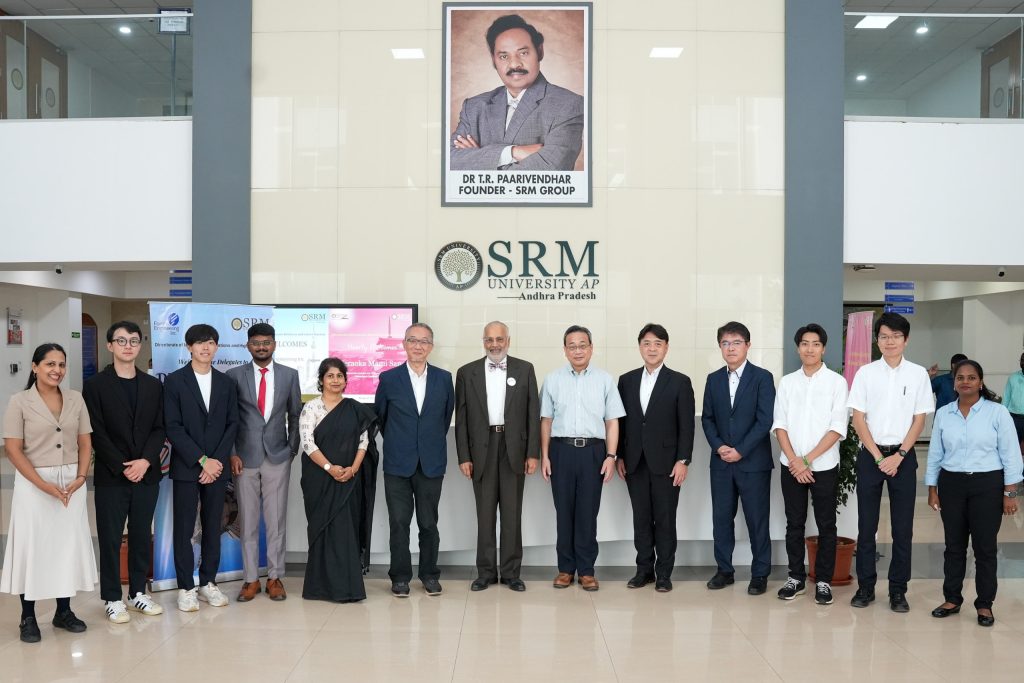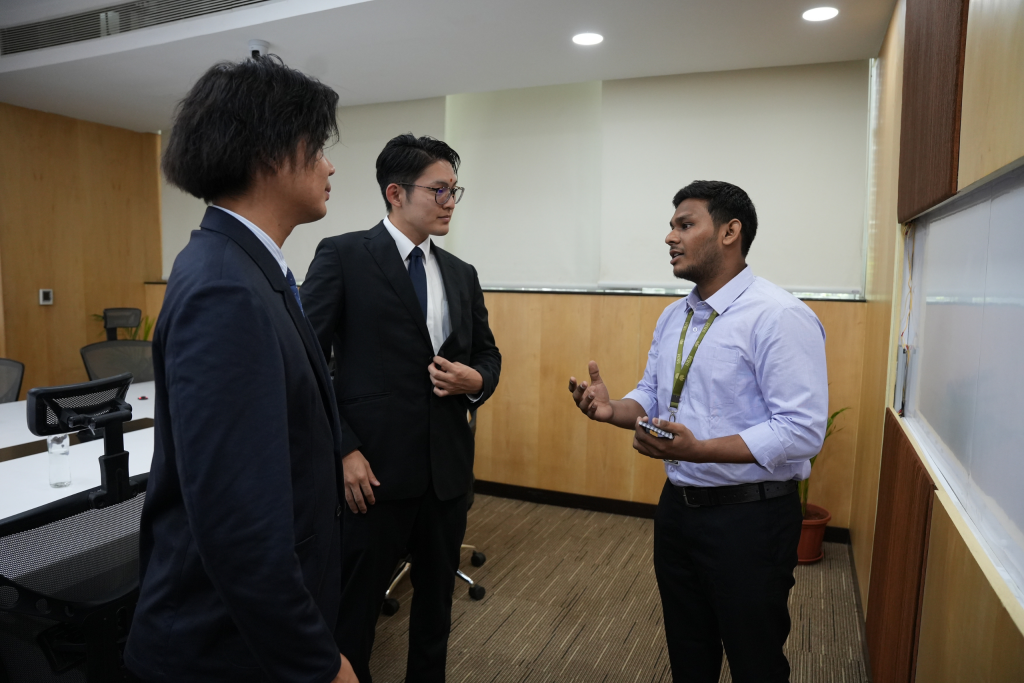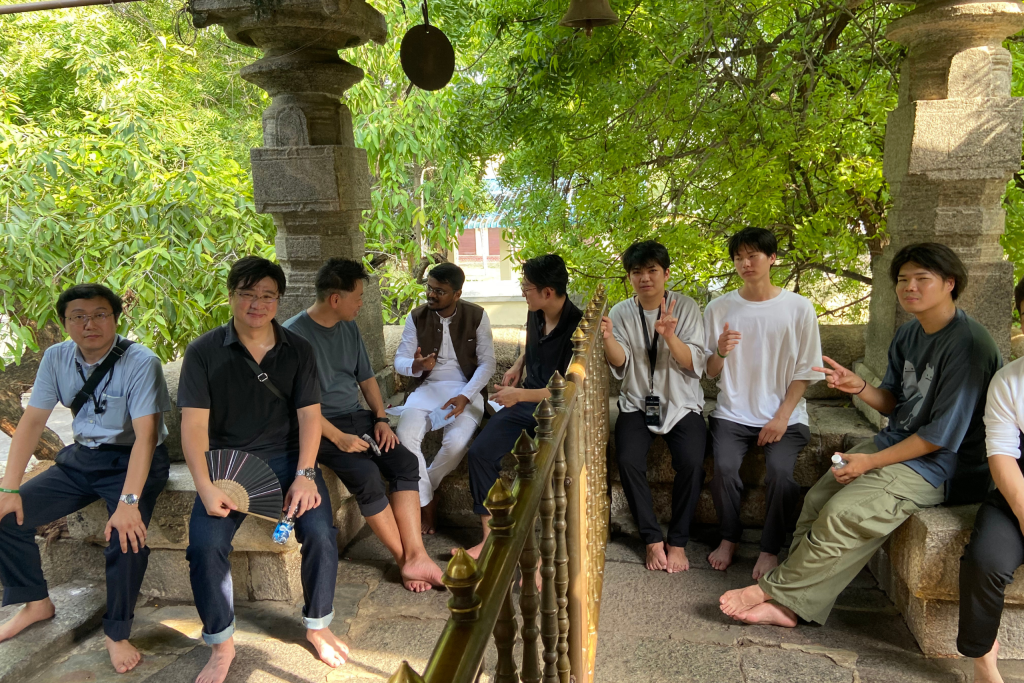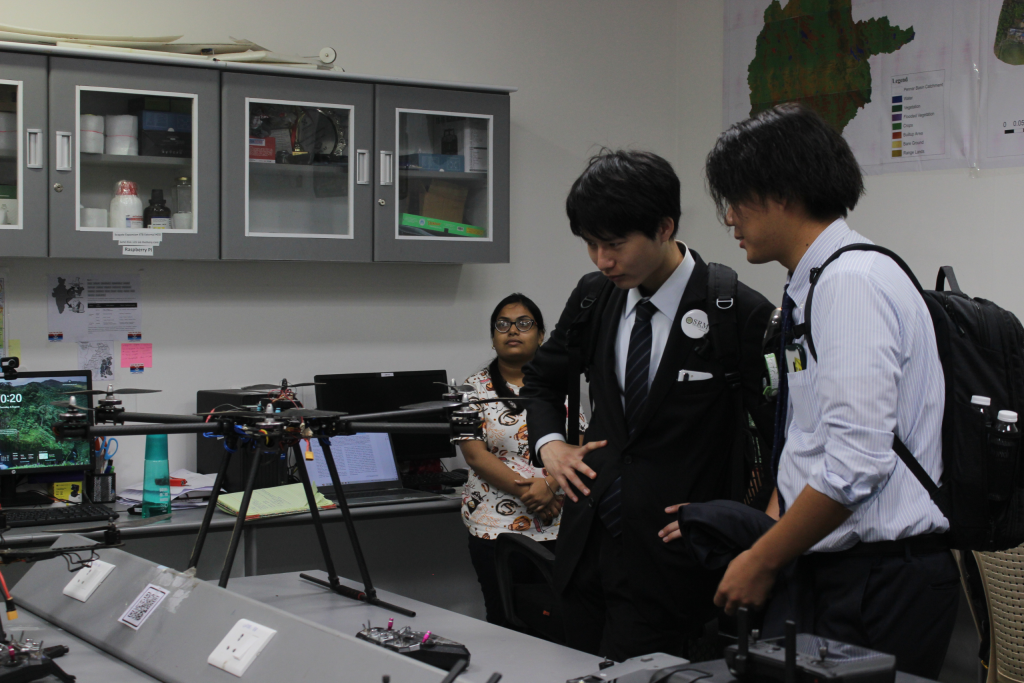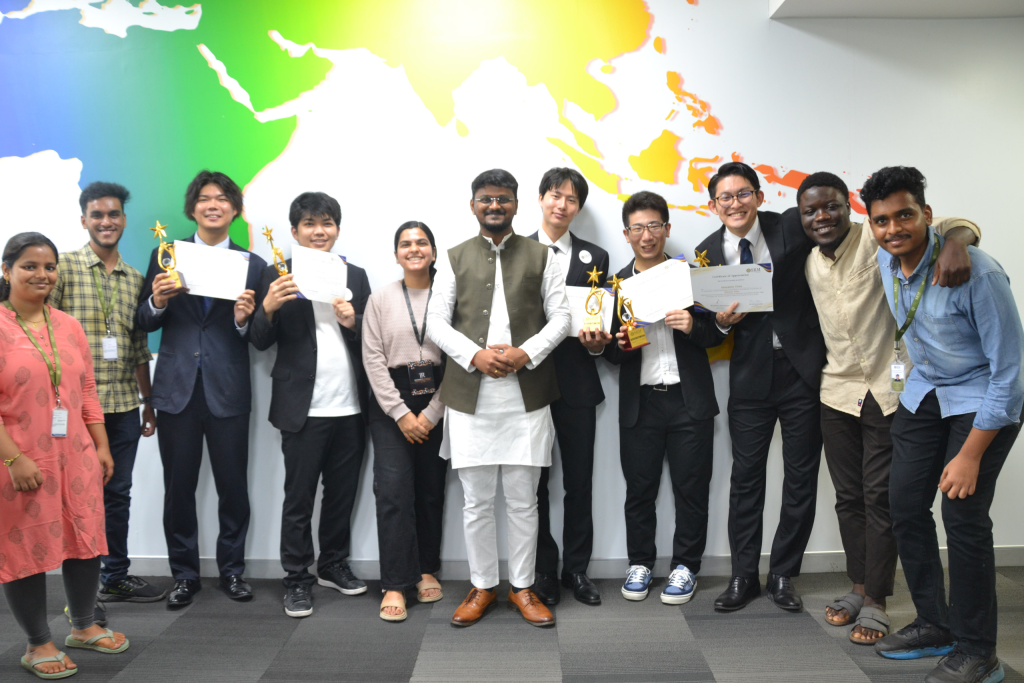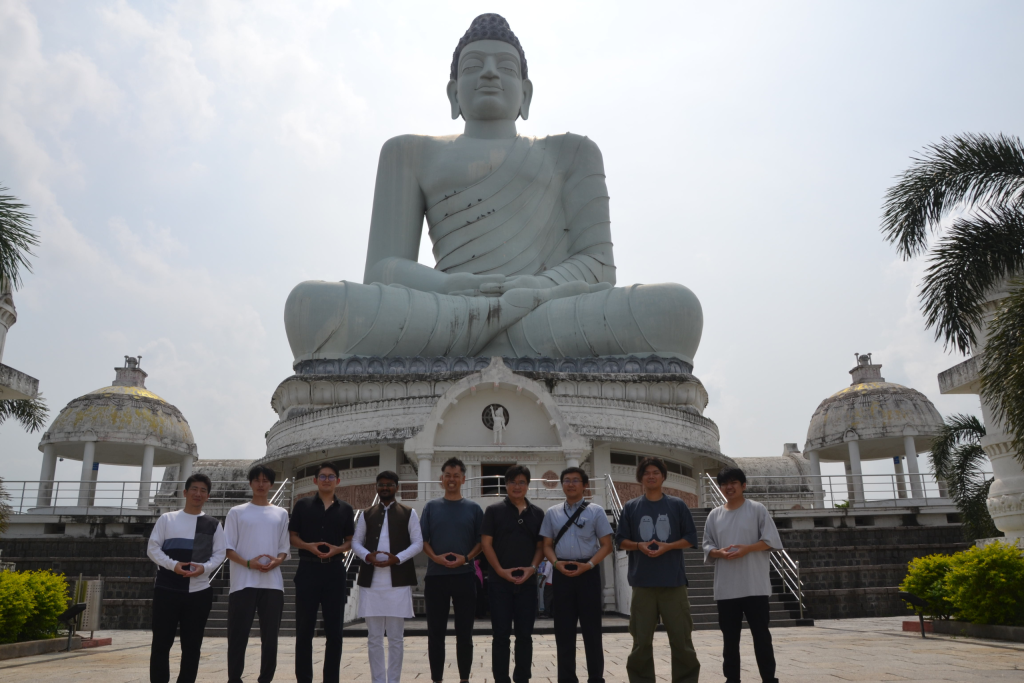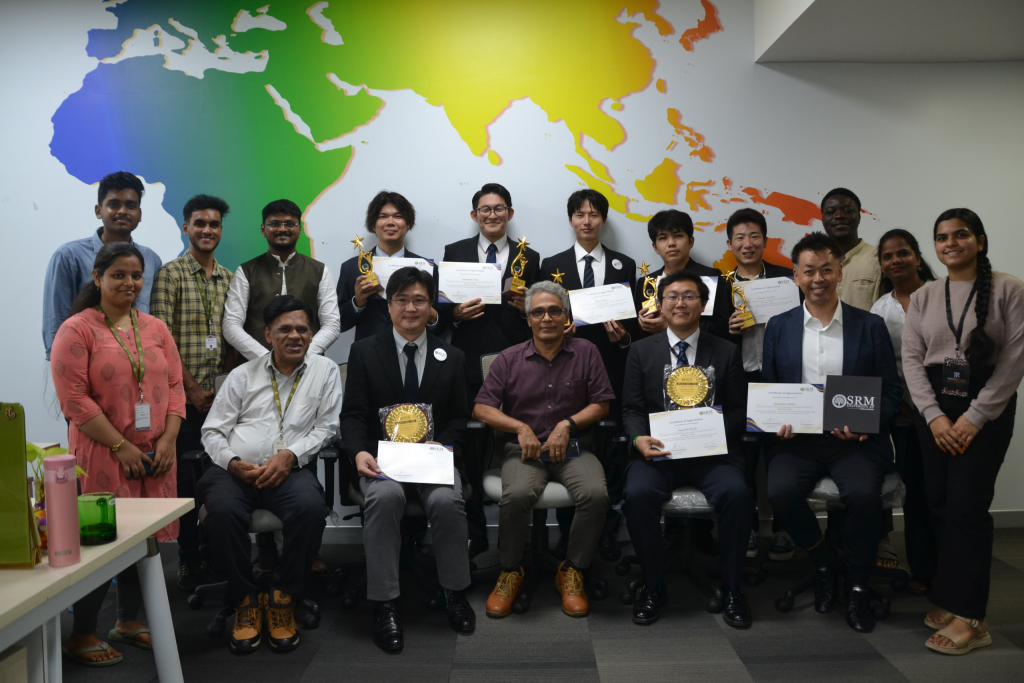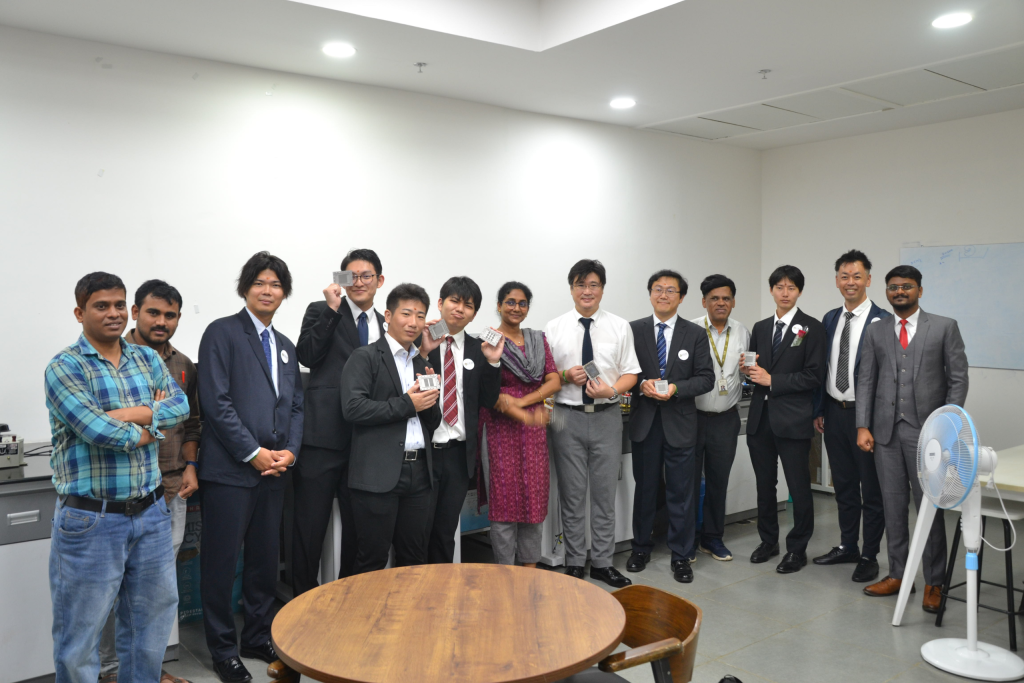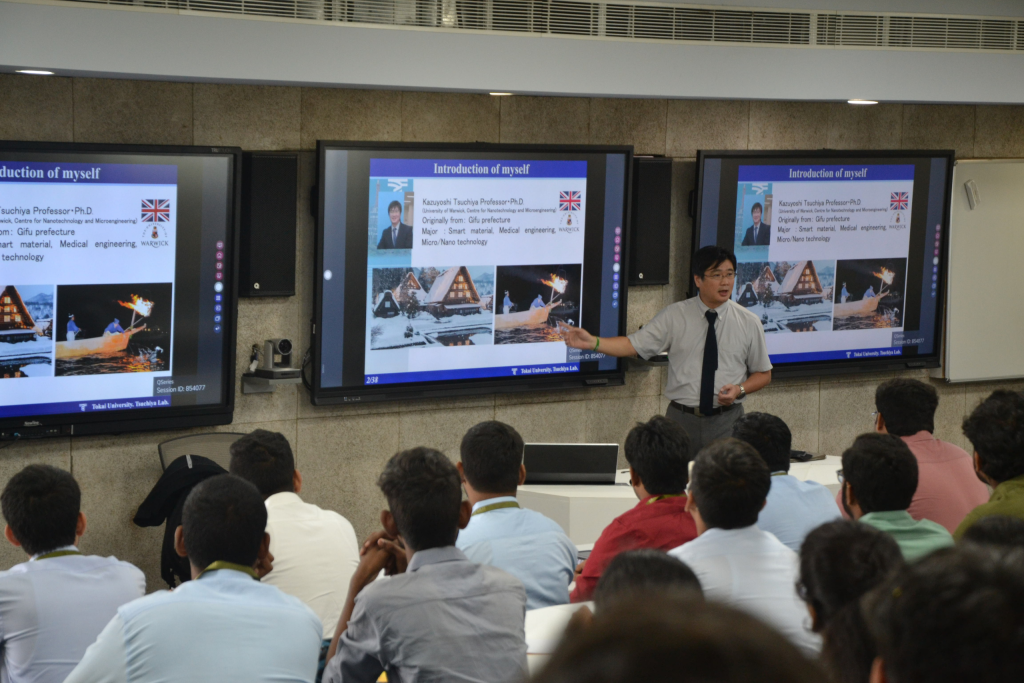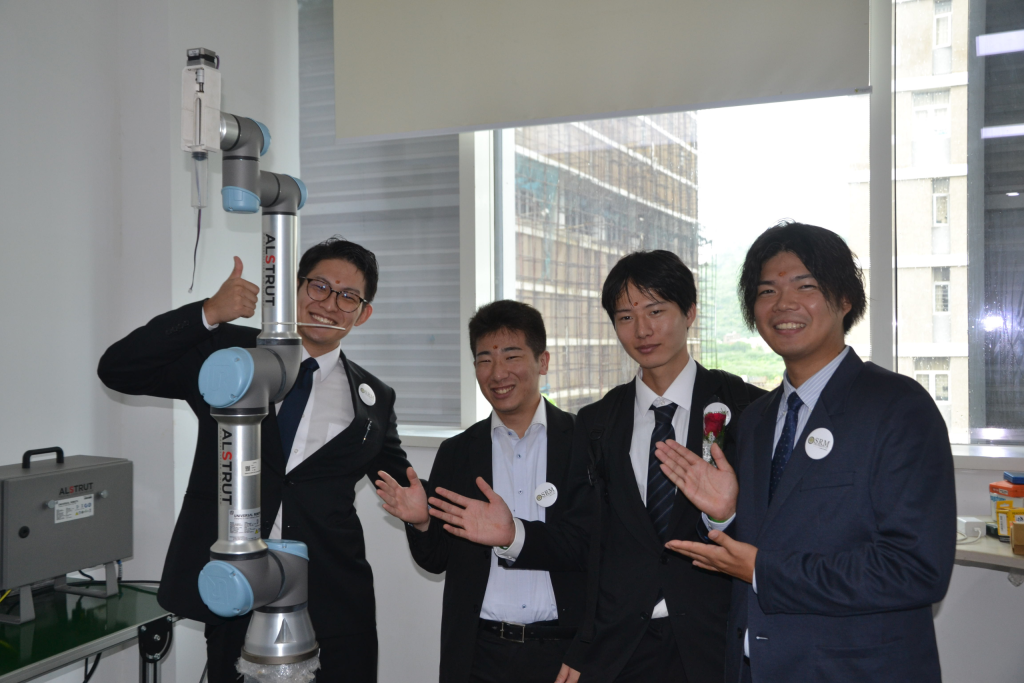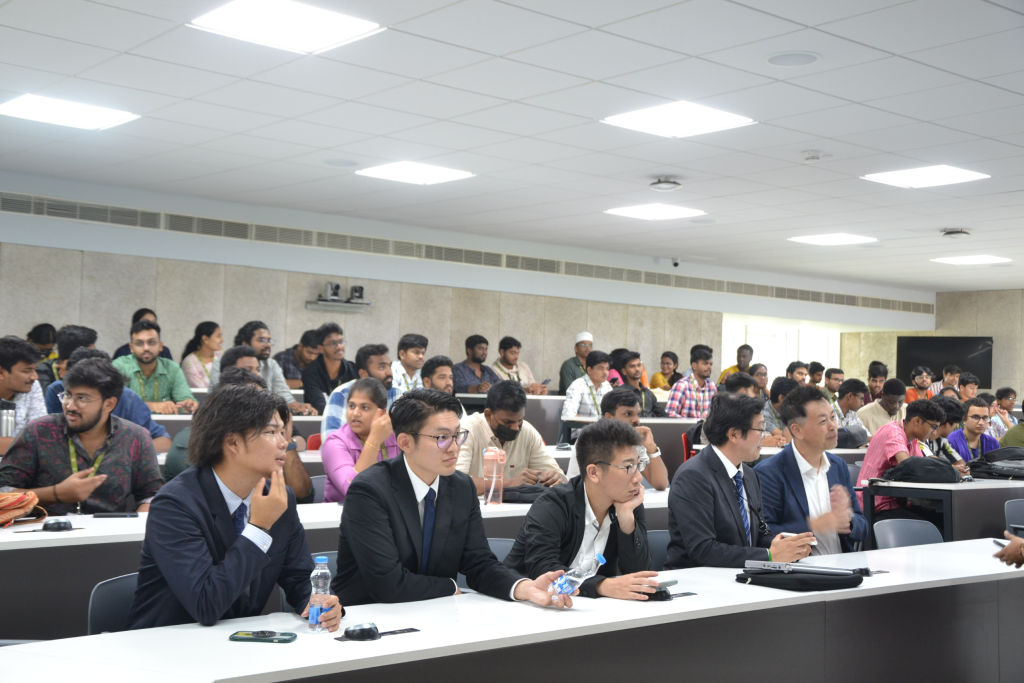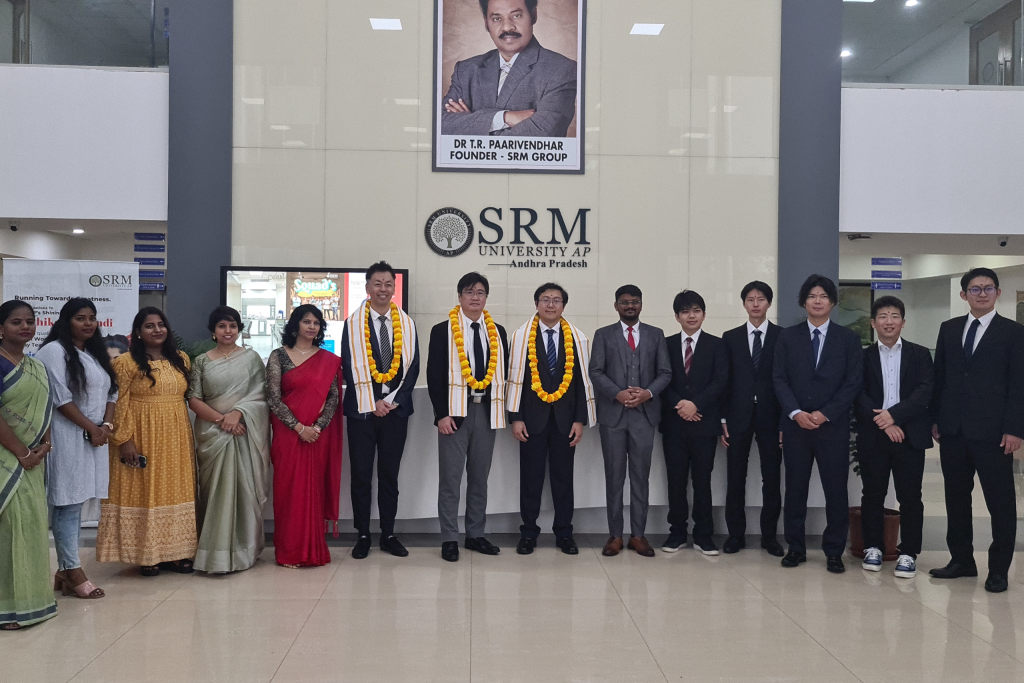SRM-AP All News
ALL News
- Honourable Chief Minister of AP Applauds SRM AP on Infrastructure Planning & Augmentation March 12, 2025
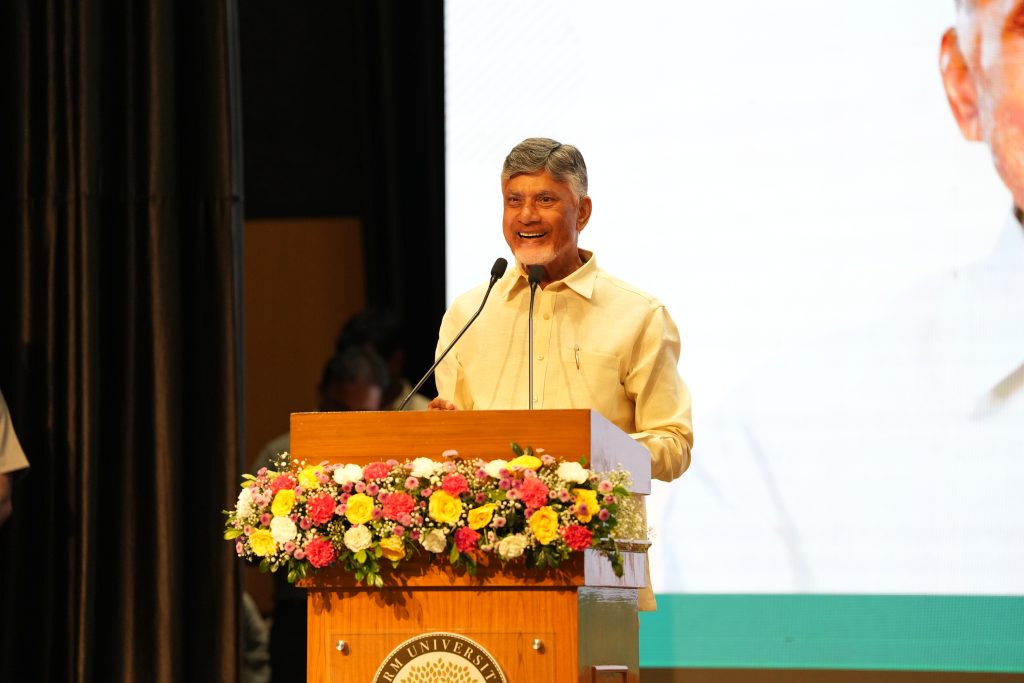
“SRM University-AP is a proof of concept of a visionary state, similar to Hitech Hyderabad a proof of united Andhra.” – Honourable Chief Minister of Andhra Pradesh, Shri Nara Chandrababu Naidu
SRM University-AP had the privilege of welcoming the Honourable Chief Minister of Andhra Pradesh, Shri Nara Chandrababu Naidu on campus on March 11, 2025. The Honourable CM, who visited the campus as the chief guest of the Conference of Population Dynamics and Development, organised under the auspices of the Planning Department, Government of Andhra Pradesh, held an exclusive interaction with the leadership and management of SRM University-AP on infrastructure planning, development and execution of the upcoming projects.
The leadership team of SRM AP, headed by the Chancellor Dr T R Paarivendhar, Pro-Chancellor Dr P Sathyanarayanan, Vice Chancellor Prof. Manoj K Arora, Executive Director – Research, SRM Group of Institutions, Prof. D Narayana Rao and Registrar, Dr R Premkumar, showcased the exemplary growth of the university emphasising the establishment of various new-age infrastructure and facilities catering to foster a future-ready academic community.
Prof. D Narayana Rao presented the Honourable CM with the university infrastructure planning and development plan and execution period for the same in the upcoming years. He gave a comprehensive overview of the future projects, including the proposed Centre for Green Hydrogen & Clean Energy Innovation, Centre for Quantum Computing, Centre for Interplanetary Exploration, SRM Medical College, AI Institute, Skilling Academy, etc. Prof. Rao assured that SRM AP would strive towards becoming a centre for transformative learning, research innovations and a successful startup incubator and sought the required support from the Government, by allocating the required resources.
In his interaction with the Honourable CM, Chancellor Dr T R Paarivendhar stated, “We follow our respected Chief Minister Shri Chandrababu Naidu’s vision to transform Amaravati into an innovation hub, and Green Co. SRM University-AP as a new-age holistic university align our strategic goals for development in cognisance to CM’s pioneering vision of Swarn Andhra Vision 2047.”
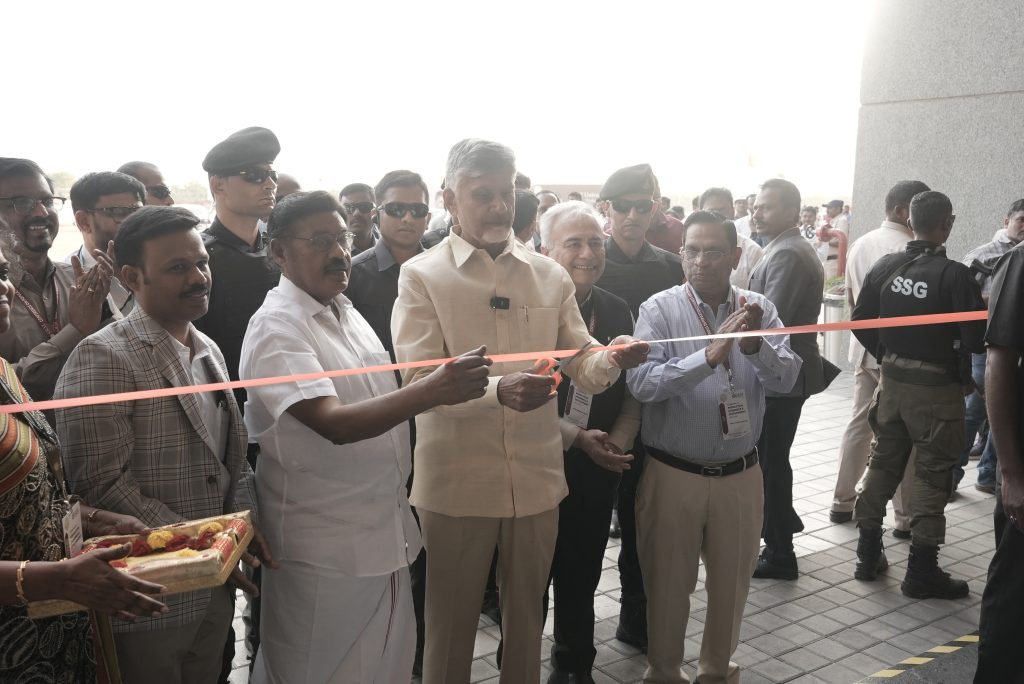
The Honourable CM congratulated the apex team of the university on its outstanding progress in the seven years, paving the path of learning and growth in Andhra Pradesh. He opined that the future is Internet of Things, Quantum Computing and Green Energy. With SRM AP being a leader in tertiary education, he advised that the university develop a strong workforce of designers, coders, and experts with skills in algorithms and hardware who are pivotal in building a progressive state. The Honourable CM recommended SRM AP to lead the startup ecosystem and produce more entrepreneurs by establishing a dedicated Centre for Innovation and Startup ecosystem.
The Honourable CM inaugurated two newly constructed buildings at SRM AP: C V Raman Block and Ganga Hostel Block (Residential facility for students). In addition, the Honourable CM laid the foundation stones for four new buildings: Industrial Research Park, Academic Cluster, Ganga-B Hostel Block, and Vedavathi-II Hostel Block.
The distinguished visit from the Honourable Chief Minister Shri Chandrababu Naidu is a testament to the relentless support and visionary direction he has offered to SRM University-AP throughout the years. Pro-Chancellor Dr P Sathyanarayanan remarked, “The perceptive insights of the Honourable Chief Minister on SRM University-AP’s initiatives and prospects have aided in aligning our development plans with the objectives of national education.”
SRM AP has made remarkable progress in its infrastructural, academic, and institutional student placement record. The unwavering support and resources from the Government of Andhra Pradesh encourage the university to become globally connected, regionally transformative, and nationally relevant.
Continue reading → - Universiti Teknologi PETRONAS (UTP) March 10, 2025
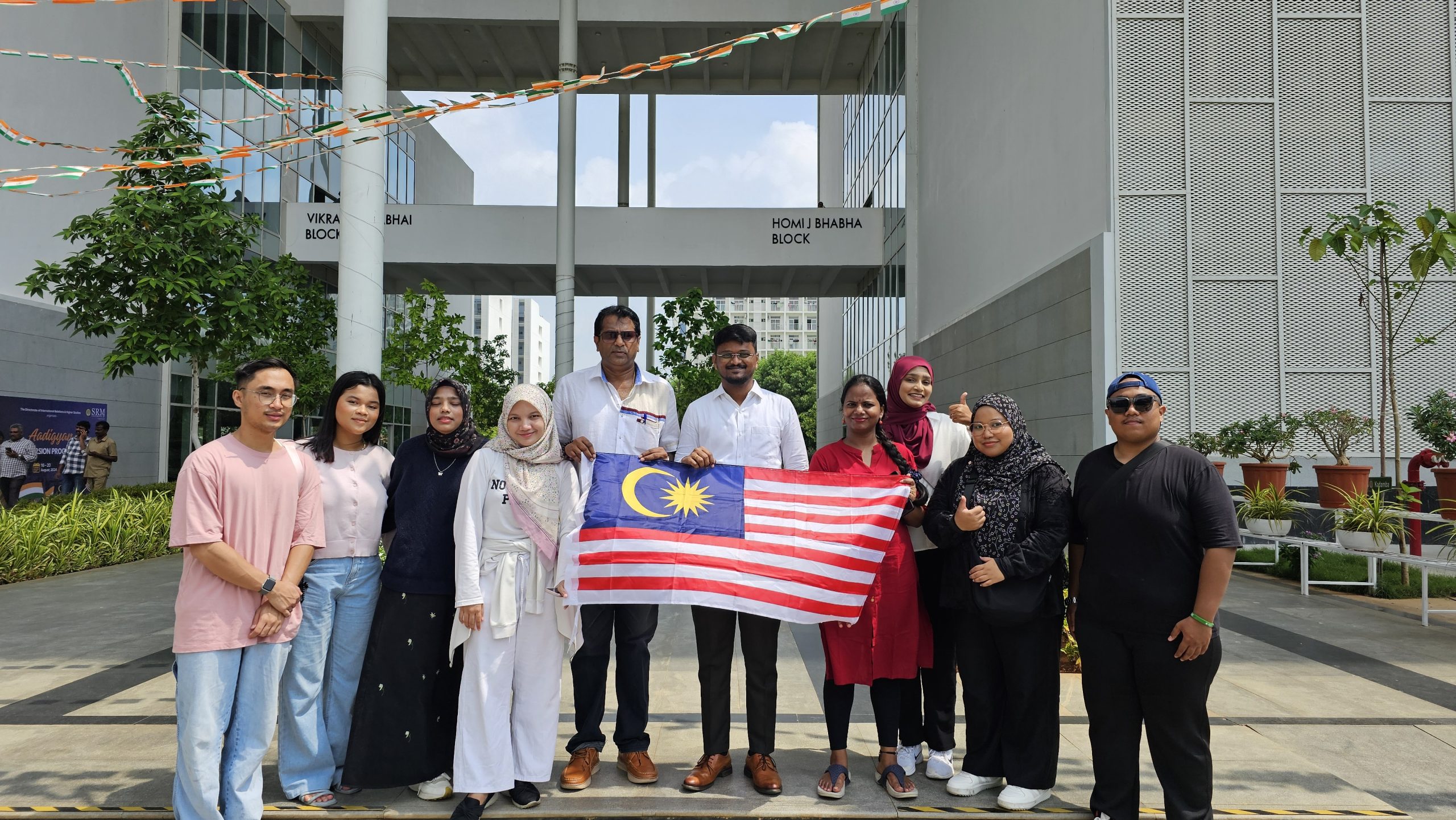 The Aadigyam Programme 2023 organized by the Directorate of IR & HS, SRM University-AP welcomed faculty and students from The Universiti Teknologi PETRONAS (UTP), Malaysia, for a 5-day immersive programme from Aug 16th to Aug 20th 2024.
The Aadigyam Programme 2023 organized by the Directorate of IR & HS, SRM University-AP welcomed faculty and students from The Universiti Teknologi PETRONAS (UTP), Malaysia, for a 5-day immersive programme from Aug 16th to Aug 20th 2024.Aadigyan Indian immersion program was inaugurated by the honourable Vice Chancellor of SRM University-AP, Prof. Manoj K Arora, Bharadhwaj Sivakumaran, Jayaseelan Murugaiyan, Mr Sidharth Tripathy and Vishnupad. “Aadigyan India Immersion 2024” is a flagship initiative of the university to promote India’s cultural and knowledge traditions.
Students participated in various short courses on Future Prospects and Introduction – Design Thinking By Mr. Satya – PSB, Entrepreneurial Mindset. Introduction of Thinking Like an Entrepreneur dynamic sessions were held on entrepreneurship and innovation by Mr. Sidharth Tripathy, Introduction to Business Insight: Today and Beyond- Dr. Kamesh – PSB, Introduction to Digital Marketing Mastery Dr Rohit / Dr Md Asadul – PSB
This collaborative initiative also focused on promoting the rich heritage of Andhra Pradesh where the students from Malaysia were taken to experience the natural landscapes and cultural delicacies of the state.
Dr. Sudeshna Saha, Assistant Director of International Relations and Higher Studies, conducted a discussion with the IR & HS team and the leadership team on various mobility programs. The topics included Student and Faculty Exchange, Transfer Programs, Joint Research Initiatives, and exploring opportunities for mutual collaboration between Tokyo University and SRM University AP
The industrial visit saw participation from a total of 13 members, including 1 professor, and 7 students from UTP Malaysia, as well as 2 staff members and 2 students from SRM University AP.
As part of the 5 days Indian Immersion Program, SRM University AP organized an industrial visit on August 18th, 2024, for the Malaysia professor and students. The group visited the Coca-Cola factory, where they first interacted with the head of the department and watched an instructional video outlining the guidelines and safety precautions for the tour.
Following this, the students were taken to the simulation room, where they observed the production process of Thumbs Up and other flavored beverages. They then toured various sections of the plant to see how different drinks are bottled and packed.
The visit began with a brief introduction of the team, followed by a presentation on the Ibrahimpatnam Coal-Based Power Station. After the presentation, the group toured the entire power station, including the coal heating and cooling units, gaining an understanding of the coal-based power generation process and how electricity is supplied to the Vijayawada region.
They also got to visit the famous landmarks of Vijayawada, such as the Dhyana Buddha statue, Prakasham Barrage, etc.
Continue reading → - Discover India Programme March 10, 2025
SRM University-AP welcomed Japanese faculty from “Toyo University from Japan”. rich c
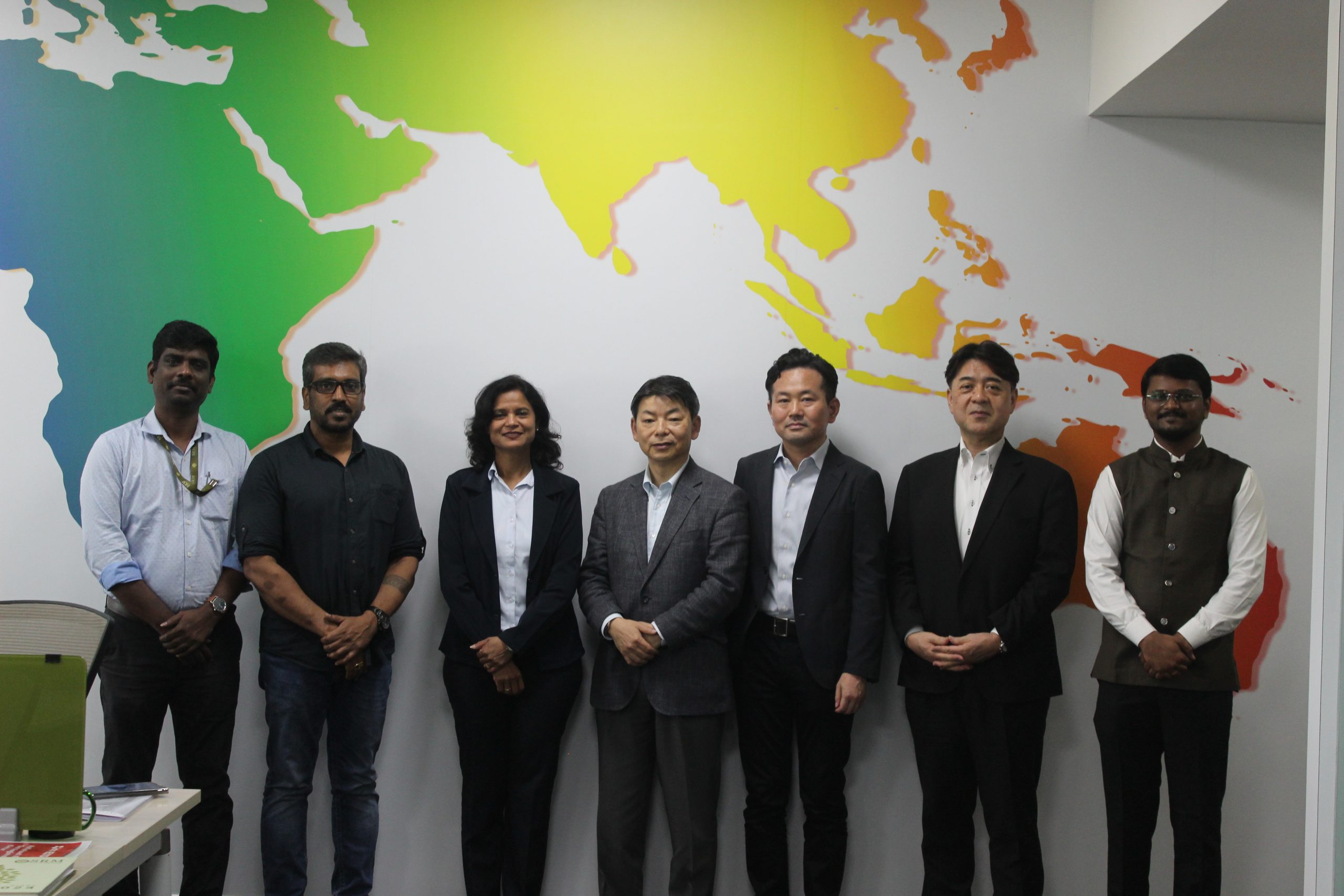 ultural landscape of India through the Aadigyan – Indian Immersion Program from february 21st to 24th, 2024. These 4-days program conducted by the Directorate of International Relations and Higher Studies was inaugurated by the honorable Vice Chancellor of SRM University-AP, Prof. Manoj K Arora. Aadigyan is a flagship initiative of the university to promote India’s cultural and knowledge traditions.
ultural landscape of India through the Aadigyan – Indian Immersion Program from february 21st to 24th, 2024. These 4-days program conducted by the Directorate of International Relations and Higher Studies was inaugurated by the honorable Vice Chancellor of SRM University-AP, Prof. Manoj K Arora. Aadigyan is a flagship initiative of the university to promote India’s cultural and knowledge traditions.Our “Discover India Programme” is a transformative journey where innovation meets tradition. SRM University-AP unfolds its collaborative tapestry with Toyo University, #Japan. Witness the dawn of a new era in academia, brimming with opportunities that promise to revolutionize our educational landscape. We are honored to host our distinguished guests Prof. Akihiro Matsumoto, Dean of Science and Engineering, Toyo University, Prof. Sho Yokota, Department of Mechanical Engineering, Toyo University, Mr. Yutaka Kikuchi, Operating Officer, Forum Engineering Inc.
Who are steering the venture towards unparalleled educational milestones with Ms. Aditi Jain, Director IR and HS, SRMAP, Dr. Mannathan Subramaniyan, Associate Director IR and HS, SRMAP, Dr Jatindra Kumar Dash, Associate Dean in-charge – (Engineering) SEAS, Dr. Tousif Khan N, SMIEEE, MIE, Head of the Department, Electrical and Electronics Engineering, Dr. Vinod Kumar, Head Of Department – Mechanical Engineering, SRMAP.
This enlightening gathering was more than a meeting of minds; it was a fusion of cutting-edge research and shared visions. The delegates engaged intimately with our esteemed faculty and brilliant research scholars from the Mechanical and Electrical and Electronics Engineering Departments, sparking dialogues that promise to kindle innovative research collaborations.
Their exploration of our state-of-the-art research facilities provided a window into the advanced realm of EV Research Technologies at SRM University-AP. The visit illuminated the potential for groundbreaking advancements in sustainable technology, reflecting our commitment to pioneering solutions for a greener future.
The academic engagement was beautifully complemented by industry visits to Efftronics Systems Pvt Ltd and Hindustan Coca-Cola Beverages Pvt Ltd, where practical insights and real-world applications bridged the gap between theoretical knowledge and industrial praxis.
Culminating the visit, our guests were immersed in the rich tapestry of Indian culture, exploring the serene Amaravati Buddha Statue, the sacred Amareswara Swamy Temple, and the historic Durga Temple in Vijayawada. This cultural odyssey not only showcased the heritage of our region but also fostered a deeper mutual respect and understanding, enriching the fabric of our international collaboration.
As we reflect on these three days of intellectual exchange, cultural immersion, and visionary exploration, we are filled with hope and excitement for the future collaborations that will undoubtedly emerge from this fertile groundwork. We stand on the brink of a new dawn in global education, ready to innovate, inspire, and transform together.
Continue reading → - SOJO University March 10, 2025
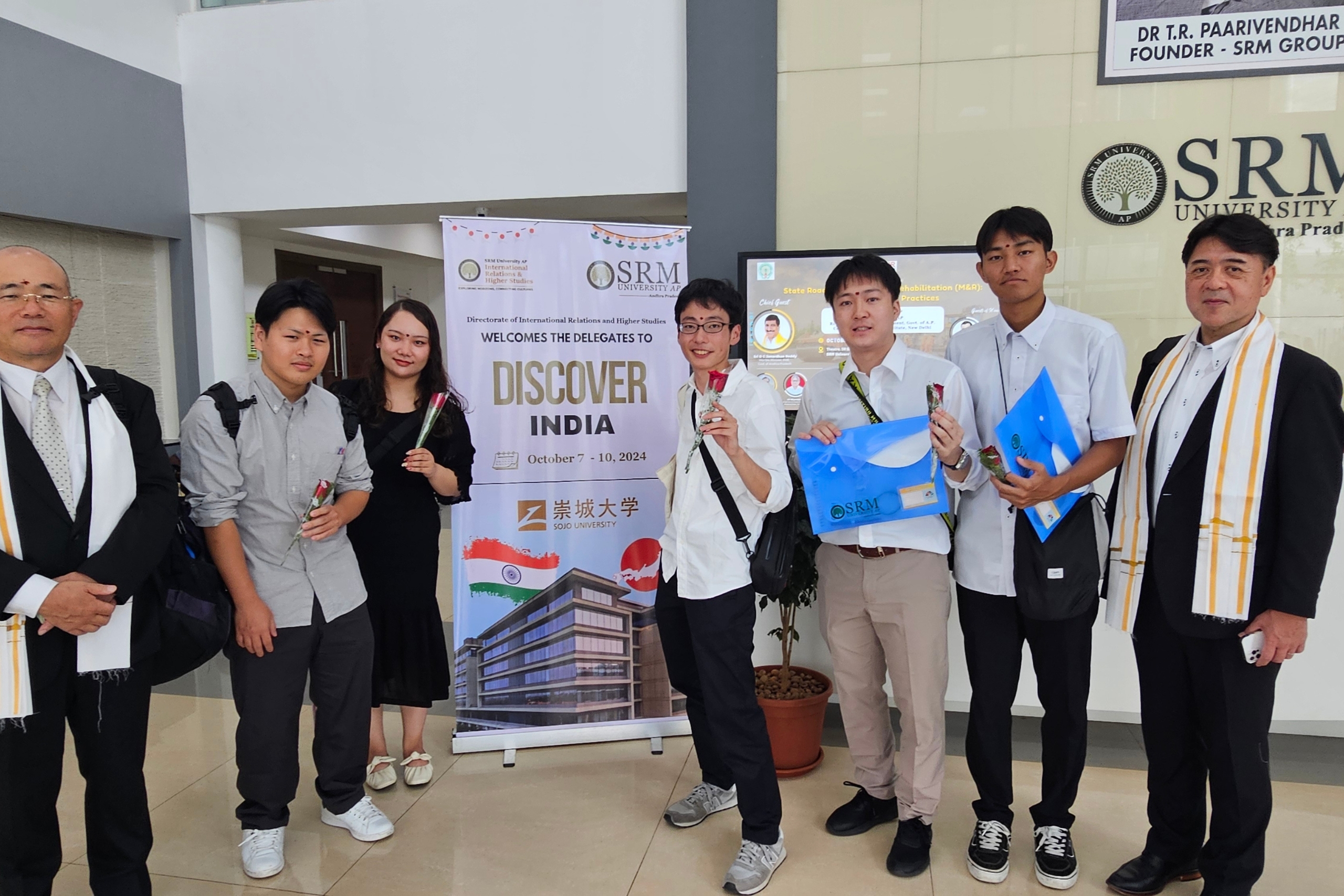 The Directorate of International Relations & Higher Studies organized a “Discover India 2024 ” program for professors and students from Sojo University and Forum Engineering, Japan.
The Directorate of International Relations & Higher Studies organized a “Discover India 2024 ” program for professors and students from Sojo University and Forum Engineering, Japan.Inaugurated by the honorable Vice Chancellor of SRM University-AP, Prof. Manoj K Arora, Bharadhwaj Sivakumaran, Jatindra Kumar Dash, Jayaseelan Murugaiyan. Dr. Sudeshna Saha, Assistant Director of International Relations and Higher Studies, received the international students at the grand inaugural ceremony of the program. Students participated in various short courses on research area introduction Research Lab and Centre Visit from Prof. Ranjit Thapa, Physics working Labs, Dr. Basabendu Barman and Dr. L N Patro, Research work presentations from Department of Chemistry & Biology. They had Chart activity on Environmental Science from Dr. Narayanamoorthy Bhuvanendran Department of Environmental Science and Engineering.
A discussion was held with the IR & HS team and leadership team regarding various mobility programs, including Student and Faculty Exchange, Transfer Programs, Joint Research initiatives, and opportunities for mutual collaboration between Tokyo University and SRM University AP.
An interactive session was organized for Destination Japan students currently learning Japanese at SRM University AP, supported by SRM Global. Professors Tomoshige Ryuichi delivered an engaging presentation on Tokai University, highlighting job and internship opportunities in Japan. The session provided a platform for Destination Japan students to interact with peers learning Japanese. Over 40 students actively participated, making the event a resounding success.
The industrial visit saw participation from a total of 12 members, including 1 professor, 1 staff member, and 5 students from Sojo University and Forum Engineering, as well as 2 staff members and 2 students from SRM University AP. As part of the 3-day “Discover India” program, SRM University AP organized an industrial visit on October 8th 2024, for the Japanese delegation from Sojo University and Forum Engineering. The group visited the “Jocil Limited ” located in Guntur. Jocil Limited work for Manufacturing Toilet Soap/ Soap Noodles/ Coloured Noodles/ Strands and Bits/ Premium and Translucent Soaps/ Liril Icy Cool l Savlon l Margo Natural and brands have been developed at Jocil.
First we have a brief introduction of the team, followed by a presentation on the Guntur plant. After that we visited to Fatty Acid Fractionation Plant, Fatty Acid Splitting Plant, Soap Plant – Vacuum Spray Drying,Boiling Section, Vacuum Spray Drying, Wrapping Machines, Semi Automatic and visited soap Finishing Section STUR 7 Stamping M/C.
Following this, the students were taken to the simulation room, where they observed the production process of Thumbs Up and other flavored beverages. They then toured various sections of the plant to see how different drinks are bottled and packed.
They also got to visit the famous landmarks of Vijayawada, such as the Dhyana Buddha statue, Prakasham Barrage, Vijayawada Kanaka Durga Temple etc.
Continue reading → - Hiroshima Institute of Technology March 10, 2025
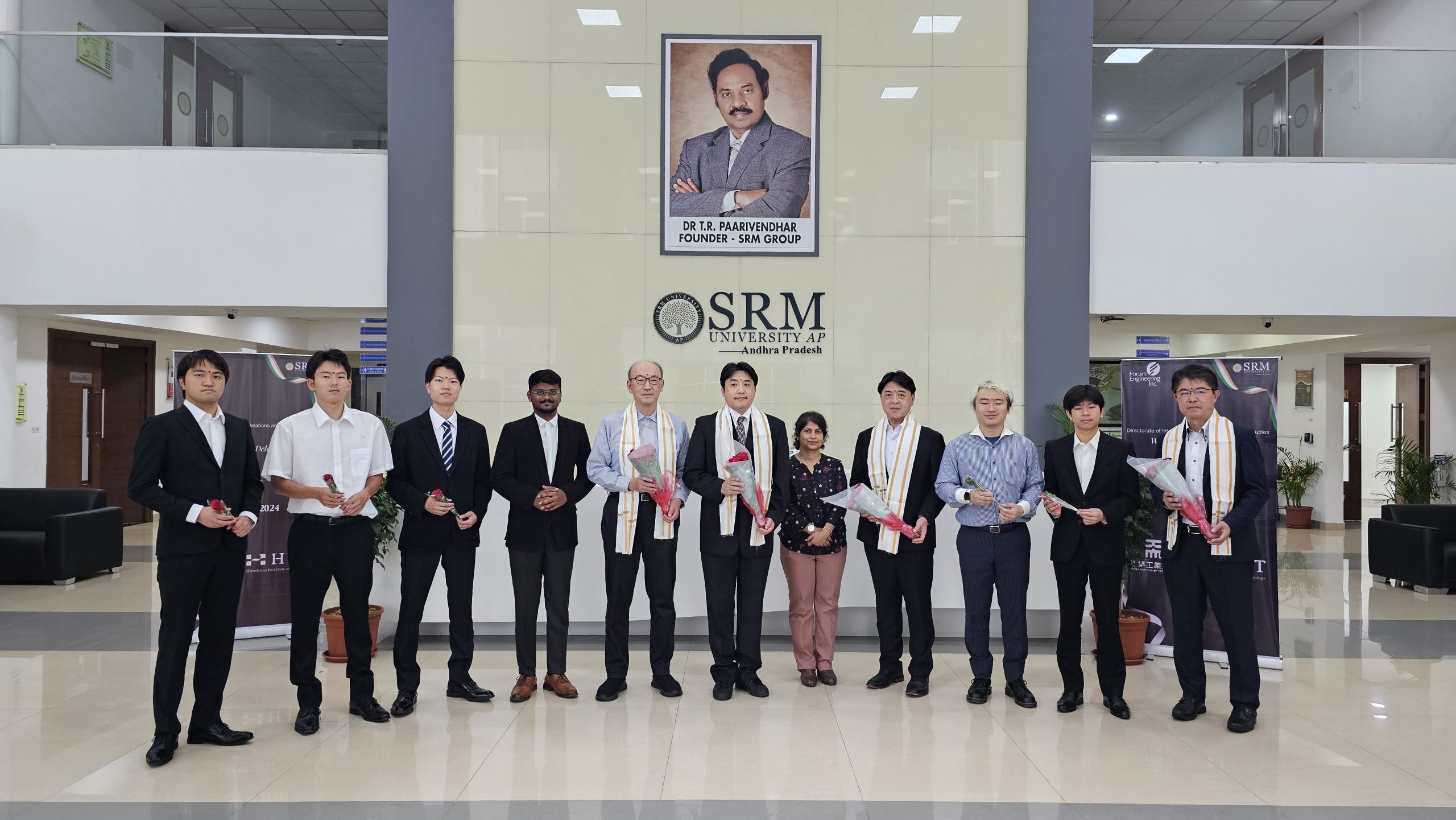 The Directorate of International Relations & Higher Studies organized a “Discover India 2024 ” program for professors and students from Hiroshima Institute of Technology and Forum Engineering, Japan.
The Directorate of International Relations & Higher Studies organized a “Discover India 2024 ” program for professors and students from Hiroshima Institute of Technology and Forum Engineering, Japan.The 4-day program conducted by the Directorate of International Relations and Higher Studies was inaugurated by the honourable Vice Chancellor of SRM University-AP, Prof. Manoj K Arora, Bharadhwaj Sivakumaran, Jatindra Kumar Dash, Jayaseelan Murugaiyan. “Discover India 2024” is a flagship initiative of the university to promote India’s cultural and knowledge traditions.
Dr. Sudeshna Saha, Assistant Director of International Relations and Higher Studies, received the international students at the grand inaugural ceremony of the program. Students participated in various short courses on research area introduction Mechanical Engineering/ Lab and Centre Visit, Electronic Cooling Lab, Computer Science and Engineering and visit to Research Lab’s. Presentations on Robotics, Additive Manufacturing & Bio Printing, Materials by Prof. G S Vinod Kumar HOD – Department of Mechanical
A discussion was held with the IR & HS team and with the leadership team regarding various mobility programs, including Student and Faculty Exchange, Transfer Programs, Joint Research initiatives, and opportunities for mutual collaboration between Tokyo University and SRM University AP.
An interactive session was organized for Destination Japan students currently learning Japanese at SRM University AP, supported by SRM Global. Professors Tomoaki Yatsufusa delivered an engaging presentation on Tokai University, highlighting job and internship opportunities in Japan. The session provided a platform for Destination Japan students to interact with peers learning Japanese. Over 40 plus students actively participated, making the event a resounding success.
The industrial visit saw participation from a total of 18 members, including 3 professors, 2 staff members, and 8 students from Chiba & Hiroshima Institute of Technology and Forum Engineering, as well as 3 staff members and 2 students from SRM University AP. As part of the 3-day “Discover India” program, SRM University AP organized an industrial visit on September 22, 2024, for the Japanese delegation from Tokai University and Forum Engineering. The group visited the Dr. Narla Tata Rao Thermal Power Station in Ibrahimpatnam. The power plant is one of the coal-based power plants of APGENCO.
The visit began with a brief introduction of the team, followed by a presentation on the Ibrahimpatnam Coal-Based Power Station. After the presentation, the group toured the entire power station, including the coal heating and cooling units, gaining an understanding of the coal-based power generation process and how electricity is supplied to the Vijayawada region.
They also got to visit the famous landmarks of Vijayawada, such as the Dhyana Buddha statue, Prakasham Barrage, Vijayawada Kanaka Durga Temple etc.
Continue reading → - Discover India 2024: Tokyo University March 10, 2025
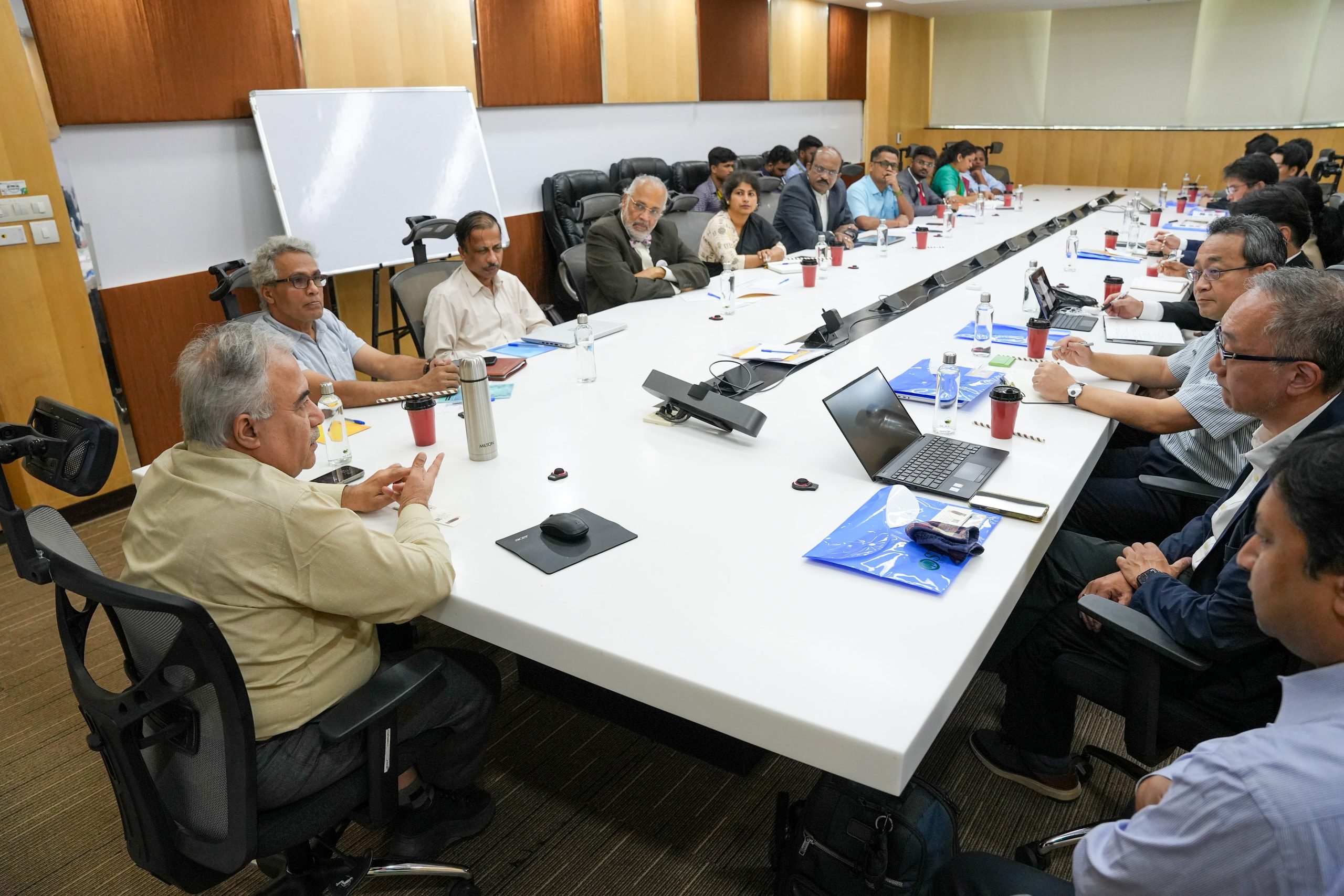 The Directorate of International Relations & Higher Studies welcomed the students and faculty from Tokyo University and Forum Engineering, Japan for “Discover India 2024 ” program
The Directorate of International Relations & Higher Studies welcomed the students and faculty from Tokyo University and Forum Engineering, Japan for “Discover India 2024 ” programInaugurated by the honorable Vice Chancellor of SRM University-AP, Prof. Manoj K Arora, Bharadhwaj Sivakumaran, Jatindra Kumar Dash, Jayaseelan Murugaiyan. Mr. Lakshmi Narasimhan Director (In-Charge) and Dr. Sudeshna Saha, Assistant Director of International Relations and Higher Studies, received the international students at the grand inaugural ceremony of the program. Students participated in various short courses on research area introduction (Electronic Cooling Lab), Mechanical Engineering Labs and Centre Visit (Electronic Cooling & Gold Centre) Presentations on Robotics, Additive Manufacturing & Bio Printing, Materials – Prof. G S Vinod Kumar HOD – Department of Mechanical.
A discussion was held with the IR & HS team and leadership team regarding various mobility programs, including Student and Faculty Exchange, Transfer Programs, Joint Research initiatives, and opportunities for mutual collaboration between Tokyo University and SRM University AP.
An interactive session was organized for Destination Japan students currently learning Japanese at SRM University AP, supported by SRM Global. Professors Tsutomu Iida and Kohei Soga delivered an engaging presentation on Tokai University, highlighting job and internship opportunities in Japan. The session provided a platform for Destination Japan students to interact with peers learning Japanese. Over 40 plus students actively participated, making the event a resounding success.
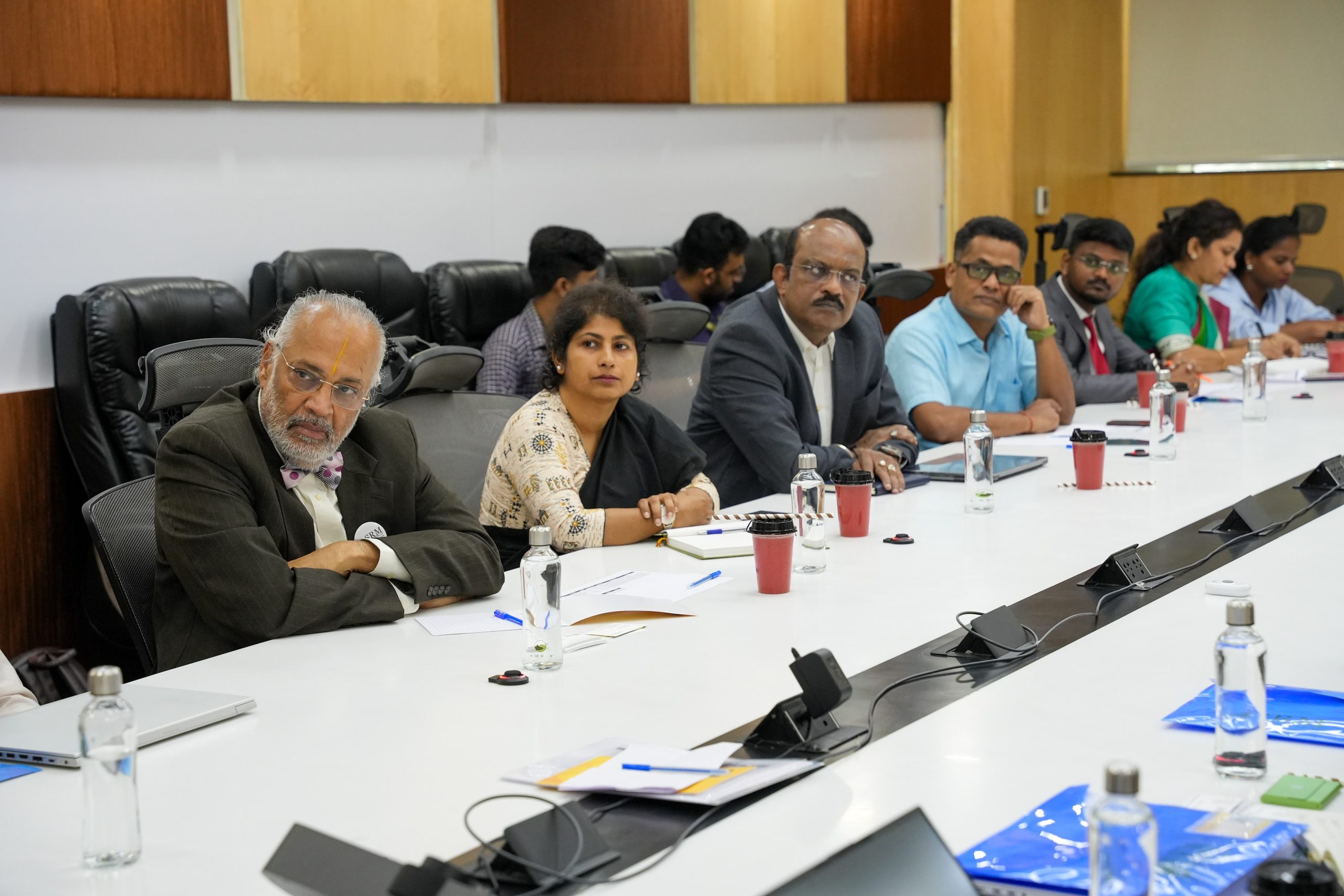
The industrial visit saw participation from a total of 13 members, including 2 professors, 2 staff members, and 4 students from Tokyo University and Forum Engineering, as well as 3 staff members and 2 students from SRM University AP. As part of the 3-day “Discover India” program, SRM University AP organized an industrial visit on August 22, 2024, for the Japanese delegation from Tokai University and Forum Engineering. The group visited the Industry Visit to Efftronics Systems Pvt. Ltd, Company work on 3 services like IOT services/ Customer services and product development services.
Professor and students have visited the product development services unit and understand the process development process and their experiences. We focus on idea generation to translate problems into solutions. We explore a wide variety and large quantity of ideas to go beyond the obvious solutions to a problem. We use a simple, economical cost and fast way to shape ideas, so you can experience and interact with them.
Continue reading → - Tokai University March 10, 2025
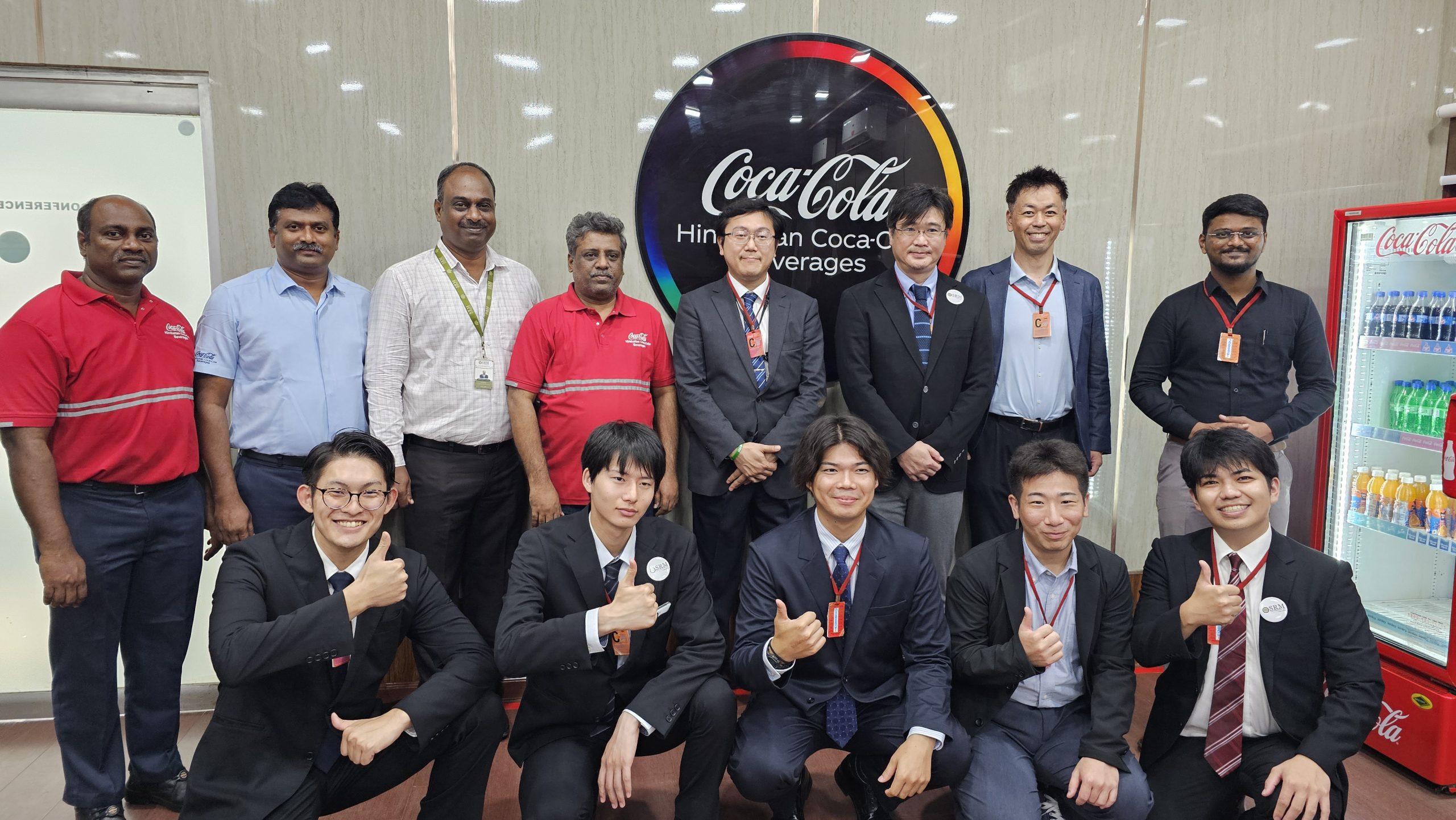 The Directorate of International Relations & Higher Studies organized a “Discover India 2024” program for professors and students from Tokai University and Forum Engineering, Japan. The 4-day programme conducted by the Directorate of International Relations and Higher Studies was inaugurated by the honourable Vice Chancellor of SRM University-AP, Prof. Manoj K Arora, Bharadhwaj Sivakumaran, Jatindra Kumar Dash, Jayaseelan Murugaiyan. “Discover India 2024” is a flagship initiative of the university to promote India’s cultural and knowledge traditions.
The Directorate of International Relations & Higher Studies organized a “Discover India 2024” program for professors and students from Tokai University and Forum Engineering, Japan. The 4-day programme conducted by the Directorate of International Relations and Higher Studies was inaugurated by the honourable Vice Chancellor of SRM University-AP, Prof. Manoj K Arora, Bharadhwaj Sivakumaran, Jatindra Kumar Dash, Jayaseelan Murugaiyan. “Discover India 2024” is a flagship initiative of the university to promote India’s cultural and knowledge traditions.Dr. Sudeshna Saha, Assistant Director of International Relations and Higher Studies, received the international students at the grand inaugural ceremony of the program. Students participated in various short courses on research area introduction (Electronic Cooling Lab), Mechanical Engineering Labs and Centre Visit (Electronic Cooling & Gold Centre) Presentations on Robotics, Additive Manufacturing & Bio Printing, Materials – Prof. G S Vinod Kumar HOD – Department of Mechanical.
A discussion was held with the IR & HS team and with the leadership team regarding various mobility programs, including Student and Faculty Exchange, Transfer Programs, Joint Research initiatives, and opportunities for mutual collaboration between Tokyo University and SRM University AP.
An interactive session was organized for Destination Japan students currently learning Japanese at SRM University AP, supported by SRM Global. Professors Kazuyoshi Tsuchiya and Tomoyuki Ikeda delivered an engaging presentation on Tokai University, highlighting job and internship opportunities in Japan. The session provided a platform for Destination Japan students to interact with peers learning Japanese. Over 47 students actively participated, making the event a resounding success.
The industrial visit saw participation from a total of 10 members, including 2 professors, 1 staff member, and 5 students from Tokai University and Forum Engineering, as well as 2 staff members from SRM University AP. As part of the “Discover India” program, SRM University AP organized an industrial visit on August 8, 2024, for the Japanese delegation from Tokai University and Forum Engineering. The group visited the Coca-Cola factory, where they first interacted with the head of the department and watched an instructional video outlining the guidelines and safety precautions for the tour.
Following this, the students were taken to the simulation room, where they observed the production process of Thumbs Up and other flavored beverages. They then toured various sections of the plant to see how different drinks are bottled and packed.
They also got to visit the famous landmarks of Vijayawada, such as the Dhyana Buddha statue, Prakasham Barrage, Vijayawada Kanaka Durga Temple etc.
Continue reading → - Alpine Secondary School March 10, 2025
SRM University-AP with its goal and vision of internationalization, also opens the door for the students who aspire to study in India. SRM AP being one of the known and finest universities in India would love to host students and staff across the globe. Its fascinating infrastructure, its globally accepted curriculum, its highly experienced faculties to its wider partnerships worldwide, give a magnificent opportunity to the students.
SRM University-AP welcomed the students and faculty of the Alpine Secondary School, Nepal to the rich cultural landscape of India through the Aadigyan – Summer Youth Program 2023. The 4-day program conducted by the Directorate of International Relations and Higher Studies was inaugurated by the honorable Vice Chancellor of SRM University-AP, Prof. Manoj K Arora, vishnupad mishra, Bharadhwaj Sivakumaran, Jatindra Kumar Dash, Jayaseelan Murugaiyan, Dr. Tousif Khan N, SMIEEE, MIE Dr.Srabani Basu Sidharth Tripathy, Mahesh Kumar Ravva, Ranjit Thapa
Ms. Adity Jain, Director of International Relations and Higher Studies, received the international students at the grand inaugural ceremony of the program. Students participated in various short courses on Future Prospects and Introduction Unraveling Future Pathways – Dr. Tousif Khan, HOD – EEE, Walk with the Scientist – Prof Jayaseelan Assoc Dean, SEAS-Sciences, Liberal Arts Unveiled: Navigating Future Avenues – Dr Srabani Basu, HOD – English, Business Insight: Today and Beyond – Prof A V S Kamesh, PSB, Building a Billion $ Company before you turn 18 – Mr Siddharth Tripathi Director – Entrepreneurship, Power of Habits – By Shri. Kirti Gopal Das, ISKCON, Taiwan Education Center Activity – Ms. Michelle Huang Taiwan.
They also got to visit the famous landmarks of Vijayawada, such as the Dhyana Buddha statue, Prakasham Barrage, Bhavani Island, etc. They have participated in Outdoor and Indoor Games with International Students.
Students interacted with many industry experts as they visited Hindustan Coca-Cola Beverages Pvt Ltd. Which gave them insights into the current trends and new technologies. The program also included interaction with the 160+ International students of SRM AP from more than 29 countries.
Continue reading →
The program ended on 21st Feb to 24th Feb 2024, with a valedictory session and facilitating faculty and students of Alpine Secondary School, Nepal. - Decimal College, Nepal March 10, 2025
SRM University-AP with its goal and vision of internationalization, also opens the door for the students who aspire to study in India. SRM AP being one of the known and finest universities in India would love to host students and staff across the globe. Its fascinating infrastructure, its globally accepted curriculum, its highly experienced faculties to its wider partnerships worldwide, give a magnificent opportunity to the students.
SRM University-AP welcomed the students and faculty of the Decimal College, Nepal to the rich cultural landscape of India through the Aadigyan – Summer Youth Program 2023. The 2 days program conducted by the Directorate of International Relations and Higher Studies was inaugurated by the honorable Vice Chancellor of SRM University-AP, Prof. Manoj K Arora,Bharadhwaj Sivakumaran, Jatindra Kumar Dash, Jayaseelan Murugaiyan.
The program ended on 26-Oct-23 & 27-Oct-23, with a valedictory session and facilitating faculty and students of Alpine Secondary School, Nepal. Director of International Relations and Higher Studies, received the international students at the grand inaugural ceremony of the program. Students participated in various short courses on Future Prospects and Introduction. Session.
Session by School of Science Faculty “Unveiling the World of Possibilities: Your Journey in Science at SRM University AP”. Session by Paari School of Business Faculty “Leadership and Innovation: Shaping Tomorrow’s Business World at SRM University AP”.
Session by International Relations & Highers Studies Department ” Global Horizons: Exploring International Opportunities and Higher Studies at SRM University AP. By School of Engineering Faculty”Exploring Your Academic Path: Engineering and Beyond at SRM University AP” and Art and Craft Workshop.
Students interacted with many industry experts as they visited Hindustan Coca-Cola Beverages Pvt Ltd. Which gave them insights into the current trends and new technologies. The program also included interaction with the 160+ International students of SRM AP from more than 29 countries.
Continue reading → - National Infotech College, Nepal March 10, 2025
SRM University-AP with its goal and vision of internationalisation, also opens the door for the students who aspire to study in India. SRM AP being one of the known and finest universities in India would love to host students and staff across the globe. Its fascinating infrastructure, its globally accepted curriculum, its highly experienced faculties to its wider partnerships worldwide, give a magnificent opportunity to the students.
SRM University-AP welcomed the students and faculty of the National Infotech College, Nepal to the rich cultural landscape of India through the Aadigyan – Summer Youth Programme 2023. The 4-day programme conducted by the Directorate of International Relations and Higher Studies was inaugurated by the honourable Vice Chancellor of SRM University-AP, Prof. Manoj K Arora. Aadigyan is a flagship initiative of the university to promote India’s cultural and knowledge traditions.
Dr Naga Swetha Pasupuleti, Director of International Relations and Higher Studies, received the international students at the grand inaugural ceremony of the programme. Students participated in various short courses on Future Prospects and Introduction -School of Liberal Arts, Introduction to Engineering Programs & Its Future Prospects – Dr Jatindra Dash, CSE Dr Ashu Abdul, CSE Prof. Prakash Jadhav, ME Dr Bhagat, Civil, Introduction to Business Studies & Its Future Prospects – Dr Kamesh.
They also got to visit the famous landmarks of Vijayawada, such as the Dhyana Buddha statue, Prakasham Barrage, Bhavani Island, etc. They have participated in Cricket / Football matches with on-campus International Students.
Students interacted with many industry experts as they visited Efftronics Systems Pvt Ltd, APIIC IT Park, Mangala Giri. Which gave them insights into the current trends and new technologies. The programme also included interaction with the 160+ International students of SRM AP from more than 29 countries.
The programme ended on Aug 04 to 07, 2023, with a valedictory session and facilitating faculty and students of National Infotech College, Nepal.
Continue reading →


